

How to Write a Memoir: Examples and a Step-by-Step Guide
Zining Mok | January 29, 2024 | 25 Comments
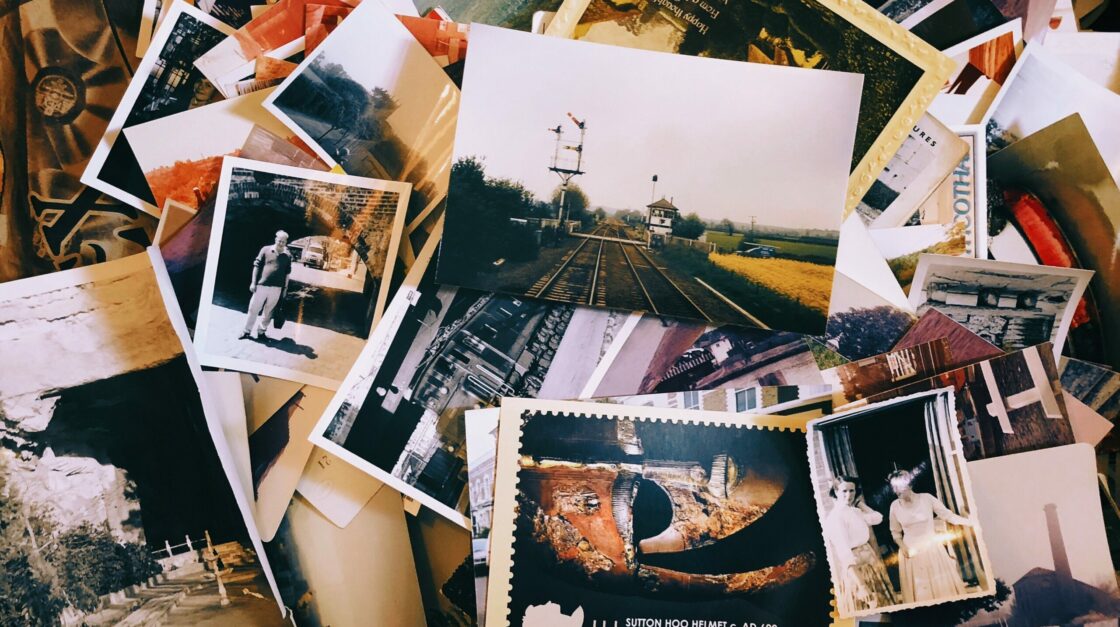
If you’ve thought about putting your life to the page, you may have wondered how to write a memoir. We start the road to writing a memoir when we realize that a story in our lives demands to be told. As Maya Angelou once wrote, “There is no greater agony than bearing an untold story inside you.”
How to write a memoir? At first glance, it looks easy enough—easier, in any case, than writing fiction. After all, there is no need to make up a story or characters, and the protagonist is none other than you.
Still, memoir writing carries its own unique challenges, as well as unique possibilities that only come from telling your own true story. Let’s dive into how to write a memoir by looking closely at the craft of memoir writing, starting with a key question: exactly what is a memoir?
How to Write a Memoir: Contents
What is a Memoir?
- Memoir vs Autobiography
Memoir Examples
Short memoir examples.
- How to Write a Memoir: A Step-by-Step Guide
A memoir is a branch of creative nonfiction , a genre defined by the writer Lee Gutkind as “true stories, well told.” The etymology of the word “memoir,” which comes to us from the French, tells us of the human urge to put experience to paper, to remember. Indeed, a memoir is “ something written to be kept in mind .”
A memoir is defined by Lee Gutkind as “true stories, well told.”
For a piece of writing to be called a memoir, it has to be:
- Nonfictional
- Based on the raw material of your life and your memories
- Written from your personal perspective
At this point, memoirs are beginning to sound an awful lot like autobiographies. However, a quick comparison of Elizabeth Gilbert’s Eat, Pray, Love , and The Autobiography of Benjamin Franklin , for example, tells us that memoirs and autobiographies could not be more distinct.
Next, let’s look at the characteristics of a memoir and what sets memoirs and autobiographies apart. Discussing memoir vs. autobiography will not only reveal crucial insights into the process of writing a memoir, but also help us to refine our answer to the question, “What is a memoir?”
Memoir vs. Autobiography
While both use personal life as writing material, there are five key differences between memoir and autobiography:
1. Structure
Since autobiographies tell the comprehensive story of one’s life, they are more or less chronological. writing a memoir, however, involves carefully curating a list of personal experiences to serve a larger idea or story, such as grief, coming-of-age, and self-discovery. As such, memoirs do not have to unfold in chronological order.
While autobiographies attempt to provide a comprehensive account, memoirs focus only on specific periods in the writer’s life. The difference between autobiographies and memoirs can be likened to that between a CV and a one-page resume, which includes only select experiences.
The difference between autobiographies and memoirs can be likened to that between a CV and a one-page resume, which includes only select experiences.
Autobiographies prioritize events; memoirs prioritize the writer’s personal experience of those events. Experience includes not just the event you might have undergone, but also your feelings, thoughts, and reflections. Memoir’s insistence on experience allows the writer to go beyond the expectations of formal writing. This means that memoirists can also use fiction-writing techniques , such as scene-setting and dialogue , to capture their stories with flair.
4. Philosophy
Another key difference between the two genres stems from the autobiography’s emphasis on facts and the memoir’s reliance on memory. Due to memory’s unreliability, memoirs ask the reader to focus less on facts and more on emotional truth. In addition, memoir writers often work the fallibility of memory into the narrative itself by directly questioning the accuracy of their own memories.
Memoirs ask the reader to focus less on facts and more on emotional truth.
5. Audience
While readers pick up autobiographies to learn about prominent individuals, they read memoirs to experience a story built around specific themes . Memoirs, as such, tend to be more relatable, personal, and intimate. Really, what this means is that memoirs can be written by anybody!
Ready to be inspired yet? Let’s now turn to some memoir examples that have received widespread recognition and captured our imaginations!
If you’re looking to lose yourself in a book, the following memoir examples are great places to begin:
- The Year of Magical Thinking , which chronicles Joan Didion’s year of mourning her husband’s death, is certainly one of the most powerful books on grief. Written in two short months, Didion’s prose is urgent yet lucid, compelling from the first page to the last. A few years later, the writer would publish Blue Nights , another devastating account of grief, only this time she would be mourning her daughter.
- Patti Smith’s Just Kids is a classic coming-of-age memoir that follows the author’s move to New York and her romance and friendship with the artist Robert Maplethorpe. In its pages, Smith captures the energy of downtown New York in the late sixties and seventies effortlessly.
- When Breath Becomes Air begins when Paul Kalanithi, a young neurosurgeon, is diagnosed with terminal cancer. Exquisite and poignant, this memoir grapples with some of the most difficult human experiences, including fatherhood, mortality, and the search for meaning.
- A memoir of relationship abuse, Carmen Maria Machado’s In the Dream House is candid and innovative in form. Machado writes about thorny and turbulent subjects with clarity, even wit. While intensely personal, In the Dream House is also one of most insightful pieces of cultural criticism.
- Twenty-five years after leaving for Canada, Michael Ondaatje returns to his native Sri Lanka to sort out his family’s past. The result is Running in the Family , the writer’s dazzling attempt to reconstruct fragments of experiences and family legends into a portrait of his parents’ and grandparents’ lives. (Importantly, Running in the Family was sold to readers as a fictional memoir; its explicit acknowledgement of fictionalization prevented it from encountering the kind of backlash that James Frey would receive for fabricating key facts in A Million Little Pieces , which he had sold as a memoir . )
- Of the many memoirs published in recent years, Tara Westover’s Educated is perhaps one of the most internationally-recognized. A story about the struggle for self-determination, Educated recounts the writer’s childhood in a survivalist family and her subsequent attempts to make a life for herself. All in all, powerful, thought-provoking, and near impossible to put down.
While book-length memoirs are engaging reads, the prospect of writing a whole book can be intimidating. Fortunately, there are plenty of short, essay-length memoir examples that are just as compelling.
While memoirists often write book-length works, you might also consider writing a memoir that’s essay-length. Here are some short memoir examples that tell complete, lived stories, in far fewer words:
- “ The Book of My Life ” offers a portrait of a professor that the writer, Aleksandar Hemon, once had as a child in communist Sarajevo. This memoir was collected into Hemon’s The Book of My Lives , a collection of essays about the writer’s personal history in wartime Yugoslavia and subsequent move to the US.
- “The first time I cheated on my husband, my mother had been dead for exactly one week.” So begins Cheryl Strayed’s “ The Love of My Life ,” an essay that the writer eventually expanded into the best-selling memoir, Wild: From Lost to Found on the Pacific Crest Trail .
- In “ What We Hunger For ,” Roxane Gay weaves personal experience and a discussion of The Hunger Games into a powerful meditation on strength, trauma, and hope. “What We Hunger For” can also be found in Gay’s essay collection, Bad Feminist .
- A humorous memoir structured around David Sedaris and his family’s memories of pets, “ The Youth in Asia ” is ultimately a story about grief, mortality and loss. This essay is excerpted from the memoir Me Talk Pretty One Day , and a recorded version can be found here .
So far, we’ve 1) answered the question “What is a memoir?” 2) discussed differences between memoirs vs. autobiographies, 3) taken a closer look at book- and essay-length memoir examples. Next, we’ll turn the question of how to write a memoir.
How to Write a Memoir: A-Step-by-Step Guide
1. how to write a memoir: generate memoir ideas.
how to start a memoir? As with anything, starting is the hardest. If you’ve yet to decide what to write about, check out the “ I Remember ” writing prompt. Inspired by Joe Brainard’s memoir I Remember , this prompt is a great way to generate a list of memories. From there, choose one memory that feels the most emotionally charged and begin writing your memoir. It’s that simple! If you’re in need of more prompts, our Facebook group is also a great resource.
2. How to Write a Memoir: Begin drafting
My most effective advice is to resist the urge to start from “the beginning.” Instead, begin with the event that you can’t stop thinking about, or with the detail that, for some reason, just sticks. The key to drafting is gaining momentum . Beginning with an emotionally charged event or detail gives us the drive we need to start writing.
3. How to Write a Memoir: Aim for a “ shitty first draft ”
Now that you have momentum, maintain it. Attempting to perfect your language as you draft makes it difficult to maintain our impulses to write. It can also create self-doubt and writers’ block. Remember that most, if not all, writers, no matter how famous, write shitty first drafts.
Attempting to perfect your language as you draft makes it difficult to maintain our impulses to write.
4. How to Write a Memoir: Set your draft aside
Once you have a first draft, set it aside and fight the urge to read it for at least a week. Stephen King recommends sticking first drafts in your drawer for at least six weeks. This period allows writers to develop the critical distance we need to revise and edit the draft that we’ve worked so hard to write.
5. How to Write a Memoir: Reread your draft
While reading your draft, note what works and what doesn’t, then make a revision plan. While rereading, ask yourself:
- What’s underdeveloped, and what’s superfluous.
- Does the structure work?
- What story are you telling?
6. How to Write a Memoir: Revise your memoir and repeat steps 4 & 5 until satisfied
Every piece of good writing is the product of a series of rigorous revisions. Depending on what kind of writer you are and how you define a draft,” you may need three, seven, or perhaps even ten drafts. There’s no “magic number” of drafts to aim for, so trust your intuition. Many writers say that a story is never, truly done; there only comes a point when they’re finished with it. If you find yourself stuck in the revision process, get a fresh pair of eyes to look at your writing.
7. How to Write a Memoir: Edit, edit, edit!
Once you’re satisfied with the story, begin to edit the finer things (e.g. language, metaphor , and details). Clean up your word choice and omit needless words , and check to make sure you haven’t made any of these common writing mistakes . Be sure to also know the difference between revising and editing —you’ll be doing both. Then, once your memoir is ready, send it out !
Learn How to Write a Memoir at Writers.com
Writing a memoir for the first time can be intimidating. But, keep in mind that anyone can learn how to write a memoir. Trust the value of your own experiences: it’s not about the stories you tell, but how you tell them. Most importantly, don’t give up!
Anyone can learn how to write a memoir.
If you’re looking for additional feedback, as well as additional instruction on how to write a memoir, check out our schedule of nonfiction classes . Now, get started writing your memoir!
25 Comments
Thank you for this website. It’s very engaging. I have been writing a memoir for over three years, somewhat haphazardly, based on the first half of my life and its encounters with ignorance (religious restrictions, alcohol, and inability to reach out for help). Three cities were involved: Boston as a youngster growing up and going to college, then Washington DC and Chicago North Shore as a married woman with four children. I am satisfied with some chapters and not with others. Editing exposes repetition and hopefully discards boring excess. Reaching for something better is always worth the struggle. I am 90, continue to be a recital pianist, a portrait painter, and a writer. Hubby has been dead for nine years. Together we lept a few of life’s chasms and I still miss him. But so far, my occupations keep my brain working fairly well, especially since I don’t smoke or drink (for the past 50 years).
Hi Mary Ellen,
It sounds like a fantastic life for a memoir! Thank you for sharing, and best of luck finishing your book. Let us know when it’s published!
Best, The writers.com Team
Hello Mary Ellen,
I am contacting you because your last name (Lavelle) is my middle name!
Being interested in genealogy I have learned that this was my great grandfathers wife’s name (Mary Lavelle), and that her family emigrated here about 1850 from County Mayo, Ireland. That is also where my fathers family came from.
Is your family background similar?
Hope to hear back from you.
Richard Lavelle Bourke
Hi Mary Ellen: Have you finished your memoir yet? I just came across your post and am seriously impressed that you are still writing. I discovered it again at age 77 and don’t know what I would do with myself if I couldn’t write. All the best to you!! Sharon [email protected]
I am up to my eyeballs with a research project and report for a non-profit. And some paid research for an international organization. But as today is my 90th birthday, it is time to retire and write a memoir.
So I would like to join a list to keep track of future courses related to memoir / creative non-fiction writing.
Hi Frederick,
Happy birthday! And happy retirement as well. I’ve added your name and email to our reminder list for memoir courses–when we post one on our calendar, we’ll send you an email.
We’ll be posting more memoir courses in the near future, likely for the months of January and February 2022. We hope to see you in one!
Very interesting and informative, I am writing memoirs from my long often adventurous and well travelled life, have had one very short story published. Your advice on several topics will be extremely helpful. I write under my schoolboy nickname Barnaby Rudge.
[…] How to Write a Memoir: Examples and a Step-by-Step Guide […]
I am writing my memoir from my memory when I was 5 years old and now having left my birthplace I left after graduation as a doctor I moved to UK where I have been living. In between I have spent 1 year in Canada during my training year as paediatrician. I also spent nearly 2 years with British Army in the hospital as paediatrician in Germany. I moved back to UK to work as specialist paediatrician in a very busy general hospital outside London for the next 22 years. Then I retired from NHS in 2012. I worked another 5 years in Canada until 2018. I am fully retired now
I have the whole convoluted story of my loss and horrid aftermath in my head (and heart) but have no clue WHERE, in my story to begin. In the middle of the tragedy? What led up to it? Where my life is now, post-loss, and then write back and forth? Any suggestions?
My friend Laura who referred me to this site said “Start”! I say to you “Start”!
Hi Dee, that has been a challenge for me.i dont know where to start?
What was the most painful? Embarrassing? Delicious? Unexpected? Who helped you? Who hurt you? Pick one story and let that lead you to others.
I really enjoyed this writing about memoir. I ve just finished my own about my journey out of my city then out of my country to Egypt to study, Never Say Can’t, God Can Do It. Infact memoir writing helps to live the life you are writing about again and to appreciate good people you came across during the journey. Many thanks for sharing what memoir is about.
I am a survivor of gun violence, having witnessed my adult son being shot 13 times by police in 2014. I have struggled with writing my memoir because I have a grandson who was 18-months old at the time of the tragedy and was also present, as was his biological mother and other family members. We all struggle with PTSD because of this atrocity. My grandson’s biological mother was instrumental in what happened and I am struggling to write the story in such a way as to not cast blame – thus my dilemma in writing the memoir. My grandson was later adopted by a local family in an open adoption and is still a big part of my life. I have considered just writing it and waiting until my grandson is old enough to understand all the family dynamics that were involved. Any advice on how I might handle this challenge in writing would be much appreciated.
I decided to use a ghost writer, and I’m only part way in the process and it’s worth every penny!
Hi. I am 44 years old and have had a roller coaster life .. right as a young kid seeing his father struggle to financial hassles, facing legal battles at a young age and then health issues leading to a recent kidney transplant. I have been working on writing a memoir sharing my life story and titled it “A memoir of growth and gratitude” Is it a good idea to write a memoir and share my story with the world?
Thank you… this was very helpful. I’m writing about the troubling issues of my mental health, and how my life was seriously impacted by that. I am 68 years old.
[…] Writers.com: How to Write a Memoir […]
[…] Writers.com: “How to Write a Memoir” […]
I am so grateful that I found this site! I am inspired and encouraged to start my memoir because of the site’s content and the brave people that have posted in the comments.
Finding this site is going into my gratitude journey 🙂
We’re grateful you found us too, Nichol! 🙂
Firstly, I would like to thank you for all the info pertaining to memoirs. I believe am on the right track, am at the editing stage and really have to use an extra pair of eyes. I’m more motivated now to push it out and complete it. Thanks for the tips it was very helpful, I have a little more confidence it seeing the completion.
Well, I’m super excited to begin my memoir. It’s hard trying to rely on memories alone, but I’m going to give it a shot!
Thanks to everyone who posted comments, all of which have inspired me to get on it.
Best of luck to everyone! Jody V.
I was thrilled to find this material on How to Write A Memoir. When I briefly told someone about some of my past experiences and how I came to the United States in the company of my younger brother in a program with a curious name, I was encouraged by that person and others to write my life history.
Based on the name of that curious program through which our parents sent us to the United States so we could leave the place of our birth, and be away from potentially difficult situations in our country.
As I began to write my history I took as much time as possible to describe all the different steps that were taken. At this time – I have been working on this project for 5 years and am still moving ahead. The information I received through your material has further encouraged me to move along. I am very pleased to have found this important material. Thank you!
Leave a Comment Cancel Reply
Save my name, email, and website in this browser for the next time I comment.

18 Essay-Length Short Memoirs to Read Online on Your Lunch Break
Emily Polson
Emily Polson is a freelance writer and publishing assistant at Simon & Schuster. Originally from central Iowa, she studied English and creative writing at Belhaven University in Jackson, Mississippi, before moving to a small Basque village to teach English to trilingual teenagers. Now living in Brooklyn, she can often be found meandering through Prospect Park listening to a good audiobook. Twitter: @emilycpolson | https://emilycpolson.wordpress.com/
View All posts by Emily Polson
I love memoirs and essays, so the genre of essay-length short memoirs is one of my favorites. I love delving into the details of other people’s lives. The length allows me to read broadly on a whim with minimal commitment. In roughly 5–30 minutes, I can consume a complete morsel of literature, which always leaves me happier than the same amount of time spent doom-scrolling through my various social news feeds.
What are short memoirs?
What exactly are short memoirs? I define them as essay-length works that weave together life experiences around a central theme. You see examples of short memoirs all the time on sites like Buzzfeed and The New York Times . Others are stand-alone pieces published in essay collections.
Memoir essays were my gateway into reading full-length memoirs. It was not until I took a college class on creative nonfiction that I realized memoirs were not just autobiographies of people with exciting lives. Anyone with any amount of life experience can write a memoir—no dramatic childhood or odd-defying life accomplishments required. A short memoir might be an account of a single, life-changing event, or it may be reflection on a period of growth or transition.
Of course, when a young adult tells people she likes writing creative nonfiction—not journalism or technical writing—she hears a lot of, “You’re too young to write a memoir!” and “What could someone your age possibly have to write about?!” As Flannery O’Connor put it, however, “The fact is that anybody who has survived his childhood has enough information about life to last him the rest of his days. If you can’t make something out of a little experience, you probably won’t be able to make it out of a lot. The writer’s business is to contemplate experience, not to be merged in it.”
Memoir essay examples
As the lit magazine Creative Nonfiction puts it, personal essays are just “True stories, well told.” And everyone has life stories worth telling.
Here are a few of my favorite memoir examples that are essay length.
SHORT MEMOIRS ABOUT GROWING UP
Scaachi koul, “there’s no recipe for growing up”.
In this delightful essay, Koul talks about trying to learn the secrets of her mother’s Kashmiri cooking after growing up a first-generation American. The story is full of vivid descriptions and anecdotal details that capture something so specific it transcends to the realm of universal. It’s smart, it’s funny, and it’ll break your heart a little as Koul describes “trying to find my mom at the bottom of a 20-quart pot.”
ASHLEY C. FORD, “THE YEAR I GREW WILDLY WHILE MEN LOOKED ON”
This memoir essay is for all the girls who went through puberty early in a world that sexualizes children’s bodies. Ford weaves together her experiences of feeling at odds with her body, of being seen as a “distraction” to adult men, of being Black and fatherless and hungry for love. She writes, “It was evident that who I was inside, who I wanted to be, didn’t match the intentions of my body. Outside, there was no little girl to be loved innocently. My body was a barrier.”
Kaveh Akbar, “How I Found Poetry in Childhood Prayer”
Akbar writes intense, searing poetry, but this personal essay contextualizes one of his sweetest poems, “Learning to Pray,” which is cradled in the middle of it. He describes how he fell in love with the movement, the language, and the ceremony of his Muslim family’s nightly prayers. Even though he didn’t (and doesn’t) speak Arabic, Akbar points to the musicality of these phonetically-learned hymns as “the bedrock upon which I’ve built my understanding of poetry as a craft and as a meditative practice.” Reading this essay made me want to reread his debut poetry collection, Calling a Wolf a Wolf , all over again.
JIA TOLENTINO, “LOSING RELIGION AND FINDING ECSTASY IN HOUSTON”
New Yorker staff writer Jia Tolentino grew up attending a Houston megachurch she referred to as “the Repentagon.” In this personal essay, she describes vivid childhood memories of her time there, discussing how some of the very things she learned from the church contributed to her growing ambivalence toward it and its often hypocritical congregants. “Christianity formed my deepest instincts,” she writes, “and I have been walking away from it for half my life.” As the essay title suggests, this walking away coincided with her early experiences taking MDMA, which offered an uncanny similarity to her experience of religious devotion.
funny short memoirs
Patricia lockwood, “insane after coronavirus”.
Author Patricia Lockwood caught COVID-19 in early March 2020. In addition to her physical symptoms, she chronicled the bizarre delusions she experienced while society also collectively operated under the delusion that this whole thing would blow over quickly. Lockwood has a preternatural ability to inject humor into any situation, even the dire ones, by highlighting choice absurdities. This is a rare piece of pandemic writing that will make you laugh instead of cry–unless it makes you cry from laughing.
Harrison Scott Key, “My Dad Tried to Kill Me with an Alligator”
This personal essay is a tongue-in-cheek story about the author’s run-in with an alligator on the Pearl River in Mississippi. Looking back on the event as an adult, Key considers his father’s tendencies in light of his own, now that he himself is a dad. He explores this relationship further in his book-length memoir, The World’s Largest Man , but this humorous essay stands on its own. (I also had the pleasure of hearing him read this aloud during my school’s homecoming weekend, as Key is an alumnus of my alma mater.)
David Sedaris, “Me Talk Pretty One Day”
Sedaris’s humor is in a league of its own, and he’s at his best in the title essay from Me Talk Pretty One Day . In it, he manages to capture the linguistic hilarities that ensue when you combine a sarcastic, middle-aged French student with a snarky French teacher.
SAMANTHA IRBY, “THE WORST FRIEND DATE I EVER HAD”
Samantha Irby is one of my favorite humorists writing today, and this short memoir essay about the difficulty of making friends as an adult is a great introduction to her. Be prepared for secondhand cringe when you reach the infamous moment she asks a waiter, “Are you familiar with my work?” After reading this essay, you’ll want to be, so check out Wow, No Thank You . next.
Bill Bryson, “Coming Home”
Bryson has the sly, subtle humor that only comes from Americans who have spent considerable time living among dry-humored Brits. In “Coming Home,” he talks about the strange sensation of returning to America after spending his first twenty years of adulthood in England. This personal essay is the first in a book-length work called I’m a Stranger Here Myself , in which Bryson revisits American things that feel like novelties to outsiders and the odd former expat like himself.
Thought-provoking Short memoirs
Tommy orange, “how native american is native american enough”.
Many people claim some percentage of Indigenous ancestry, but how much is enough to “count”? Novelist Tommy Orange–author of There There –deconstructs this concept, discussing his relationship to his Native father, his Certificate of Degree of Indian Blood, and his son, who will not be considered “Native enough” to join him as an enrolled member of the Cheyenne and Arapaho Tribes. “ How come math isn’t taught with stakes?” he asks in this short memoir full of lingering questions that will challenge the way you think about heritage.
Christine Hyung-Oak Lee, “I Had a Stroke at 33”
Lee’s story is interesting not just because she had a stroke at such a young age, but because of how she recounts an experience that was characterized by forgetting. She says that after her stroke, “For a month, every moment of the day was like the moment upon wakening before you figure out where you are, what time it is.” With this personal essay, she draws readers into that fragmented headspace, then weaves something coherent and beautiful from it.
Kyoko Mori, “A Difficult Balance: Am I a Writer or a Teacher?”
In this refreshing essay, Mori discusses balancing “the double calling” of being a writer and a teacher. She admits that teaching felt antithetical to her sense of self when she started out in a classroom of apathetic college freshmen. When she found her way into teaching an MFA program, however, she discovered that fostering a sanctuary for others’ words and ideas felt closer to a “calling.” While in some ways this makes the balance of shifting personas easier, she says it creates a different kind of dread: “Teaching, if it becomes more than a job, might swallow me whole and leave nothing for my life as a writer.” This memoir essay is honest, well-structured, and layered with plenty of anecdotal details to draw in the reader.
Alex Tizon, “My Family’s Slave”
In this heartbreaking essay, Tizon pays tribute to the memory of Lola, the domestic slave who raised him and his siblings. His family brought her with them when they emigrated to America from the Philippines. He talks about the circumstances that led to Lola’s enslavement, the injustice she endured throughout her life, and his own horror at realizing the truth about her role in his family as he grew up. While the story is sad enough to make you cry, there are small moments of hope and redemption. Alex discusses what he tried to do for Lola as an adult and how, upon her death, he traveled to her family’s village to return her ashes.
Classic short memoirs
James baldwin, “notes of a native son”.
This memoir essay comes from Baldwin’s collection of the same name. In it, he focuses on his relationship with his father, who died when Baldwin was 19. He also wrestles with growing up black in a time of segregation, touching on the historical treatment of black soldiers and the Harlem Riot of 1943. His vivid descriptions and honest narration draw you into his transition between frustration, hatred, confusion, despair, and resilience.
JOAN DIDION, “GOODBYE TO ALL THAT”
Didion is one of the foremost literary memoirists of the twentieth century, combining journalistic precision with self-aware introspection. In “Goodbye to All That,” Didion recounts moving to New York as a naïve 20-year-old and leaving as a disillusioned 28-year-old. She captures the mystical awe with which outsiders view the Big Apple, reflecting on her youthful perspective that life was still limitless, “that something extraordinary would happen any minute, any day, any month.” This essay concludes her masterful collection, Slouching Towards Bethlehem .
Tim O’Brien, “The Things They Carried”
This is the title essay from O’Brien’s collection, The Things They Carried . It’s technically labeled a work of fiction, but because the themes and anecdotes are pulled from O’Brien’s own experience in the Vietnam War, it blurs the lines between fact and fiction enough to be included here. (I’m admittedly predisposed to this classification because a college writing professor of mine included it on our creative nonfiction syllabus.) The essay paints an intimate portrait of a group of soldiers by listing the things they each carry with them, both physical and metaphorical. It contains one of my favorite lines in all of literature: “They all carried ghosts.”
Multi-Media Short Memoirs
Allie brosh, “richard”.
In this blog post/webcomic, Allie Brosh tells the hilarious story about the time as a child that she, 1) realized neighbors exist, and 2) repeatedly snuck into her neighbor’s house, took his things, and ultimately kidnapped his cat. Her signature comic style drives home the humor in a way that will split your sides. The essay is an excerpt from Brosh’s second book, Solutions and Other Problems , but the web version includes bonus photos and backstory. For even more Allie classics, check out “Adventures in Depression” and “Depression Part Two.”
George Watsky, “Ask Me What I’m Doing Tonight”
Watsky is a rapper and spoken word poet who built his following on YouTube. Before he made it big, however, he spent five years performing for groups of college students across the Midwest. “Ask Me What I’m Doing Tonight!” traces that soul-crushing monotony while telling a compelling story about trying to connect with people despite such transience. It’s the most interesting essay about boredom you’ll ever read, or in this case watch—he filmed a short film version of the essay for his YouTube channel. Like his music, Watsky’s personal essays are vulnerable, honest, and crude, and the whole collection, How to Ruin Everything , is worth reading.
If you’re looking for even more short memoirs, keep an eye on these pages from Literary Hub , Buzzfeed , and Creative Nonfiction . You can also delve into these 25 nonfiction essays you can read online and these 100 must-read essay collections . Also be sure to check out the “Our Reading Lives” tag right here on Book Riot, where you’ll find short memoirs like “Searching for Little Free Libraries as a Way to Say Goodbye” and “How I Overcame My Fear of Reading Contemporary Poets.”
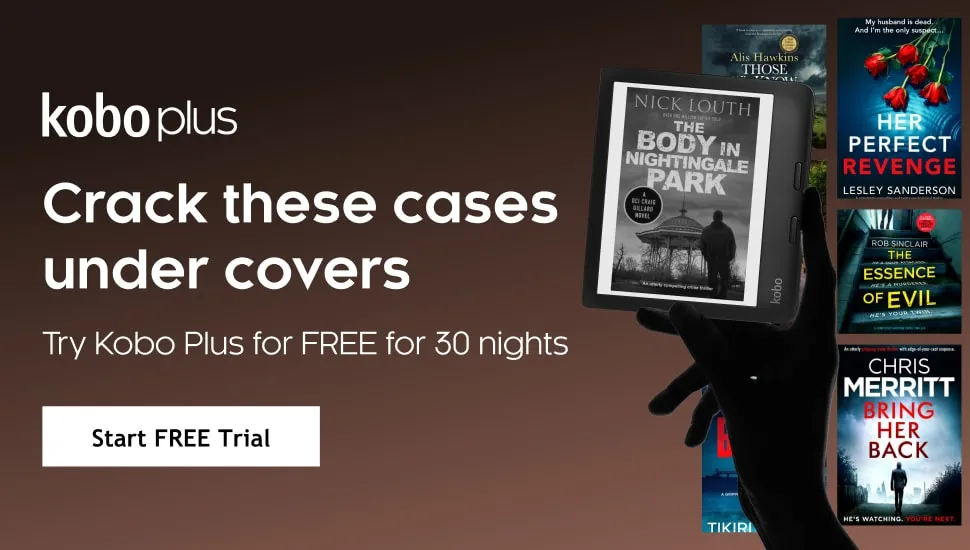
You Might Also Like

Become a Bestseller
Follow our 5-step publishing path.
Fundantals of Fiction & Story
Bring your story to life with a proven plan.
Market Your Book
Learn how to sell more copies.
Edit Your Book
Get professional editing support.
Author Advantage Accelerator Nonfiction
Grow your business, authority, and income.
Author Advantage Accelerator Fiction
Become a full-time fiction author.
Author Accelerator Elite
Take the fast-track to publishing success.
Take the Quiz
Let us pair you with the right fit.
Free Copy of Published.
Book title generator, nonfiction outline template, writing software quiz, book royalties calculator.
Learn how to write your book
Learn how to edit your book
Learn how to self-publish your book
Learn how to sell more books
Learn how to grow your business
Learn about self-help books
Learn about nonfiction writing
Learn about fiction writing
How to Get An ISBN Number
A Beginner’s Guide to Self-Publishing
How Much Do Self-Published Authors Make on Amazon?
Book Template: 9 Free Layouts
How to Write a Book in 12 Steps
The 15 Best Book Writing Software Tools
31 Memoir Examples That Offer a Thought-Provoking Read
POSTED ON Aug 29, 2023

Written by Sarah Rexford
As an aspiring author, it's likely you're an avid reader. And, if you already have dreams of sharing your story with the world, it's important to read and learn from other memoir examples that have resonated with readers.
But we don't suggest just picking up any book.
If you want to learn how to write a memoir, we recommend checking out a book that has been written by an author with whom you have a shared lived experience, who has a similar style or writing tone to your own, or who writes about a similar topic. While the intention is never to copy someone else's work, reading memoirs that might show up in the same category as yours could be immensely helpful.
Here are the thought-provoking memoir examples:
While reading, take note of how vulnerable the author gets, how much they share, how they relate to the reader, what details impact you the most, and what about the delivery makes it so moving.
Our top 31 memoir examples
From famous best-sellers to the lesser-known reads on this list, the following memoir examples include common universal literary themes, very intimate glimpses into the writers' lives, hard-earned life lessons, and a variety of topics and tones to inspire your own memorable memoir.
1. I Know Why The Caged Bird Sings by Maya Angelou
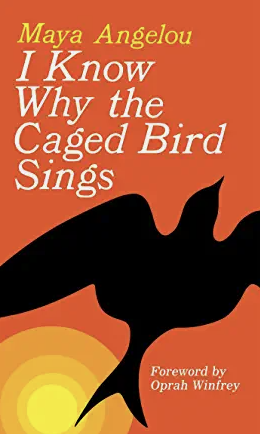
This is a classic memoir example – one that captures childhood, pain, and longing in all its nuanced forms.
2. The Glass Castle by Jeanette Walls
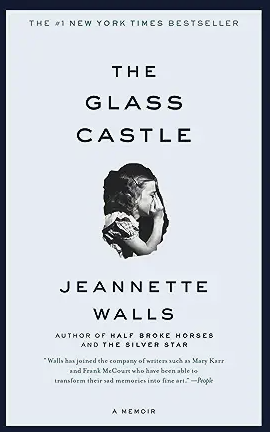
Resilience and redemption co-star in this bestseller about Jeanette Walls’ life.
3. The Hiding Place by Corrie Ten Boom
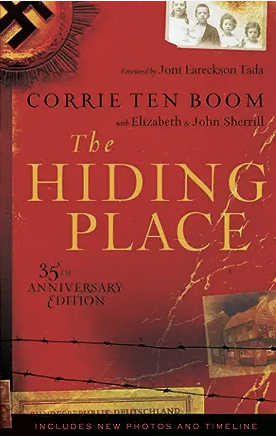
An evangelist and survivor of Hitler’s concentration camps, the life of Corrie Ten Boom stands among the best memoir examples.
4. The Puma Years by Laura Coleman
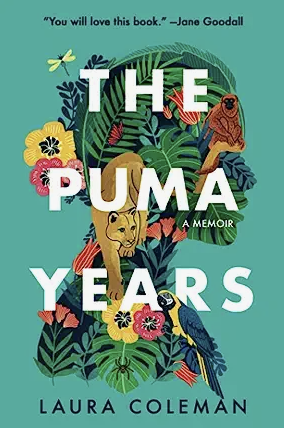
This story stands out among memoir examples for its personal look at the illegal pet trade industry, the impact of deforestation, and the bond between humans and animals.
5. Walden by Henry David Thoreau
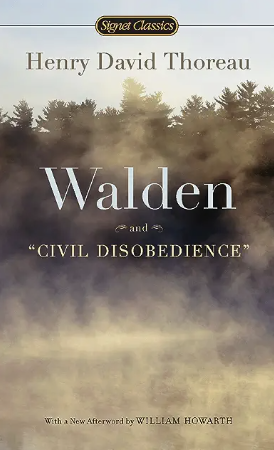
You may not think documenting a life of seclusion would count as a memoir example, but Walden is considered one of the most compelling books in American literature.
6. Born Standing Up by Steve Martin
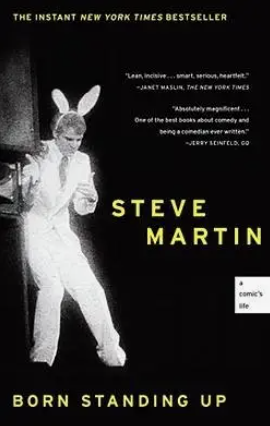
This memoir shares why Steve Martin started – and stopped – his stand-up comedy.
7. Life by Keith Richards
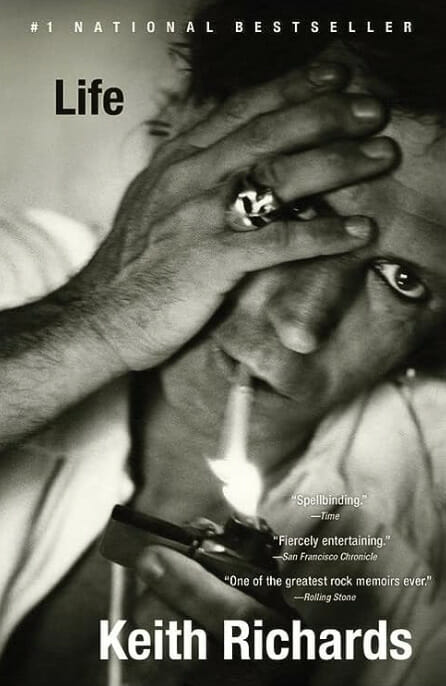
Written by the very one who founded The Rolling Stones , this one stands out among memoir examples. Ready to take a deep dive into Keith Richards’ life?
8. The Bell Jar by Sylvia Plath
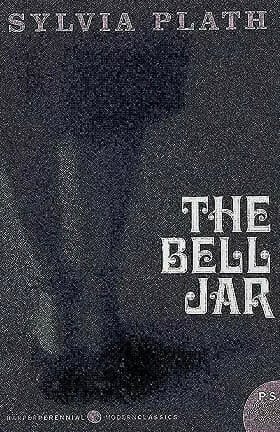
This semi-autobiographical, memoir-esque story shares the key points in Esther Greenwood’s neurosis. It is known as a haunting story while solidifying itself as an American classic.
9. All Over But the Shoutin’ by Rick Bragg
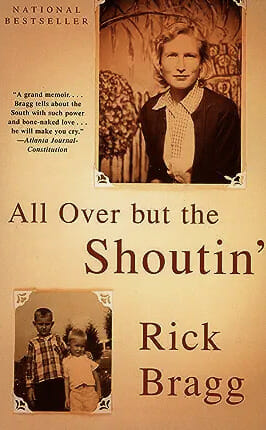
Known for its expert prose, this memoir example tells of a life headed for the cotton mills, culminating in a career as a Pulitzer Prize–winning reporter.
10. The Yellow House by Sarah M. Broom
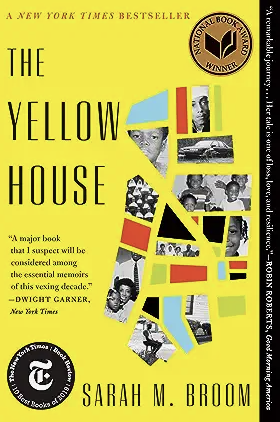
One hundred years covered in one story, The Yellow House is unique among memoir examples.
11. Hunger: A Memoir of (My) Body by Roxane Gay
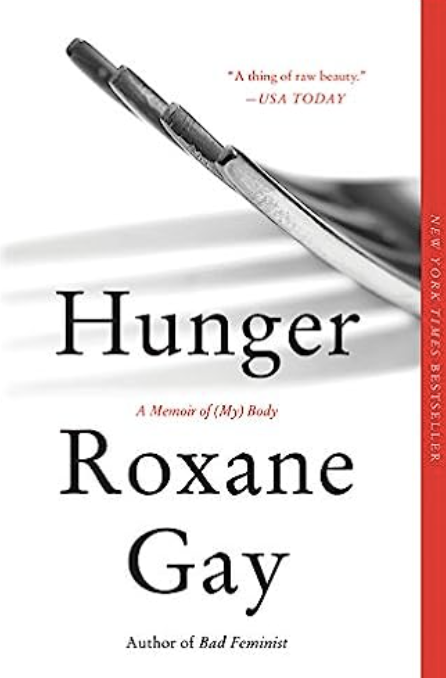
Bestselling author Roxane Gay invites readers into a behind-the-curtain look at self-image, food, safety, and the dependent role each plays in correlation to the others.
12. God’s Smuggler by Brother Andrew
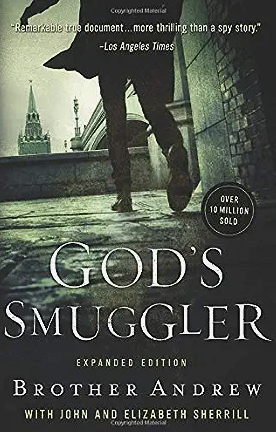
At first glance, Brother Andrew’s story fits in the thriller book genre – except for the fact that it’s all completely true. His dedication to smuggling Bibles to those who did not have any makes for a riveting read.
13. The Long Goodbye by Meghan O'Rourke
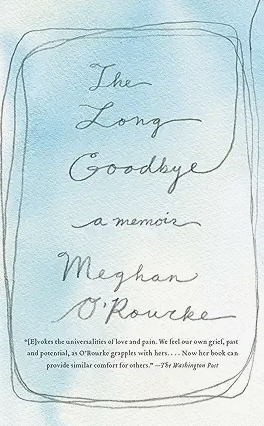
Memoir examples that artfully address grief and how to grieve well are few and far between. Meghan tackles this topic from a personal angle with a story only she could tell.
14. Her by Christa Parravani
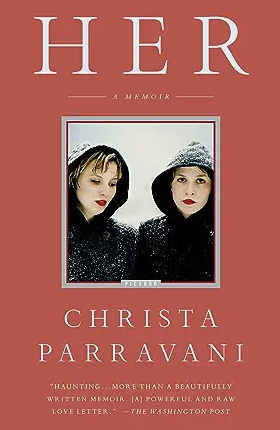
Imagine losing a sibling, a twin, and knowing that you yourself only have a 50% chance at survival. This memoir example covers a unique look at love and survival.
15. South Island Tiny House by Corianne Holmes
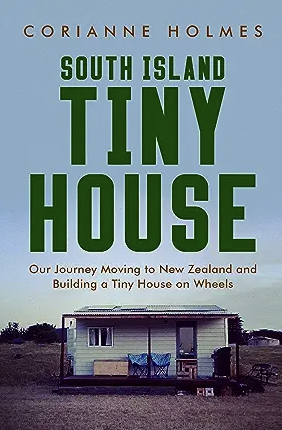
While many of our memoir examples cover large periods of time or even an author's entire lifetime, this is a story about a pivotal, life-changing season in a person's life. Written by one of our very own Self Publishing students , Corianne shares her experience of moving to a new country and into a tiny home – divulging plenty of lessons learned.
16. Fullness by Azure Moyna
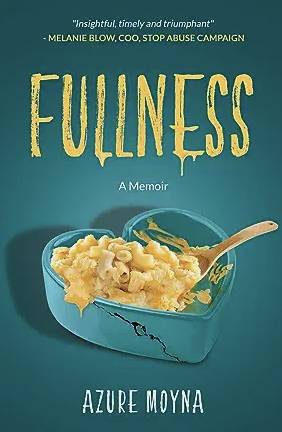
Azure shares her story of surviving her brilliant yet sociopathic father, her struggle with bulimia, and her hunger for love.
17. My Mother's Daughter by Perdita Felicien
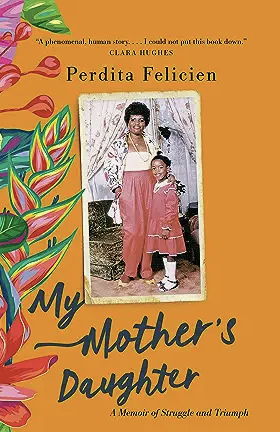
Opportunity, suffering, faith, perseverance and grit , Olympics, and nannying – each one of these topics shows up within the pages of this book that's based on a true story .
18. Beautiful Boy: A Father’s Journey Through His Son’s Addiction By David Sheff
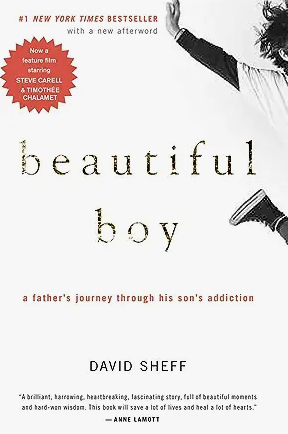
This memoir, written by a father about his son, is such a compelling memoir example that it was turned into a major motion picture. Addiction takes many faces, but when it appears on the face of your son, it’s that much more personal.
19. Cowboy in a Corporate World by Ray Marxer
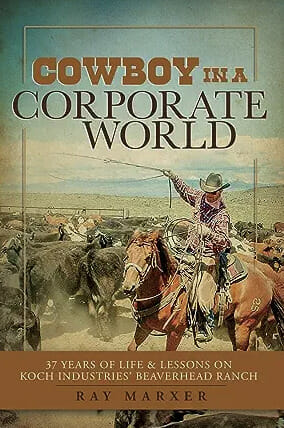
If you are a historical nonfiction lover or enraptured by the American West, read this memoir (by another SP student!) for a modern take about life on the ranch.
20. Personal History by Katharine Graham
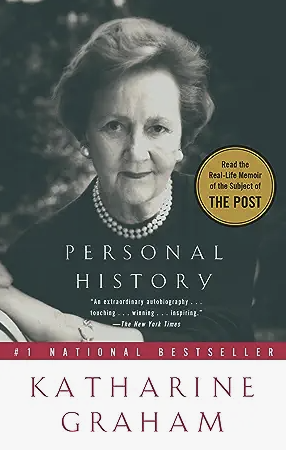
Presidents, mental illness, wealth, suicide, deep loneliness…the life of Katharine Graham will keep you turning pages.
21. Let’s Take The Long Way Home: A Memoir Of Friendship By Gail Caldwell
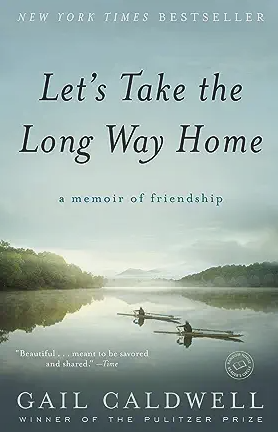
A Pulitzer Prize winner, Gail Caldwell invites readers into an intimate look at friendship, life’s highs and lows, and the power of women when facing it all.
22. When Breath Becomes Air by Paul Kalanithi
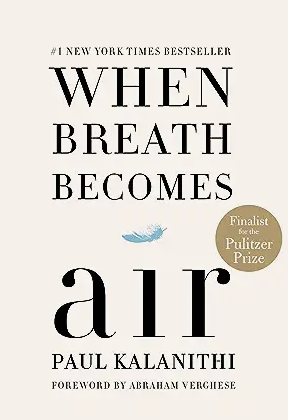
From the New York Times bestseller list , this is a memoir of a 36-year-old who goes from being a neurosurgeon to being a patient.
23. Angela’s Ashes by Frank McCourt
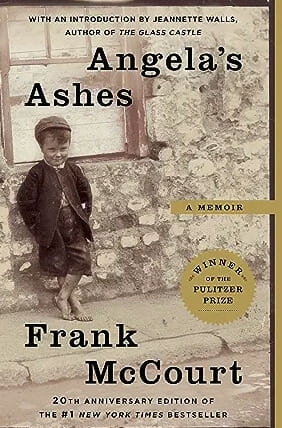
This story chronicles the life of Irish immigrants, their resilience, and the details of surviving daily life.
24. Ain't That a Miracle? by Jeremy Occhipinti
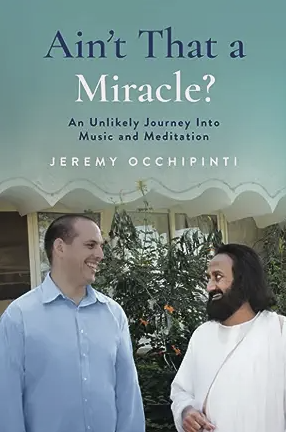
Funny and frank, while addressing some of the extremes of human emotion, this is another one of our favorite memoir examples written by one of our authors!
25. Educated by Tara Westover
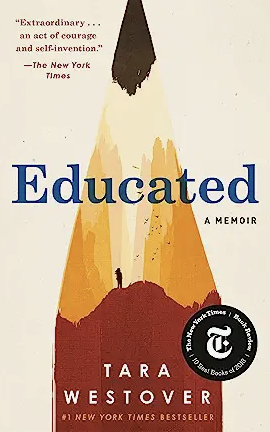
Tara was 10ths 7 when she stepped into her first-ever classroom. Somehow, she made it to Harvard and Cambridge. This is her story.
26. Barefoot to Avalon: A Brother’s Story by David Payne
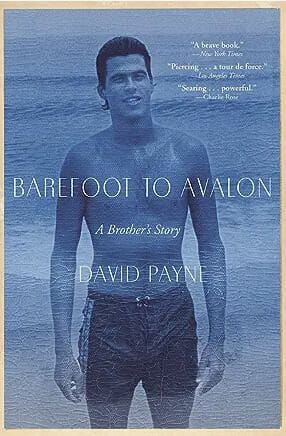
This deeply personal memoir example is one of two brothers, their rivalries and love, and the tragedy that cut through their lives far too early.
27. Heart Berries By Terese Marie Mailhot
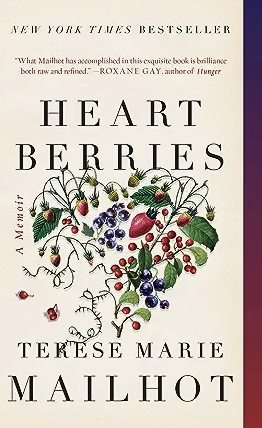
This memoir example shares the story of Terese’s dysfunctional past, a life-changing diagnosis, and, ultimately her journey toward overcoming it all.
28. Yes Please by Amy Poehler
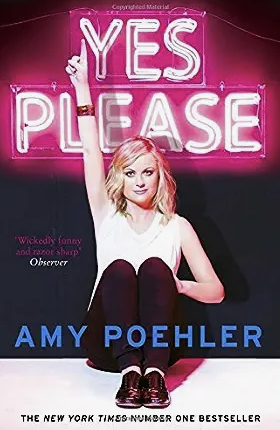
Candid but also hilarious (I mean, would we expect less?) Amy’s story belongs among the top comedic celebrity memoir examples.
29. Pawprints On Our Hearts by Kerk Murray
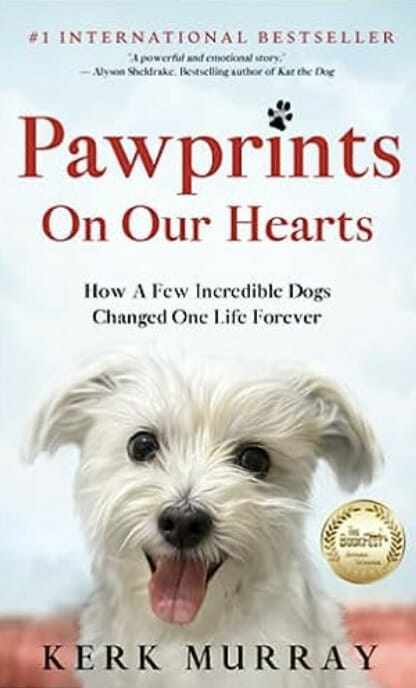
Any book about a man's best friend is always worth the read. This international bestseller was a huge Amazon self-publishing success story, creating a legacy far bigger than just one book.
30. Homage To Catalonia by George Orwell
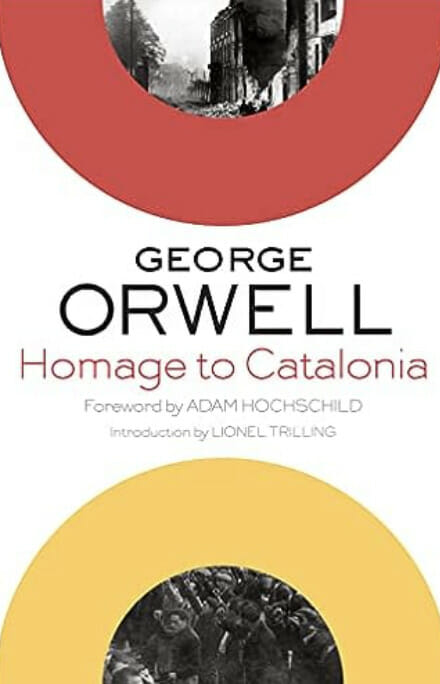
This is a memoir example of personal ideas and the conflict when realities arrive on the war front. George Orwell recounts his time fighting the Fascists.
31. Wave by Sonali Deraniyagala
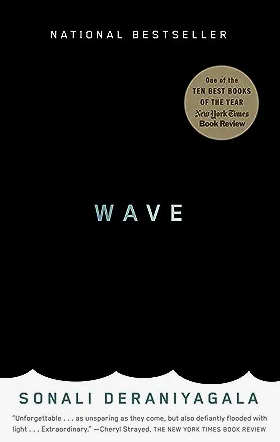
Written by the sole surviving family member of a massive tsunami, Sonali writes about a very serious topic : grief and the aftermath of tragedy.
What’s next? Include your story in memoir examples
You now have a versatile list of various memoir examples as well as snippets of why these stories stand out among memoirs.
Now it’s your turn! Take some time to consider your own life story, the themes that stand out, and how they could help your readers. Then, create a memoir outline and get to writing.
Your story could change people's lives – don't wait any longer to publish it!
While it may feel intimidating to write a book that's raw and vulnerable and your story, starting your memoir is often the most difficult part. Editing , publishing, and book marketing , including permission marketing , all come long after you've got an initial manuscript in your hands. And, if you claim your free copy of Published (just click below) or join our Author Advantage Accelerator, you'll have a dedicated coach to help you with each step of your author journey.
FREE BOOK OUTLINE TEMPLATE
100% Customizable For Your Manuscript.
Related posts
The six-word memoir: an exercise on short, powerful stories, memoir vs biography: spotting the genre differences.
Memoir, Non-Fiction
How to Start a Memoir: 10 Steps for Sharing Your Story
10 Memorable Memoir Examples to Fuel Your Writing Fire
- February 17, 2024
Table of Contents:
List of memoir examples for students.
- 1- "The Glass Castle" by Jeannette Walls:
- 2- "Educated" by Tara Westover:
- 3- "Wild" by Cheryl Strayed:
- 4- "The Diary of a Young Girl" by Anne Frank:
- 5- "Night" by Elie Wiesel:
- 6- "Just as I Am" by Cicely Tyson:
- 7- "Eat, Pray, Love" by Elizabeth Gilbert:
- 8- "Bossypants" by Tina Fey:
- 9- "When Breath Becomes Air" by Paul Kalanithi:
- 10- "The Sun Does Shine" by Anthony Ray Hinton:
Importance of Memoirs
1- personal connection and empathy, 2- historical context, 3- understanding the self, 4- inspiration and motivation, 5- cultural insight, 6- therapeutic writing, conclusion:.
Memoirs hold an exceptional place because they fuse the artistry of storytelling with the raw sincerity of personal experience. With the help of memoir ghostwriters , readers can pass into someone else’s world, allowing us to see life through a different perspective, experience unfamiliar events, and understand diverse viewpoints.
The unique blend of personal insight, historical backdrop, and cultural nuances cements their value in literature and as important sociocultural documents.
Navigating through the memoir examples experience the highs and lows of the author’s life, a memoir illuminates the human condition in a way few other genres can replicate.
Below are the memoir examples:
1- “The Glass Castle” by Jeannette Walls:
Walls paints a clear picture of her troubled youth, which was marked by poverty and parents who didn’t follow the rules. The book is a strong look at strength, family relationships, and the effects of having a hard childhood. Her honest writing lets readers into her world, making them feel pity and think about their lives.
2- “Educated” by Tara Westover:
Westover’s memoir unfolds as a journey of self-discovery and education. The narrative voice skillfully captures the tension between loyalty to family and the pursuit of knowledge. One of those memoir examples addresses the challenges of escaping a restrictive environment and reflects on the transformative power of education in shaping identity.
3- “Wild” by Cheryl Strayed:
Strayed’s autobiography is an interesting account of her journey along the Pacific Crest Trail. The book discusses loss, healing, self-empowerment, and the trip itself. Strayed’s honest and thoughtful writing style connects with readers, making “Wild” a story about looking at the world around you and inside yourself.
4- “The Diary of a Young Girl” by Anne Frank:
Anne Frank’s diary is a poignant firsthand account of life in hiding during the Holocaust. Through her entries, readers witness the resilience of the human spirit amidst unimaginable circumstances. The memoir examples serve as a historical document and a timeless testament to the power of hope and courage.
5- “Night” by Elie Wiesel:
The memories of the Nazi death camps that Wiesel recounts in his book are distressing. In addition to showing how horrible the Holocaust was, the author’s motive for writing is to ask deep questions about faith and humanity. The movie “Night” is a stark warning of how horrible past events can be and how strong people are to keep going.
6- “Just as I Am” by Cicely Tyson:
Cicely Tyson’s memoir reflects on her groundbreaking career as an actress and her journey as a Black woman in the entertainment industry. The book explores themes of identity, purpose, and breaking barriers. Tyson’s strong narrative writing provides insights into the challenges she faced and the trail she blazed for future generations.
7- “Eat, Pray, Love” by Elizabeth Gilbert:
In her book, Gilbert writes about her year-long trip through Italy, India, and Indonesia after a painful split. The book is about discovering yourself, being spiritual, and trying to be happy. “Eat, Pray, Love” is an easy-to-relate and positive book for people who want to grow, thanks to Gilbert’s honest and funny writing.
8- “Bossypants” by Tina Fey:
Tina Fey’s funny writing memoir Night is full of stories from her life and work in the entertainment business. “Bossypants” is funny and deep about gender roles, how the workplace works, and how hard it is to balance work and children. This book is fun and thought-provoking, thanks to Fey’s honesty and humor.
9- “When Breath Becomes Air” by Paul Kalanithi:
Kalanithi, a neurosurgeon diagnosed with terminal cancer, reflects on life, mortality, and the intersection of medicine and philosophy. The memoir, completed posthumously by his wife, Lucy, offers profound insights into the human experience, leaving readers with contemplative thoughts about the meaning of existence.
10- “The Sun Does Shine” by Anthony Ray Hinton:
Hinton’s memoir recounts his unjust incarceration on death row for nearly 30 years before being exonerated. The memoir examples explore themes of injustice, faith, and the resilience of the human spirit. Hinton’s story serves as a powerful testament to the flaws in the criminal justice system and the importance of hope in the face of adversity.
Memoirs offer a wealth of knowledge and insight rare in any other form of literature. They are unique windows into personal, historical, and cultural contexts, revealing real, often powerful, narratives of individual lives. Here’s a look at why memoir writing services are so important:
By reading stories, people can put themselves in another person’s shoes, which helps them understand and care about other people. Memoirs come alive by sharing personal stories about many different kinds of events. This helps us connect more deeply and see things beyond our narrow points of view.
It often captures and reflects upon significant historical events, presenting personal accounts of, for example, wars, political upheavals, or cultural shifts. Memoir examples thus serve as living testimonies and firsthand reports of history, offering an intimate understanding of the past beyond dry facts and figures.
By exploring others’ triumphs and trials, we constructively reflect on our own experiences and realize that as unique as we appear, many of our struggles and joys are universal. This powerful self-reflection opens up the possibility for personal growth.
Memoirs written by professional ghostwriters can inspire by showcasing the resilience and grit of individuals who endured hardship, overcame challenges, and subsequently flourished. They become blueprints for strength and perseverance, fueling our courage in battle.
It’s possible to read a wide range of people’s experiences through their diaries, written by people from many countries, groups, and walks of life. Reading these memoirs may help one better understand and appreciate other cultures by providing glimpses into their unique traditions and ways of life.
For book authors , writing memoirs can work as a therapeutic process. It allows them to express and navigate their experiences and emotions, providing an opportunity for healing, closure, or personal discovery.
Memoirs foster empathy, establish historical connections, provide personal and cultural insights, inspire, and fundamentally remind us of our shared human experiences.
Exploring memoirs can be a journey full of unexpected discoveries and profound insights. These ten memorable memoir examples are just the tip of the iceberg in the broad and diverse universe of memoir literature.
limited Time offer
50% off on all services.
REDEEM YOUR COUPON: VHBA50
Recommended Blogs
Personal narrative | definition, ideas & examples, 14 high-demand white female rappers you must listen, 15 authors like colleen hoover, find your next book crush, hire book authors & publishers at discounted rates looking for a book author or publisher contact us for a free consultation and get 30% off your first project..
Automated page speed optimizations for fast site performance
Write a Great Memoir: How to Start (and Actually Finish) Your First Draft
by Joe Bunting | 1 comment
When I first started writing my memoir, Crowdsourcing Paris , about a real-life adventure I experienced with my wife and ten-month-old son, I thought it was going to be easy.
After all, by that point in my career, I had already written four books, two of which became bestsellers. I’ve got this, I thought. Simple.
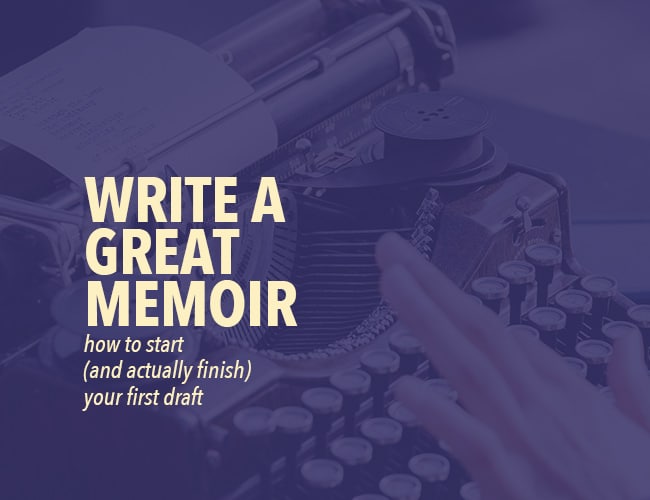
It wasn’t. By the time Crowdsourcing Paris was published and became a #1 New Release on Amazon, it was more than five years later. During that time, I made just about every mistake, but I also learned a process that will reliably help anyone to start and finish writing a great memoir.
My memoir, Crowdsourcing Paris , as a #1 New Release on Amazon!
In this guide, I want to talk about how you can start writing your memoir, how you can actually finish it, and how you can make sure it’s good .
If you read this article from start to finish, it will save you hundreds of hours and result in a much better finished memoir.
Hot tip : Throughout this guide, I will be referencing my memoir Crowdsourcing Paris as an example. To get the most out of this guide and the memoir writing process in general, get a copy of the book to use as an example. Order your copy here »
But Wait! What Is a Memoir? (Memoir Definition)
How do you know if you're writing a memoir? Here's a quick memoir definition:
A memoir is a book length account or autobiography about a real life situation or event. It usually includes a pivotal experience in your life journey.
A key point to make is that memoir is a true story . You don't have to get every piece of dialogue perfect, but you do have to try to tell the personal story or experience as best as you remember.
If you're looking to fictionalize your real life account you're writing a novel, not a memoir (and specifically a roman à clef novel ).
For more on the difference between a novel and a memoir, check out this coaching video:
![memoir essays examples This Memoir Writer Impressed Me [How to Write a Memoir]](https://thewritepractice.com/wp-content/cache/flying-press/QoCXPaaAUXY-hqdefault.jpg)
How to Get Started With Your Memoir: 10 Steps Before You Start Writing
This guide is broken into sections: what to do before you start writing and how to write your first draft.
When most people decide to write a memoir, they just start writing. They write about the first life experience they can think of.
That’s sort of what I did too. I just started writing about my trip to Paris, beginning with how I first decided to go as a way to become a “real writer.” It turned out to be the biggest mistake I made.
If you want to finish your memoir, and even more, write a good memoir, just starting with the first memory you can think of will make things much harder for you.
Instead, get started with a memoir plan.
What’s a memoir plan? There are ten elements. Let’s break it down.
Get the memoir plan in a downloadable worksheet. Click to download your memoir plan »
1. Write Your Memoir Premise in One Sentence
The first part of a memoir plan is your premise. A premise is a one-sentence summary of your book idea.
You might be wondering, how can I summarize my entire life in a single sentence?
The answer is, you can’t. Memoir isn’t a full autobiography. It’s not meant to be a historical account of your entire life story. Instead, it should share one specific situation and what you learned from that situation.
Every memoir premise should contain three things:
- A Character. For your memoir, that character will always be you . For the purposes of your premise, though, it’s a good idea to practice thinking of yourself as the main character of your story. So describe yourself in third person and use one descriptive adjective, e.g. a cautious writer.
- A Situation. Memoirs are about a specific event, situation, or experience. For example, Marion Roach Smith’s bestselling memoir was about the discovery that her mother had Alzheimer’s, which at the time was a fairly unknown illness. My memoir, Crowdsourcing Paris , begins on the first day of my trip to Paris and ends on the day I left. You can’t write about everything, at least in this book. But you can write about one thing well, and save all the other ideas for the next book.
- A Lesson. What life lesson did you learn from this situation? How did your life change inexorably after going through this situation? Again, here you can’t write about everything you’ve ever learned. Choose ONE life lesson or emotional truth and focus on it.
Want to see how a premise actually looks? Here’s an example from my memoir Crowdsourcing Paris :
When a Cautious Writer is forced by his audience to do uncomfortable adventures in Paris he learns the best stories come when you get out of your comfort zone.
One thing to note: a premise is not a book description. My book description, which you can see here , is totally different from the premise. It’s more suspenseful and also less detailed in some ways. That’s because the purpose of a premise isn’t to sell books.
What is the premise of your memoir? Share it in the comments below!
2. Set a Deadline to Finish Your First Draft
Or if you’ve already finished a draft, set a deadline to finish your next draft.
This is crucial to do now , before you do anything else. Why? Because there are parts of the memoir plan that you can spend months, even years on. But while planning is helpful, it can easily become a distraction if you don’t get to the writing part of the process.
That’s why you want to put a time limit on your planning by setting a deadline.
How long should the deadline be?
Stephen King says you should write a first draft in no longer than a season. So ninety days.
In my 100 Day Book program, we’ve helped hundreds of memoir writers finish their book in just 100 days. To me, that’s a good amount of time to finish a first draft.
However, I wouldn’t take any longer than 100 days. Writing a book requires a level of focus that’s difficult to achieve over a long period of time. If you set your deadline for longer than 100 days, you might never finish.
Also set weekly milestones.
In addition to your final deadline, I recommend breaking up the writing process into weekly milestones.
If you’re going to write a 65,000-word memoir over 100 days, let’s say, then divide 65,000 by the number of weeks (about 14) to get your weekly word count goal: about 4,600 words per week.
That will give you a sense of how much progress you’re making each week, so you won’t be in a huge rush to finish right at the end of your deadline. After all, no one can pull an all-nighter and finish a book! Create a writing habit that will enable you to actually finish your book.
Keep track of your word count deadlines.
By the way, this is one reason I love Scrivener , my favorite book writing software , because it allows you to set a target deadline and word count. Then Scrivener automatically calculates how much you need to write every day to reach your deadline.
It’s a great way to keep track of your deadline and how much more you have to write. Check out my review of Scrivener to learn more.
3. Create Consequences to Make Quitting Hard
I’ve learned from experience that a deadline alone isn’t enough. You also have to give your deadline teeth .
Writing a book is hard. To make sure that you show up to the page and do the work you need to finish, you need to make it harder to not write.
How? By creating consequences.
I learned this from a friend of mine, writer and book marketing expert Tim Grahl .
“If you really want to finish your book,” he told me, “write a check for $1,000 to a charity you hate. Then give that check to a friend with instructions to send it if you don’t hit your deadline.”
“I don’t need to do that,” I told him. “I’m a pro. I have discipline.” But a month later, after I still hadn’t made any progress on my memoir, I finally decided to take his advice.
This was during the 2016 U.S. presidential election. So I wrote a $1,000 check to the presidential candidate that I most disliked (who shall remain nameless!), and gave it to a friend with instructions to send the check if I didn’t hit my final deadline.
I also created smaller consequences for the weekly deadlines, which I highly recommend. Here’s how it works:
Consequence #1 : Small consequence, preferably related to a guilty pleasure that might keep you from writing. For example, giving up a game on your phone or watching TV until you finish your book.
Consequence #2 : Giving up a guilty pleasure. For example, giving up ice cream, soda, or alcohol until you finish your book.
Consequence #3 : Send the $1,000 check to the charity you hate.
Each of these would happen if I missed three weekly deadlines. If I missed the final deadline, then just the $1,000 check would get sent.
After I put in each of these consequences, I was the most focused and productive I’ve ever been in my life. I finished my book in just nine weeks and never missed a deadline.
If you actually want to finish your memoir, give this process a try. I think you’ll be surprised by how well it works for you.
4. Decide What Kind of Story You’re Telling
Now that you’ve set your deadline, start thinking about what kind of book you’re writing. What is your story really about?
“Memoir is about something you know after something you’ve been through,” says Marion Roach Smith, author of The Memoir Project .
I think there are seven types of stories that most memoirs are about.
- Coming of Age. A story about a young person finding their place in the world. A great example is 7 Story Mountain by Thomas Merton.
- Education. An education story , according to Kim Kessler and Story Grid, is about a naive character who, through the course of the story, comes to a bigger understanding of the world that gives meaning to their existing life. My memoir, Crowdsourcing Paris , is a great example of an education memoir.
- Love. A love story is about a romantic relationship, either the story of a breakup or of two characters coming together. Eat, Pray, Love by Elizabeth Gilbert is a great example of a love story memoir, as it tells the story of her divorce and then re-discovering herself and love as she travels the world.
- Adventure/Action. All adventure stories are about life and death situations. Also, most travel memoirs are adventure stories. Wild by Cheryl Strayed is a great example, and Crowdsourcing Paris is also an adventure story. (You can apply the principles from our How to Write Adventure guide here , too!)
- Performance. Performance memoirs are about a big competition or a competitive pursuit. Julie and Julia , Julie Powell’s memoir about cooking her way through Julia Child’s recipes, is a good example of a performance memoir. Outlaw Platoon , about the longest-serving Ranger platoon in Afghanistan, is another great performance story.
- Thriller. Memoirs about abuse or even an illness could fall into the crime, horror, or thriller arena. (Our full guide on How to Write a Thriller is here .)
- Society. What is wrong with society? And how can you rebel against the status quo? Society stories are very common as memoirs. I would also argue that most humor memoirs are society stories, since they talk about one person’s funny, transgressive view on society. Anything by David Sedaris, for example, is a society memoir.
For more on all of these genres, check out Story Grid’s article How to Use Story Grid to Write a Memoir .
Three Stories
Note that I included my memoir in two categories. That’s because most books, including memoirs, are actually a combination of three stories. You have:
- An external story. For example, Crowdsourcing Paris is an adventure story.
- An internal story . As I said, Crowdsourcing Paris is an education story.
- A subplot . Usually the subplot is another external story, in my case, a love story.
What three stories are you telling in your memoir?
5. Visualize Your Intention
One of the things that I’ve learned as I’ve coached hundreds of writers to finish their books is that if you visualize the following you are much more likely to follow through and accomplish your writing goals:
- Where you're going to write
- When you're going to write
- How much you're going to write
Here I want you to actively visualize yourself at your favorite writing spot accomplishing the word count goal that you set in step two.
For example, when I was writing Crowdsourcing Paris , I would imagine myself sitting at this one café that was eight doors down from my office. I liked it because it had a little bit of a French feel. Then I would imagine myself there from eight in the morning until about ten.
Finally, I would actively visualize myself watching the word count tracker go from 999 to 1,000 words, which was my goal every day. Just that process of imagining my intention was so helpful.
What is your intention? Where, when, and how much will you write? Imagine yourself actually sitting there in the place you’re going to write your memoir.
6. Who Will Be On Your Team?
No one can write a book alone. I learned this the hard way, and the result was that it took me five years to finish my memoir.
For every other book that I had written, I had other people holding me accountable. Without my team, I know that I would never have written those books. But when I tried to write my memoir, I thought, I can do this on my own. I don’t need accountability, encouragement, and support. I’ve got this.
To figure out who you need to help you finish your memoir, create three different lists of people:
- Other writers. These are people who you can process, with who know the process of writing a book. Some will be a little bit ahead of you, so that when you get stuck, they can encourage you and say, “I’ve been there. You’re going to get through it. Keep working.”
- Readers. Or if you don’t have readers, friends and family. These will be the people who give you feedback on your finished book before it’s published, e.g. beta readers.
- Professional editors. But you also need professional feedback. I recommend listing two different editors here, a content editor to give feedback on the book as a whole (for example, I recommend a Write Practice Certified Coach), and a proofreader or line editor to help polish the final draft. (Having professional editing software is smart too. We like ProWritingAid. Check out our ProWritingAid review .)
Just remember: it takes a team to finish a book. Don’t try to do it on your own.
And if you don’t have relationships with other writers who can be on your team, check out The Write Practice Pro. This is the community I post my writing in to get feedback. Many of my best writing friends came directly from this community. You can learn more about The Write Practice Pro here .
7. What Other Books Will Inspire You?
“Books are made from books,” said Cormac McCarthy. Great writers learn how to write great books by reading other great books, and so should you.
I recommend finding three to five other memoirs that can inspire you during the writing process.
I recommend two criteria for the books you choose:
- Commercially successful. If you want your book to be commercially successful, choose other books that have done well in the marketplace.
- Similar story type. Try to find books that are the same story type that you learned in step four.
For my memoir, I had four main sources of inspiration.
Eat, Pray, Love by Elizabeth Gilbert; The Innocents Abroad by Mark Twain; A Moveable Feast by Ernest Hemingway; and Midnight in Paris , the film by Woody Allen.
I referred back to these sources all the time. For example, when I was stuck on the climactic scene in the memoir, I watched one scene in A Midnight in Paris twenty times until I could quote the dialogue. I still didn’t come up with the solution until the next day, but understanding how other writers solved the problems I was facing helped me figure out my own solutions for my story.
8. Who Is Your Reader Avatar?
Who is your book going to be for? Or who is the one person you’ll think of when you write your book? When the writing gets hard and you want to quit, who will be most disappointed if you never finish your book?
I learned this idea from J.R.R. Tolkien, who wrote his novel The Hobbit for his three boys as a bedtime story. Every day he would work on his pages, and every night he would go home and read them to his sons. And this gave him an amazing way to get feedback. He knew whether they laughed at one part or got bored at another.
This helped him make his story better, but I also imagine it gave him a tremendous amount of motivation.
This Can Be You, Sort Of
I don’t think your reader avatar should be you. When it comes to your own writing, you are the least objective person.
There’s one caveat: you can be your own reader avatar IF you’re writing to a version of yourself at a different time. For example, I have friends who have imagined they were writing to a younger version of themselves.
Who will you write your memoir for?
9. Publishing and Marketing
How will you publish your book? Will you go the traditional route or will you self-publish? Who is your target market (check your reader avatar for help)? What will you do to promote and market your book? Do you have an author website ?
It might be strange to start planning for the publishing and marketing of your book before you ever start writing it, but what I’ve discovered is that when you think through the entire writing process, from the initial idea all the way through the publishing and marketing process, you are much more likely to finish your book.
In fact, in my 100 Day Book program, I found that people who finished this planning process were 52 percent more likely to finish their book.
Spend some time thinking about your publishing and marketing plans. Just thinking about it will help you when you start writing.
Start Building Your Audience Before You Need It
In the current publishing climate, most memoir agents and publishers want you to have some kind of relationship with an audience before they will consider your book.
Start building an audience before you need it. The first step to building an audience, and the first step to publishing in general, is building an author website. If you don’t have a website yet, you can find our full author website guide here .
(Building a website doesn’t have to be intimidating or time-consuming if you have the right guide.)
10. Outline Your Memoir
The final step of the planning process is your memoir outline . This could be the subject of a whole article itself. Here, I’ve learned so much from Story Grid, but if you don’t have time to read the book and listen to over 100 podcast episodes, here’s a quick and dirty process for you.
But First, for the Pantsers
There are two types of writers: the plotters and the pansters . Plotters like to outline. Pantsers think outlining crushes their creative freedom and hate it.
If you identify with the pantsers, that’s okay. Don’t worry too much about this step. I would still recommend writing something in this section of your memoir plan, even if you only know a few moments that will happen in the book, even recording a series of events might help as you plan.
And for you plotters, outline to your heart’s content, as long as you’ve already set your deadline!
Outlining Tips
When you’re ready to start outlining, here are a few tips:
- Begin by writing down all the big moments in your life that line up with your premise. Your premise is the foundation of your story. Anything outside of that premise should be cut.
- S eparate your life events into three acts. One of the most common story structures in writing is the three-act story structure. Act 1 should contain about 25 percent of your story, Act 2 about 50 percent of your story, and Act 3 about 25 percent.
- Act 1 should begin as late into the story as possible. In Crowdsourcing Paris , like most travel memoirs, I began the story the day I arrived in Paris.
- Use flashbacks, but carefully. Since I began Crowdsourcing Paris so late into the action, I used flashbacks to provide some details about what happened to lead up to the trip. Flashbacks can be overused, though, so only include full scenes and don’t info dump with flashbacks.
- Start big. The first scene in your book should be a good representation of what your book is about. So if you’re writing an adventure story (see Step 4), then you should have a life or death moment as the first scene. If you’re writing a love story, you should have a moment of love or love lost.
- End Act 1 with a decision. It is you, and specifically your decisions , that drive the action of your memoir. So what important decision did you make that will drive us into Act 2?
- Start Act 2 with your subplot. In Step 4, I said most books are made up of three stories. Your subplot is an important part of your book, and in most great stories, your subplot begins in Act 2.
- Act 2 begins with a period of “fun and games.” Save the Cat , one of my favorite books for writers, says that after the tension you built with the big decision in Act 1, the first few scenes in Act 2 should be fun and feel good, with things going relatively well for the protagonist.
- Center your second act on the “all is lost” moment. Great stories are about a character who comes to the end of him or herself. The all is lost moment is my favorite to write, because it’s where the character (in this case you ) has the most opportunity to grow. What is YOUR “all is lost” moment?
- Act 3 contains your final climactic moment. For Crowdsourcing Paris , this was the moment when I thought I was going to die. In a love story memoir, it might be when you finally work things out and commit to your partner.
- Act 3 is also where you show the big lesson of the memoir. Emphasis on show. Back in Step 1, you identified the lesson of your memoir. Act 3 is when you finally demonstrate what you’ve learned throughout the memoir in one major event.
- A tip for the final scene: end your memoir with the subplot. This gives a sense of completion to your story and works as a great final moment.
Use the tips above to create a rough outline of your memoir. Keep in mind, when you start writing, things might completely change. That’s okay! The point with your plan isn’t to be perfect. It’s to think through your story from beginning to end so that you’ll be prepared when you get to that point in the writing process.
Want to make this process as easy as possible? Get the memoir plan in a downloadable worksheet. Click to download your memoir plan »
That’s the end of the planning stage of this guide. Now let’s talk about how to write your first draft.
How to Write the First Draft of Your Memoir
If you’ve followed the steps above to create a memoir plan, you’ve done the important work. Writing a memoir, like writing any book, is hard. But it will actually be harder to not be successful if you’ve followed all the steps in the memoir plan.
But once you’ve created the “perfect” plan, it’s time to do the dirty work of writing a first draft.
In part two of our guide, you’ll learn how to write and finish a first draft.
1. Forget Perfection and Write Badly.
First drafts are messy. In fact, Anne Lamott calls them “shitty first drafts” because they are almost always terrible.
Even though I know that, though, any time I’m working on a new writing project, I still get it into my head that my first draft should be a masterpiece.
It usually takes me staring at a blank screen for a few hours before I admit defeat and just start writing.
If you’re reading this, don’t do that! Instead, start by writing badly.
Besides, when you’ve done the hard planning work, what you write will probably be a lot better than you think.
2. Willpower Doesn’t Work. Neither Does Inspiration. Instead, Use the “3 Minute Timer Trick.”
My biggest mistake when I began Crowdsourcing Paris was to think I had the willpower I needed as a professional writer and author of four books to finish the book on my own. Even worse, I thought I would be so inspired that the book would basically write itself.
I didn’t. It took not making much progress on my book for more than a year to realize I needed help.
The best thing you can do to help you focus on the writing process for your second draft is what we talked about in Step 4: Creating a Consequence.
But if you still need help, try my “3 Minute Timer Trick.” Here’s how it works:
- Set a timer for three minutes. Why three minutes? Because for me, I’m so distractible I can’t focus for more than three minutes. I think anyone can focus for three minutes though, even me.
- Write as fast as you can. Don’t think, just write!
- When the timer ends, write down your total word count in a separate document (see image below). Then subtract from the previous word count to calculate how many words you wrote during that session.
- Also write down any distractions during those three minutes. Did the phone ring? Did you have a tough urge to scroll through Facebook or play a game on your phone? Write it down.
- Then, repeat the process by starting the timer again. Can you beat your word count?
This process is surprisingly helpful, especially when you don’t feel like writing. After all, you might not have it in you to write for an hour, but anyone can write for three minutes.
And the amazing thing is that once you’ve started, you might find it much easier to keep going.
Other Tools for Writers
By the way, if you’re looking for the tools I use and other pro writers I know use, check out our Best Tools for Creative Writers guide here .
3. Make Your Weekly Deadlines.
You can’t finish your book in an all-nighter. That being said, you can finish a chapter of your book in an all-nighter.
That’s why it’s so important to have the weekly deadlines we talked about in Part 1, Step 2 of this guide.
By breaking up the writing process into a series of weekly deadlines, you give yourself an achievable framework to finish your book. And with the consequences you set in Step 3 of your memoir plan, you give your deadlines the teeth they need to hold you accountable.
And as I mentioned above, Scrivener is especially helpful for keeping track of deadlines (among other things). If you haven’t yet, check out my review of Scrivener here .
4. Keep Your Team Updated.
Having a hard time? It’s normal. Talk to your team about it.
It seems like when you’re writing a book, everything in the universe conspires against you. You get into a car accident, you get sick, you get into a massive fight with your spouse or family member, you get assigned a new project at your day job.
Writing a book would be hard enough on its own, but when you have the rest of your life to deal with, it can become almost impossible.
Without your team, which we talked about in Step 6 of your book plan, it would be.
For me, I would never have been able to finish one book, let alone the twelve that I’ve now finished, without the support, encouragement, and accountability of the other writers whom I call friends, the readers who believe in me, and most of all, my wife.
Remember: No book is finished alone. When things get hard, talk about it with your team.
And if you need a team, consider joining mine. The Write Practice Pro is a supportive encouraging community of writers and editors. It’s where I get feedback on my writing, and you can get it here too. Learn more about the community here.
5. Finally, Trust the Process.
When I walk writers through the first draft writing process, inevitably, around day sixty, they start to lose faith.
- They think their book is the all-time worst book ever written.
- They get a new idea they want to work on instead.
- They decide the dream to write a book and become a writer was foolish.
- They want to quit.
A few do quit at this point.
But the ones who keep going discover that in just a few weeks they’ve figured out most of the problems in their book, they’re on their last pages, and they’re almost finished.
It happens every time, even to me.
If you take nothing else from this post, please hear this: keep going. Never quit. If you follow this process from start to finish, you’re going to make it, and it’s going to be awesome.
I’m so excited for you.
How to Finish Your Memoir
More than half of this guide is about the planning process. That’s because if you start well, you’ll finish well.
If you create the right plan, then all that’s left is doing the hard, messy work of writing.
Without the right plan, it’s SO easy to get lost along the way.
That’s why I hope you’ll download my Memoir Plan Worksheet. Getting lost in the writing process is inevitable. This plan will become your map when it happens. Click to download the Memoir Plan Worksheet.
More than anything, though, I hope you’ll never quit. It took me five years to write Crowdsourcing Paris , but during that time I matured and grew so much as a writer and a person, all because I didn’t quit.
Even if it takes you five years, the life lessons you’ll learn as you write your book will be worth it.
And if you’re interested in a real-life adventure story set in Paris, I’d be honored if you’d read Crowdsourcing Paris . I think you’ll love it.
Good luck and happy writing.
More Writing Resources:
- How to Write a Memoir Outline: 7 Essential Steps For Your Memoir Outline
- 7 Steps to a Powerful Memoir
- The Memoir Project by Marion Roach Smith
- Crowdsourcing Paris by J.H. Bunting
Are you going to commit to writing a memoir (and never quitting, no matter what)? Let me know in the comments .
Summarize your memoir idea in the form of a one-sentence premise. Make sure it contains all three elements:
- A character
- A situation
Take fifteen minutes to craft your premise. When you’re finished, share your memoir premise in the Pro Practice Workshop for feedback. And if you share, please be sure to give feedback to three other writers. Not a member? Join us .
Joe Bunting
Joe Bunting is an author and the leader of The Write Practice community. He is also the author of the new book Crowdsourcing Paris , a real life adventure story set in France. It was a #1 New Release on Amazon. Follow him on Instagram (@jhbunting).
Want best-seller coaching? Book Joe here.

Work with Joe Bunting?
WSJ Bestselling author, founder of The Write Practice, and book coach with 14+ years experience. Joe Bunting specializes in working with Action, Adventure, Fantasy, Historical Fiction, How To, Literary Fiction, Memoir, Mystery, Nonfiction, Science Fiction, and Self Help books. Sound like a good fit for you?
One of my book chapters has been accepted for publication, but I lack confidence in the accuracy of what I have written. I have completed the chapter, but I would appreciate your assistance in improving its quality.
Trackbacks/Pingbacks
- 3 Rules to Write World-Changing Memoir - The Write Practice - […] Here are my three “rules” about how to write a memoir: […]
- 4 Essentials for Writing Memoir That Resonates With Readers - The Write Practice - […] How do you write memoir and tell a story that is compelling to you, but might not be to…
- 19 Tips on Writing Memoir from The Memoir Project by Marion Roach Smith - The Write Practice - […] Marion Roach Smith has solid advice on how to write your own stories. Let me share nineteen tips on…
- The One Secret to a Deeper Memoir - The Write Practice - […] if you’re wondering how to write a memoir, what if you interviewed people–friends, family, community members–about the events on…
- How to Unlock the Power of the Present Tense in Memoir - The Write Practice - […] Writing memoir in the present tense suits grief in ways that the past tense simply cannot provide. […]
- Read Memoirs to Understand Character Motivation - […] about you? Do you want to know how to write a memoir? Check out our complete guide, Write a…
- How to Satisfy Your Reader With a Great Ending - The Write Practice - […] you’re figuring out how to write a memoir or a novel, creating an ending that is satisfying for the…
- How to Write About Your Family… Without Getting Disowned - […] this it true, through writing my own memoir, I have come to find that we can handle these situations…
- Write a Great Memoir: How to Start (and Actually Finish) Your First Draft – Books, Literature & Writing - […] “When you’re getting started writing a memoir, don’t just start writing about the first thing you remember.Tweet thisTweet […]
- 10 Memoir Writing Prompts to Get You Started - […] to take the next step and learn how to write a memoir? Check out my complete guide, Write a…
- How to Write a Short Memoir Story : The Write Practice - […] Then, when you’re ready to write a full memoir, check out our complete guide, Write a Great Memoir: How…
Submit a Comment Cancel reply
Your email address will not be published. Required fields are marked *
Submit Comment
Join over 450,000 readers who are saying YES to practice. You’ll also get a free copy of our eBook 14 Prompts :
Popular Resources
Book Writing Tips & Guides Creativity & Inspiration Tips Writing Prompts Grammar & Vocab Resources Best Book Writing Software ProWritingAid Review Writing Teacher Resources Publisher Rocket Review Scrivener Review Gifts for Writers
Books By Our Writers

You've got it! Just us where to send your guide.
Enter your email to get our free 10-step guide to becoming a writer.
You've got it! Just us where to send your book.
Enter your first name and email to get our free book, 14 Prompts.
Want to Get Published?
Enter your email to get our free interactive checklist to writing and publishing a book.
- Craft and Criticism
- Fiction and Poetry
- News and Culture
- Lit Hub Radio
- Reading Lists

- Literary Criticism
- Craft and Advice
- In Conversation
- On Translation
- Short Story
- From the Novel
- Bookstores and Libraries
- Film and TV
- Art and Photography
- Freeman’s
- The Virtual Book Channel
- Behind the Mic
- Beyond the Page
- The Cosmic Library
- The Critic and Her Publics
- Emergence Magazine
- Fiction/Non/Fiction
- First Draft: A Dialogue on Writing
- Future Fables
- The History of Literature
- I’m a Writer But
- Just the Right Book
- Lit Century
- The Literary Life with Mitchell Kaplan
- New Books Network
- Tor Presents: Voyage Into Genre
- Windham-Campbell Prizes Podcast
- Write-minded
- The Best of the Decade
- Best Reviewed Books
- BookMarks Daily Giveaway
- The Daily Thrill
- CrimeReads Daily Giveaway

The Memoir in Essays: A Reading List
Elizabeth kadetsky on the multiple ways we can look at the self.
While the personal essay has enjoyed continued popularity, a book-length collection of linked essays, centered on an author’s self or life, is less common than a traditional memoir or novel. A truly successful essay collection can reveal the author processing experiences at many different points in time and through many different lenses. As a writer, I’ve always been drawn to the essay as a form, for its concision, for its ability to highlight an intriguing gap between author and narrator that lends an inherent tension and self-questioning. A collection of essays treating the same or related inquiries multiplies this effect.
The distance afforded by those multivalent lenses can allow an author to regard one’s younger self as a different character, a different persona. This can create an unease or uncertainty that is exciting, and also very relatable to the reader. An author’s ability to forgive that earlier version of herself is especially prevalent in the memoir-in-essays, perhaps because of the extended time period covered as a writer composes essays across years or even decades.
We are lucky enough to be in the middle of a renaissance. Several recent and upcoming memoirs-in-essays use the inquisitive essay form to tell life stories from different vantage points and make the reader question and revel in unreliable narrators and new perspectives. The more traditional memoir focuses on seeking and attaining redemption. The nonlinear structure of an essay collection reveals that there is never easy redemption, never clear resolution: bad things happen for no reason; overcoming one trial does not lessen the need to adapt in the next.
These new, enchanting and powerful collections are a welcome reminder that in our collective state of unrest and unknown futures, there is a comfort in knowing that there is an inherent uncertainty in having the answers.
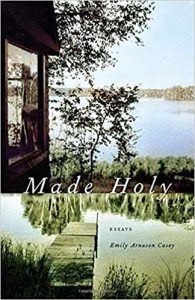
Emily Arnason Casey, Made Holy: Essays (University of Georgia Press)
In beautiful, scenic prose, Emily Arnason Casey probes her middle American childhood from the stance of different venues, times of life, and primary characters—a family cabin and repository for memories both happy and sad; a little sister who grew up and wasn’t a sidekick anymore; a mother who didn’t reveal the family propensity to alcoholism until it was too late; an aunt who succumbed to the illness’s lure. In a spiral-like structure that keeps returning to a central and unanswerable question—how, and why, must this family battle the draws and effects of alcohol addiction—Arnason Casey tells a poignant story of a “normal” family that through its quirks and desires must find a path to survival. The author finds solace in nostalgia and a way forward by examining the errors of the past and by embracing, as a mother, the promise of the future generation. Her probing and compulsive need to question reminds us that alcoholism has no simple etiology, and that its cures are as individual as they are elusive.
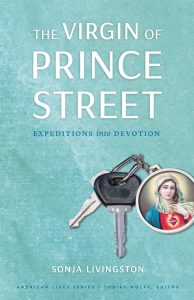
Sonja Livingston, The Virgin of Prince Street: Expeditions into Devotion } (University of Nebraska Press)
At a time of dwindling religiosity, Livingston finds herself wishing for greater connection to her Catholic roots while also exploring the physical space of the church in upstate New York that made memories for her as a child. Because of religious attrition, the church that she grew up in becomes the gathering space for dozens of rescued saint statues deaccessioned from other churches nearby. Livingston embarks upon a quest to find a missing Virgin Mary statue, that moves not in straight lines but elliptically, following a parallel physical and emotional journey that is an exploration into faith, Catholicism, and a desire for spiritual connection on modern terms. In examining the sustained power of a central icon of the Catholic church and an object of personal, sentimental attachment, Livingston’s linked essays highlight the irresolvable paradox of modern religiosity—that the seeker must follow an uncharted middle pathway when the old texts and their tropes, their patriarchy and their strictures, necessarily fall away.
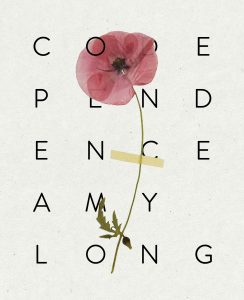
Amy Long, Codependence (Cleveland State University Poetry Center)
In this haunting and troubling book, Long revisits scenes and anecdotes from her boyfriend’s heroin addiction and her subsequent dependence on opioids for chronic pain. Formal experiments such as essays disguised as lists, prescription forms, and medical reports are interspersed among scene-driven recollections from different points in time: the author’s first introduction to the drug; the allure of an older addict; attempts at recovery. The grounding presence of the author’s supportive mother is offset by the narrative’s tragic other constant—the euphoria and escape offered by the drug. By eschewing a linear narrative structure, Long illustrates the difficulty of achieving recovery and puts lie to the myth that addiction is a logical disease that naturally ends with a cure. In its very form, this memoir undermines the narrative so prevalent in media treatments of this illness—that in order to trounce the beast, the individual suffering from addiction need only attend a recovery program. Having written about and witnessed my own sister’s decades’ long struggle to overcome opioid addiction, I was drawn to Long’s wisdom in portraying addiction not as a problem to be solved so much as a complexity to be observed and penetrated.
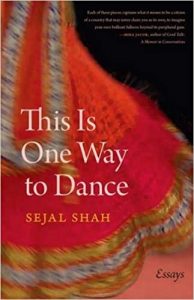
Sejal Shah, This Is One Way to Dance (University of Georgia Press)
The Indian-American author continually revisits her troubled relationship to her American identity through layered essays treating her bifurcated Indian and American past. Exploring her family’s immersion in Gujarati subculture when she was a child growing up in Rochester, New York; her experience as one of few people of color in her MFA creative writing program; and many family weddings in which she must confront her presumed future as a desi bride, Shah questions her place in both American culture and the thriving American-Gujarati subculture. By placing dates at the ends of the essays, it is suggested that her complicated and lifelong conflicts about race and cultural identity can be told chronologically. But, as she explains in her introduction, many essays had multiple end dates after having been revised and reconsidered as time moved forward. The multiple end dates elegantly upend the notion that a rational, hypothesis-thesis-synthesis structure can encompass the complexities of identity and belonging. Shah’s choice to write non-narratively about her conflicts of identity provide insight for anyone raised with a dual or multiple cultural identity—anyone who may, at different points of time, feel a greater allegiance to one culture, another, or a never straightforward amalgam of many. Who we understand ourselves to be, Shah’s book tells the reader in subtle ways, is not a fact so much as a moving target, an unending query.
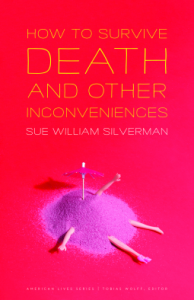
Sue William Silverman, How to Survive Death and Other Inconveniences (University of Nebraska Press)
Silverman is the author of three previous memoirs. In How to Survive Death and Other Inconveniences , she tells her life story through the lens of an obsession with death and the desire to come to terms with the inevitable but often avoided reality that in the end we are mortal. The essays begin with a chronological life story of growing up in New Jersey and encountering American culture’s death-avoidance, but then take a swerve when several brief but elusive mentions accrue into an account of a rape at a young age and a discovery that her memory of the event connects to her fixation on death. A chronological structure gives way to a thematic plot, in which Silverman seeks to confront her topic through reporting, immersion, and reflection—for instance by visiting a morgue, exploring mythological figures associated with death, and recollecting a family funeral. The sophisticated writing and structure make the whole greater than the sum of its many fascinating and worthy parts. Silverman’s essays continually reveal the irrational functioning of memory and how it connects our pasts to our worldviews. Honoring subconscious logic, How to Survive Death and Other Inconveniences makes the gambit that the mysteries of the self are both keys to understanding and uncertainties to be celebrated. We become who we are without being fully conscious of our choices—probing those choices won’t give us easy answers, but the discoveries along the way will be illuminating and well worth the necessary befuddlements.
__________________________________
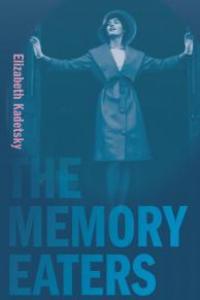
Elizabeth Kadetsky’s memoir , The Memory Eaters, is available now from University of Massachusetts Press.
- Share on Facebook (Opens in new window)
- Click to share on Twitter (Opens in new window)
- Click to share on Google+ (Opens in new window)
- Click to share on LinkedIn (Opens in new window)
- Click to share on Reddit (Opens in new window)
- Click to share on Tumblr (Opens in new window)
- Click to share on Pinterest (Opens in new window)
- Click to share on Pocket (Opens in new window)
Elizabeth Kadetsky
Previous article, next article, support lit hub..

Join our community of readers.
to the Lithub Daily
Popular posts.

Follow us on Twitter
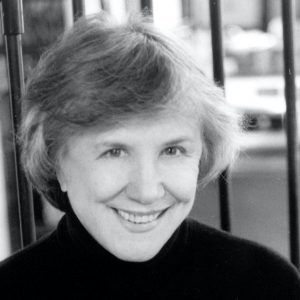
Remembering Deirdre Bair
- RSS - Posts
Literary Hub
Created by Grove Atlantic and Electric Literature
Sign Up For Our Newsletters
How to Pitch Lit Hub
Advertisers: Contact Us
Privacy Policy
Support Lit Hub - Become A Member
Become a Lit Hub Supporting Member : Because Books Matter
For the past decade, Literary Hub has brought you the best of the book world for free—no paywall. But our future relies on you. In return for a donation, you’ll get an ad-free reading experience , exclusive editors’ picks, book giveaways, and our coveted Joan Didion Lit Hub tote bag . Most importantly, you’ll keep independent book coverage alive and thriving on the internet.

Become a member for as low as $5/month

Subscribe to our newsletter
100 short memoir examples - narrative personal essays, scars by david owen, these precious days by ann patchett, the same river twice by david quammen, 50 more great articles about life, after life by joan didion, now we are five by david sedaris, feet in smoke by john jeremiah sullivan, when things go missing by kathryn schulz, 25 more great articles about death.

Love and Relationships
True love by haruki murakami, dating online by emily witt, no labels, no drama by jordana narin, the worst friend date i ever had by samantha irby, 50 more great articles about love and relationships, my first time, twice by ariel levy, tragedy averted. minimal gagging. by lidia yuknavitch, a girl's guide to sexual purity by carmen maria machado, deeply, truly (but not physically) in love by lauren slater, 50 more great articles about sex, peculiar benefits by roxane gay, thanksgiving in mongolia by ariel levy, long day's journey by elizabeth gilbert, trapped by aron ralston, the kingdom of the lotus by patrick symmes, 50 more great articles about travel, ultimate glory by dave gessner, skating home backward by bill vaughn, off diamond head by william finnegan, tennis, trigonometry, tornadoes by david foster wallace, 50 more great articles about sport.

Notes of a Native Son by James Baldwin
How to slowly kill yourself and others in america by kiese laymon, the price of black ambition by roxane gay, 25 more great essays about race, the comfort zone by jonathan franzen, on being an only child by geoff dyer, a raccoon of my own by lauren slater, my dad tried to kill me with an alligator by harrison scott key, difficult girl by lena dunham, seventeen by steve edwards, age appropriate by jen doll, richard by allie brosh, 50 more great articles about growing up, lost in the meritocracy by walter kirn, dumb kids' class by mark bowden, fragments from an education by christopher hitchens, 20 more great articles about education, having children, joy by zadie smith, channel b by megan stielstra, a birth story by meaghan o'connell, i was pregnant, and then i wasn't by laura turner, 10 more great articles about having children.

Patient by Rachel Riederer
The empathy exams by leslie jamison, 50 more great articles about health, mental illness, adventures in depression by allie brosh, darkness visible by william styron, insane after coronavirus by patricia lockwood, 20 more great articles about mental health, explicit violence by lidia yuknavitch, heroin/e by cheryl strayed, me & my monkey by anonymous, me and my girls by david carr, my addicted son by david sheff, how i let drinking take over my life by william leith, 10 more great articles about addiction, autobiography of a body by lucy grealy, a few words about breasts by nora ephron, a thin line between mother and daughter by jennifer egan, the broken country by molly mccully, the trash heap has spoken by carmen maria machado, saying goodbye to my chest by naomi gordon-loebl, the onset by my ngoc to, 20 more great articles about body image, see also..., 150 great articles and essays.

The Unspeakable Things Between Our Bellies by Lidia Yuknavitch
Woven by lidia yuknavitch, girl by alexander chee, pause by mary ruefle, lost cat by mary gaitskill, three by david sedaris, my life as an undocumented immigrant by jose antonio vargas, been down so long it looks like debt to me by m.h. miller, lucky girl by bridget potter, goodbye to all that by joan didion, my misspent youth by meghan daum, lost and found by colson whitehead, night-shifting for the hip fleet by mark jacobson, 25 more great articles about new york, the muse of coyote ugly saloon by elizabeth gilbert, quitting the paint factory by mark slouka, the loading dock manifesto by john hyduk, 40 more great articles about work, the real heroes are dead by james b. stewart, remains of the day by mary lee hannell, 10 more great articles about 9/11.

Book-Length Memoirs
Slouching towards bethlehem by joan didion, me talk pretty one day by david sedaris, just kids by patti smith, the chronology of water by lidia yuknavitch, a heartbreaking work of staggering genius by dave eggers, the glass castle by jeannette walls, brain on fire by susannah cahalan, irritable hearts by mac mcclelland, hunger by roxane gay, a sliver of light by shane bauer, joshua fattal and sarah shourd, 100 more great nonfiction books.
About The Electric Typewriter We search the net to bring you the best nonfiction, articles, essays and journalism
10 Essential Essay-Length Memoirs You Can Read Online for Free
Short insights with big impacts.

- Photo Credit: Unsplash/Sincerely Media
Are you a fan of anecdotal reading, but lacking the time to dive into a 300 page memoir? Do you love the specificity of short essays? Or are you looking for a taste of an author’s work before you peek any deeper into their psyche? Then you might consider looking into some essay-length memoirs—think of them as memoir examples, rather than full-fledged books.
Whether you’re hoping to find a piece of writing that makes you feel less alone, or you want to expand your understanding of the human race, these true accounts will stick with you. Here are 10 phenomenal memoir examples you can read online right now for free.
Related: The Best Essay Collections to Add to Your TBR List
"Me Talk Pretty One Day"
by David Sedaris

- Photo Credit: Chris Karidis/Unsplash
Comedian and author David Sedaris wrote the memoir essay “Me Talk Pretty One Day” about his time living in Paris to learn the French language. While matriculating as a middle-aged man has its benefits—"No one will ever again card me for a drink or demand that I weave a floor mat out of newspapers"—it doesn't spare him, or any of his peers, from the abuse of their teacher. Sedaris recounts carrying a special brand of insecurity, tackling the complexity of language and the thrill of being a humorist going toe-to-toe with a stern and scathing professeure .
For collections of Sedaris’ writing, be sure to check out Dress Your Family in Corduroy and Denim and When You Are Engulfed in Flames .
Related: 13 Famous Memoirs Everyone Should Read Once
"Age Appropriate"
by Jen Doll
Jen Doll is a freelance journalist—whose credits include articles for The Atlantic , Esquire , and New York Magazine —and author of the young adult novel Unclaimed Baggage . In this anecdotal essay about a summer vacation spent with family, Doll explores what it means to bring your teenage self along into adulthood. Stuck between the frustration of being treated like a child by her parents, and the ever-present desire to run from the strains of adult self-sufficiency, she writes to come to terms with the different selves she houses in the context of her surroundings.
Related: 15 Best Memoirs That Will Change Your Outlook on Life
"The Price of Black Ambition"
by Roxane Gay
In “The Price of Black Ambition,” Roxane Gay interweaves a timeline of her struggles and successes with a frank discussion on the sociopolitical racism inherent in the United States. She speaks on the fact that children of color are often given an inflated sense of “ambition” at a young age, as they must work twice as hard with half as much to achieve opportunities that are more carelessly given to their white peers. And, despite the exceptional amounts of work people of color put in to move forward in life, their efforts are regularly regarded as less than—their presence in “white” circles is considered a fluke or consequence of required diversity. She refers to her ambition as a hunger that can never be satisfied in the current status quo of America.
Gay is most notable for her essay collection Bad Feminist , as well as her fiction novel An Untamed State .
Related: 8 Extraordinary Biographies About Strong Women

Want more memoirs? Sign up for the Early Bird Books newsletter and get the best daily ebook deals delivered straight to your inbox.
"My Dad Tried to Kill Me with an Alligator"
by Harrison Scott Key

- Photo Credit: Karl Bewick/Unsplash
Harrison Scott Key is the author of two memoirs: Congratulations, Who Are You Again? and The World’s Largest Man . Key details one humorous afternoon on Mississippi’s Pearl River, where he believes his brother’s “badass” antics and his father’s gruff and wild nature almost led to his death-by-alligator. Through a consideration of the differences between him and his father, he contemplates how his near-death experience might have shaped his adult life. Remembering his father fondly, Key reconsiders his own path of fatherhood.
Related: 10 Moving Biographies and Memoirs
"Explicit Violence"
by Lidia Yuknavitch
Known for her provocative novels Dora: A Headcase , The Small Backs of Children , and The Book of Joan , Lidia Yuknavitch wrote “Explicit Violence” about the terrible abuses she suffered throughout her lifetime. She talks not just of the physical acts, but the ways in which violence changed her state of mind. Yuknavitch is honest about the ways in which she was made to feel like she deserved the violence heaped upon her—and if how she didn’t deserve it, she should become the kind of person that might deserve it. With a sharp clarity, she condemns the ways in which those who suffer abuses, particularly women, are made to feel as though to talk about it is an inconvenience on those who could never understand.
For more from the life of Lidia Yuknavitch, she has also published the full-length memoir The Chronology of Water .
"Surviving Anxiety"
by Scott Stossel
In the essay “Surviving Anxiety,” journalist and author Scott Stossel opens up about his experience with mental illness. Suffering from anxiety since infancy, Stossel paints a startling and surprising picture of the measures he has to go through to appear unaffected and “normal” due to his internal (and often irrational) worries. In an honest detailing of therapeutic, medicinal, and self-medicinal attempts to get his high-functioning anxiety under control, he expresses the frustrations and constant battle those who suffer from mental illness experience. For a deeper look into Stossel’s experience and the history of anxiety, read his full-length memoir My Age of Anxiety .
"Darkness Visible"
by William Styron

- Photo Credit: Ian Espinosa/Unsplash
William Styron, acclaimed writer of Sophie’s Choice and The Confessions of Nat Turner , suffered deeply from bouts of depression. In his memoir essay, “Darkness Visible,” Styron is compelled to speak out about his struggle with mental illness after the suicide of Primo Levi. To combat the ignorance and taboo nature surrounding depression, Styron speaks about his own struggles with dark emotions, as well as the difficult path of healing. In the book of the same name, Styron expands upon this essay in a more complete memoir.
Related: William Styron: A Life in Books

"No Labels, No Drama, Right?"
by Jordana Narin
This enlightening and insightful essay comes from Jordana Narin, the winner of the New York Times 2015 Modern Love College Essay contest. Her memoir account exemplifies how new relationships have changed in the modern era, often careening toward an amorphous understanding between two people. She touches on an inclination to avoid not only labels, but vulnerability. Narin outlines how in a situation where the feelings are no less profound than something “real,” people are putting obstacles in their own paths by embracing an aversion to emotional honesty.
"I Was Pregnant, and Then I Wasn't"
by Laura Turner

- Photo Credit: freestocks.org/Unsplash
Laura Turner is a journalist who has written for such publications as the New York Times , The Atlantic , Glamour , and The Verge , with a book in-progress about the cultural history of anxiety. In this tear-jerking short memoir, Turner talks about her recent experience with a miscarriage. Her account encapsulates the worries of burgeoning motherhood put at sudden odds with grief and an overwhelming feeling of suddenly being alone. In an especially poignant and candid moment, Turner writes, “Your life doesn’t change, and that’s the strange part—because it was supposed to.”
Related: 7 Tragic Memoirs That Deserve Your Tears
"After Life"
by Joan Didion
Following the death of her husband in 2003, renowned essayist, journalist, and author Joan Didion penned “After Life.” In her essay, Didion describes the moments leading up to her husband’s sudden death, and continues on in aching detail about the moments following her realization that he was gone. She describes her “waves” of grief which were at the same time both strange and typical, and reaches for an explanation of how different grief can be when it’s unexpected.
More of Didion’s profound writings include Slouching Toward Bethlehem , The White Album , and After Henry .
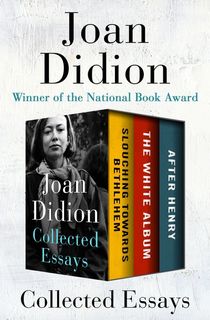
Fiction & Memoirs From 6 Influential Writers
Featured photo: Sincerely Media / Unsplash ; Additional images courtesy of Chris Karidis/ Unsplash ; Karl Bewick/ Unsplash ; Ian Espinosa/ Unsplash ; freestocks.org/ Unsplash
Get the best daily book deals delivered to your inbox
© 2024 OPEN ROAD MEDIA
- We are a participant in the Amazon Services LLC Associates Program, an affiliate advertising program designed to provide a means for us to earn fees by linking to Amazon.com and affiliated sites.
Looking to publish? Meet your dream editor, designer and marketer on Reedsy.
Find the perfect editor for your next book
1 million authors trust the professionals on Reedsy. Come meet them.
Guides • Perfecting your Craft
Last updated on Apr 14, 2023
How to Write a Memoir: Turn Your Personal Story Into a Successful Book
Writing a memoir can be a meaningful way to reflect on your life's journey and share your unique perspective with people around you. But creating a powerful (and marketable) book from your life's memories — one that can be enjoyed by readers across the world — is no easy task.
In this article, we'll explore the essential ingredients that make up an impactful and commercially viable memoir and provide you with tips to craft your own.
Here’s how to write a memoir in 6 steps:
1. Figure out who you’re writing for
2. narrow down your memoir’s focus, 3. distill the story into a logline , 4. choose the key moments to share, 5. don’t skimp on the details and dialogue, 6. portray yourself honestly.
Before you take on the challenge of writing a memoir, make sure you have a clear goal and direction by defining the following:
- What story you’re telling (if you’re telling “the story of your life,” then you may be looking at an autobiography , not a memoir),
- What the purpose of your memoir is,
- Which audience you’re writing it for.
Some authors write a memoir as a way to pass on some wisdom, to process certain parts of their lives, or just as a legacy piece for friends and family to look back on shared memories. Others have stronger literary ambitions, hoping to get a publishing deal through a literary agent , or self-publishing it to reach a wide audience.
Whatever your motivation, we’d recommend approaching it as though you were to publish it. You’ll end up with a book that’s more polished, impactful, and accessible 一 even if it’ll only ever reach your Aunt Jasmine.
🔍 How do you know whether your book idea is marketable? Acclaimed ghostwriter Katy Weitz suggests researching memoir examples from several subcategories to determine whether there’s a readership for a story like yours.
Know your target reader
If you’re not sure where to start it doesn’t hurt to figure out your target audience 一 the age group, gender, and interests of the people you’re writing it for. A memoir targeted at business execs is a very different proposition from one written to appeal to Irish-American baseball fans.
If you want a little help in asking the right questions to define your audience, download our author market research checklist below.

FREE RESOURCE
Market Research Checklist
Find your ultimate target audience with our checklist.
Now that you know who you’re writing for, you need to clearly define which (yummy) slice of your life you want to share with them.
When writing a memoir, there's always the temptation to cover broad periods of your life, from that time in first grade when Mrs. Taylor laughed at your painting, to your third divorce, and everything in between. But remember, this is not a biography. You should try to choose specific experiences or aspects of your life that form a red thread or a central theme. The narrower the focus, the better your memoir will resonate with others.
For example, a memoir could be about the time you hiked the Appalachian Trail, became a Jiu-Jitsu master, or volunteered in a refugee camp. Naturally, anecdotes from other parts of your life may intertwine with your main narrative, but there needs to be a focused center to your book.
Not only will a narrower slice of life help you concentrate your efforts, it will also make it easier to shift the focus from your personal story to specific, relatable things you experienced , making it easier for readers to care and take something away from the book.

GET ACCOUNTABILITY
Meet writing coaches on Reedsy
Industry insiders can help you hone your craft, finish your draft, and get published.
A broader theme readers can relate to
Unless you’re a celebrity, you can’t expect people to just want to read your memoir 一 you have to give them a reason to carve time out of their busy schedule and sit with your book. People are drawn to stories that they can relate to or that teach them something about themselves and the world.
So, before you get to writing, identify the broader themes behind your personal experiences and center the book around them. For example, a story about hiking the Appalachian Trail could be a story about spiritual growth. A book about learning Jiu-Jitsu may be about building confidence and overcoming fear. A memoir about working with refugees could be about cultivating empathy and overcoming structural inequality.
These are themes that people from different ages, gender, and cultures can relate to. They will make your memoir much more universal. Figure out what readers can learn from your experiences, whether that’s something about resilience, trauma, parenting, self-discovery, or other, and center your book around that .
💡 Listen to 3-time memoir author Paul Bradley Carr explain the importance of nailing your memoir’s focus from the get-go in this advice-packed Reedsy Live.

At this point, you’re probably fired up and stretching your fingers to start writing. But there are a few more steps to take to ensure you’re set up for success.
Memory lane isn’t a straight path — it’s a winding road with many off-ramps and distractions. So before you start drafting, make a note of where you’re going by encapsulating your memoir in a sentence or two. Ask yourself: if I were to pitch it to a stranger on an elevator, how would I summarize it? The purpose of this exercise is to help you weave the main themes into a clear narrative arc, which is essential to turn your life into a captivating story.
Here are some example loglines from famous memoirs for inspiration:
Take some time with your logline and whittle your story down to its purest form. If it helps, start by writing what you think the back cover blurb will be. Then boil it down further and further, until you can finally pitch it in just a few sentences.
The logline is the North Star that will guide you as you start to collect the moments of your life to include in the book.
Now that you have a direction and some central themes, it’s time to pick the best tales from your buffet of life experiences. It’s natural to look back at your life chronologically and select memories in a linear fashion, but really, what’s important is to pick the most meaningful moments, whether big or small, that propel your memoir forward.
For example, Trevor Noah’s Born a Crime is a collection of stories about growing up as a mixed-raced child in Apartheid South Africa. The book shares how Noah questioned his mother’s religious beliefs, spoke multiple languages to bridge cultural differences, made and sold CDs to escape poverty, and more. Each story is a different window into his world and how it shaped him, but all of them build on the book’s central themes of faith, identity, and resilience.
Look for moments of high emotion
When you’re mining your memory for stories, look for those with moments of high emotion and meaning. Whether it was a funny, sad, or embarrassing memory, the ones that shaped who you are and how you see the world tend to be the most emotionally charged.
To discern the gems from mediocre stories, consider working with a professional editor and take advantage of their editorial wisdom.

MEET EDITORS
Polish your book with expert help
Sign up, meet 1500+ experienced editors, and find your perfect match.
Now close your eyes, and dig deep into your memories to repaint your stories on the blank page as colorfully (and accurately) as possible.
To make your memoir deeply engaging, experiment with different storytelling techniques and use sensory details, actions, and dialogue, as opposed to explicitly stating what you did or how you felt. This falls into the classic writing advice of ‘ Show, don’t tell .’
When revisiting your memories, be thorough in your research and try to collect as many details as possible:
- Read back your journal entries (if you kept one) to see how you felt in the moment.
- Get your hands on photos or videos from that period in your life (either digital or analog.)
- Interview your family members, friends, and other people relevant to your story.
- Revisit locations and settings from the past that you plan on writing about.
- Look up anything that can be verified or fact-checked (e.g. dates, social media posts, or world news.)
Once you've collected the raw material, organize these memories in a way that makes sense for you. Being systematic in your research will pay serious dividends when you actually start working on your manuscript.
You’re allowed some creative license with dialogue
One thing that is particularly important to get right is dialogue. Obviously, you don't have to write dialogue exactly as it happened — our memories are fallible after all. However, you do need to accurately capture the essence of what was said (and how). As long as you’re faithful to what happened (or at least honest about how you experienced it) you can take some liberties with the precise wording.
To write believable dialogue, take inspiration from your favorite writers, or take our free course below for tips.

FREE COURSE
How to Write Believable Dialogue
Master the art of dialogue in 10 five-minute lessons.
😱 Inevitably, when you write about other people there’s always a risk of portraying them in a way they don’t appreciate. As general advice, tell them you’re writing this story, or prepare to lose some relationships. And if you’re really pushing some boundaries, discuss it with your lawyer!
Next, it’s time to look inwards and flesh out a compelling and relatable protagonist: you!
The best memoirs read like novels, which means they hinge on the protagonist’s voice and personality 一 their quirks, values, and goals, and how they rise to life’s challenges. Just as in a novel, your memoir needs a relatable protagonist that undergoes some change.
It takes a good dose of courage to portray yourself as a multidimensional character 一 one with both strengths and weaknesses, one who sometimes wins and sometimes loses.
Do background work on yourself
To infuse a dose of humanity to your own character, you’ll have to do the background work as if you were a character in a novel. Take note of everything from your physical appearance, cultural background, psychological traits, and more. This exercise will help you bring to surface details about your personality that you’d otherwise look over, and depict a much more well-rounded protagonist. To facilitate the process, use our free character development template which will guide you with specific prompts and questions.

Reedsy’s Character Development Template
A story is only as strong as its characters. Fill this out to develop yours.
Define your character’s arc
Additionally, it's helpful to define your own character's arc 一 how you’ve matured through the life experiences highlighted in the memoir. There are specific steps you can follow to define your personal hero's journey , but among other questions, you’ll have to answer:
- What inciting incident set you on a journey?
- What were the obstacles you encountered?
- Which mentors helped you along the way?
- What were the lessons you needed to learn?
- How have you changed as a result?
These questions will help you strengthen your memoir’s narrative, hooking the readers in like the best novels do.
To give an example, Cheryl Strayed's journey in Wild begins after the death of her beloved mother and other family problems, which lead her on a path of self-destruction, culminating in a divorce and addiction to heroin. Having reached the bottom, she decides to hike the Pacific Crest Trail for three months in order to find herself. The path is filled with challenges 一 from her hiking inexperience, to losing her boots, to fellow hikers warning her that it's not safe to go on alone. Through resilience (and some help) she is able to overcome her physical and emotional challenges, find forgiveness and rediscover her inner strength.

Take inspiration from Wild and other memoirs, and deconstruct how your own experiences might fit into these all-important story elements.
You now have all the ingredients: a specific memoir topic that touches on universal themes (as summarized by your logline), a selection of vivid and relevant memories, and a multidimensional character with an interesting story arc. It’s time to put it all together by outlining the structure of your memoir, which is exactly what we’ll cover in our next post.
15 responses
CourtneySymons says:
11/01/2018 – 15:26
This was exactly the article I needed today! I've just begun a new career path as a ghostwriter and am finding it difficult to find learning resources (conferences, courses, books, networks of ghostwriters, etc.). If any readers have advice on where I should be looking or who I should be talking to, I would be forever grateful! Thanks so much!
M. Thomas Maxwell says:
11/01/2018 – 15:28
I had no intention of writing a book but encouraged by my grandson I embarked on a story telling venture that led to Grandfather's Journal, www.captaintommaxwell.com. It truly is a series of life stories shared with my grandson. Published by Westbow press in 2015 I used many Reedsy tips and am very pleased with the results.I have since encouraged others to consider doing the same. It took over a year and was a pleasant experience.
Don Karp says:
11/01/2018 – 16:06
As a self-published memoir writer, I read this with appreciation. I do not agree with all that's said here. For example, "2. Do Your Research." Of course certain events--those experienced publicly by a large number of people--need to be accurate. But even the word, "memoir," says it's about memory, not accuracy. This is one of the major differences from an autobiography which does require research. I looked up the dictionary definition and got confirmation on this. Perhaps you need to re-examine this and get it right?
↪️ Reedsy replied:
11/01/2018 – 17:00
I would agree that memoirs are indeed based on memory — and in some way that's why historians are often forced to question the reliability of memoirs as a primary source. I would say, however, that modern readers to expect memoirs to be as factually-correct as possible. Editors at publishers will go to great pains to ensure that — or face a public backlash. If you say anything in a memoir that can be disproved by a basic google search will seriously compromise your relationship with a reader. The other benefit with research is that it can do a lot to jog your memories. Unreliable recollections can often be set straight once you remind yourself of certain facts. Thanks for commenting!
↪️ Don Karp replied:
11/01/2018 – 17:28
Thanks for your response. This brings up two points for me. First, what is more powerful, a memory of an experience or the actual experience? Different people interpret the same experience differently. Second, what do you propose to do with the dictionary definition of "memoir?" Since the word is based on memory and not research, perhaps you can suggest some alternate word form?
↪️ The Red Lounge For Writers replied:
05/12/2018 – 08:14
I think looking at the idea of the 'voice of innocence' and the 'voice of experience' could really help with this distinction between fact and memory. As writers of memoir, we are expected to write what we remember. We can do this using the voice of innocence, and use the voice of experience to write about the factual context.
Stu Mountjoy says:
11/01/2018 – 21:48
A group I used to attend, on a Friday, started people off with the basic exercise of writing a story about one thing that happened to you, and I did one about a race at school. I am always impressed by the first page I read of Alan Alder's bio (actor in M*A*S*H TV series) - "Hi I'm Alan Alder, and when I was six, my mother tried to kill my father." - wow.
31/01/2018 – 10:15
Alda's a great writer — "Things I Overheard While Talking to Myself" is such a fantastic name for a memoir too.
Robbie Cheadle says:
31/01/2018 – 04:48
A very useful and interesting post on writing a memoir.
31/01/2018 – 10:14
I'm glad you like it Robbie :)
The Red Lounge For Writers says:
05/12/2018 – 08:10
All great advice. Memoir is probably my favourite genre to read, and some of my favourite books are memoirs. I'm of the opinion that everyone has a story to tell; it's just a matter of figuring out how to do it really well.
James Soil says:
15/07/2019 – 13:16
Thank you very much I just finished my Memoir titled Addicted it will be out this summer after reading this article I feel much better about it I pretty much did what the article says.
Izaura Nicolette says:
04/08/2019 – 04:50
Self-published Author, Izaura Nicolette. 'Within The Mountains: A Mormon Reform School Experience.' Published January, 2019. Seeking legit Publishing House or Agent. I still have not received any royalties due to publishers being fraudulent. I want to speak publicly about my memoir. Hundreds to thousands can back me up. This is a true story. I hold too close to my heart. Hoping to heal by sharing this experience, and opening door for many others.
Magzley says:
08/08/2019 – 02:14
Can I *breathe* life into my story instead?
Cassandra Janzen says:
20/12/2019 – 04:35
Very helpful, thank you!
Comments are currently closed.
Join a community of over 1 million authors
Reedsy is more than just a blog. Become a member today to discover how we can help you publish a beautiful book.

Bring your publishing dreams to life
The world's best editors, designers, and marketers are on Reedsy. Come meet them.

1 million authors trust the professionals on Reedsy. Come meet them.
Enter your email or get started with a social account:
Home — Essay Types — Memoir Essay
Memoir Essay Examples
Selecting the right topic is the cornerstone of a compelling memoir essay. It's the initial step in crafting a narrative that resonates with readers and leaves a lasting impression. The chosen topic serves as the foundation upon which your entire memoir is built, setting the tone and direction for your storytelling journey. To better illustrate this point, let's examine some memoir essay examples in our base of essays.
When you carefully consider your memoir essay topics, you're essentially inviting readers into your world, allowing them to connect with your personal experiences, emotions, and insights. The more relatable the topic, the deeper the connection you can establish with your audience. After all, the power of memoir lies in its ability to evoke empathy and understanding.
To gain a better understanding of this concept, we can turn to some well-known memoirs, such as "The Glass Castle" by Jeannette Walls and "Eat, Pray, Love" by Elizabeth Gilbert, as memoir essay examples. "The Glass Castle" revolves around her unconventional upbringing and the struggles of her impoverished family, illustrating how the right topic can engage readers and make a memoir not just a personal narrative but a shared human experience.
Finding Inspiration for Memoir Essay Topics
So, where can you find inspiration for your memoir essay topics? The answer lies in your own life experiences, and there are countless facets to explore.
I. Start by reflecting on significant life events, such as your childhood memories. Think about the moments that shaped you, the adventures that left a lasting impression, and the challenges that forced you to grow. These events often hold the key to compelling memoir essay ideas, as they offer glimpses into your personal journey.
- A Life-Altering Event and Its Profound Impact
- Exploring the Impact of Milestones in Life
- Personal Crisis Leading to Transformation
- Influence of Key Moments on Life's Path
- Lessons from Milestones: Successes and Failures
II. Additionally, consider your milestones and achievements. Successes and accomplishments, both big and small, can be fertile ground for memoirs. Whether it's graduating from college, starting a business, or completing a marathon, these moments represent your growth and perseverance.
- Reflecting on the Marathon: Perseverance and Transformation
- Transitioning from College to the Real World
- Entrepreneurial Ventures: Navigating Challenges in Business
- Shaping Character Through Personal Achievement
- Personal Growth Through Accomplishments
Personal challenges and growth experiences also make for engaging topics. Everyone faces adversity at some point in their lives, and sharing how you navigated through these trials can inspire and connect with readers who have undergone similar struggles.
Of course, here are the essay topic examples marked up as a list:
- My Journey Through Personal Challenges and Triumph
- My Most Memorable Experiences in Life
- Navigating Personal Struggles for Personal Growth
- Triumphing Over Life's Obstacles: Stories of Resilience
- Lessons from Adversity: Building Empathy and Connection Through Shared Struggles
Lastly, your career and professional experiences are a goldmine of stories. Share your successes, the challenges you've faced, and the valuable lessons you've learned along the way. Your career journey can offer valuable insights and inspiration to others pursuing their own professional paths.
- Lessons Learned from My Professional Journey
- How Past Experiences Influence Our Present
- Overcoming Challenges and Thriving in My Career
- Shaping Growth Through Career Path and Mentorship
- Inspiring Others with Insights from My Professional Odyssey
By delving into these various aspects of your life, you can uncover memoir topics that are not only deeply personal but also universally relatable, creating a narrative that resonates with readers on a profound level.
A memoir essay, with its vulnerability, introspection, and focus on key life lessons, differs from a standard personal essay or autobiography. Unlike chronological autobiographies, memoir essays thoughtfully reflect on specific meaningful experiences. By candidly revisiting impactful moments, memoir essayists gain self-awareness, find meaning in hardship, preserve family histories, and share life-changing epiphanies.
Great memoir essays , illustrated by memoir essay examples , balance vivid scenic recreation, raw emotional insights, and universal truths. Evocative sensory details transport readers to pivotal moments, while introspective narration reveals the inner turmoil, growth, and realizations that recollection brings. The most compelling memoirs extract wisdom from lived experience, inviting readers to reflect on their own journeys.
In the process of studying and crafting your memoir essay, it’s crucial to delve deep into understanding and portraying personal experiences with authenticity and emotional depth. By unlocking free profile essay examples , you can gain insights into different approaches to storytelling and character exploration, enriching your memoir with new dimensions and perspectives.
Memoir Essay’s Central Theme
Identifying your memoir essay’s central theme or message provides focus for both writing and reflection. Set aside time for deep thought about the big life moments you could explore within your memoir essay and what universal insights they hold.
Common memoir themes include overcoming adversity, grief and loss, achievement, parenthood, sexual identity, family dynamics, disillusionment, recovery from trauma or addiction, spiritual awakening, and more. For example, a parent’s memoir may center on personal growth through raising a special needs child. A memoir of grief could find meaning in love and legacy after loss.
Once you land on a specific theme, use it as a touchstone while shaping your memoir’s scenes, tone, and takeaways. Let it guide your writing toward impactful self-revelation.
Memoir Essay’s Structure
An intentional structure connects your memoir’s scenes into a cohesive narrative arc. Chronological organization works well for linear stories, while a braided narrative with interwoven timelines suits winding journeys.
Some memoirs, as in memoir essay examples for college students, utilize frame narratives that “bookend” the story, like Sidonie-Gabrielle Colette’s childhood recollections in My Mother’s House. Others divide chapters into thematic segments, like cancer survivor Kathy Kamen’s shifting outlooks in The Medicine Wheel.
Play with different structures until you find one that mirrors your narrative’s emotional cadence. Outline essential scenes like epiphanies, darkest moments, turning points, and resolutions to build your blueprint. A strong structure elevates your memoir’s impact.
Memoir Essay’s Voice and Tone
An authentic narrative voice and complementary tone shape how readers connect with your memoir. Your voice should fit the story, while your tone reflects the narrator’s perspective.
For example, a humorous, ironic tone could capture the absurdities of childhood. A somber, reflective tone may suit a memoir of loss. Word choice profoundly affects tone, so select descriptors deliberately based on the desired mood and emotions.
Beyond tone, stylistic devices like metaphor and imagery convey voice. Is your narrator contemplative? Sarcastic? Lyrics? Fragmented sentences or analytical asides also contribute nuance. Remember your voice makes the memoir uniquely yours.
Bringing Scenes and Characters to Life
Transport readers right into your memoir’s most pivotal scenes using vivid sensory description. Share sights, sounds, smells, textures, and tastes that set the scene and make it relatable. Zoom in on resonant images and telling details that reveal deeper meaning and character insight.
Dialogue and anecdotes also help dramatize events and portray relationships. Let important conversations and interactions unfold naturally to illuminate the interpersonal dynamics, motivations, and emotions at play. Specific, evocative details turn recalled moments into immersive scenes.
Polishing Memoir Essays
Refine your first draft by revisiting your memoir’s central theme and emotional impact. Strengthen the narrative arc and deepen insights through targeted revision:
- Read sections aloud to polish language and flow.
- Ask trusted readers for constructive feedback.
- Develop motifs and metaphors that underscore themes.
- Enhance scenes with more vivid sensory descriptions.
- Adjust structure and pacing as needed.
- Clarify the narrative perspective and voice.
Revision is key to crafting a memoir that resonates. It takes raw recollections and molds them into universally relatable experiences suffused with meaning.
Free Memoir Essay Examples
We hope these free memoir essay examples inspire you to embrace the power of storytelling and to celebrate the uniqueness of every life’s narrative. Explore the pages of these memoirs to witness the resilience of the human spirit, the complexities of relationships, and the transformative power of personal reflection. These examples of memoir essays are a testament to the richness of the human experience and the artistry of memoir writing.
College Memoir Essay Examples
These insightful essays provide a glimpse into the diverse and transformative experiences of college life. Explore these stories of growth, challenges, and self-discovery as students share their personal narratives, shedding light on the unique journey that is higher education. Whether you’re a student seeking inspiration or simply curious about the college experience, these essays offer valuable insights and perspectives.
How to Write a Memoir Essays
Tips in memoir essay infographics.

Checklist for Writing a Memoir Essay
- Before You Start
✓ Choose a Specific Topic: select a meaningful and impactful life experience to write about.
✓ Identify Your Message: determine the central theme or message you want to convey through your memoir essay.
✓ Gather Memories: brainstorm and collect memories, details, and emotions related to your chosen experience.
✓ Narrow Your Focus: decide on the specific aspect or moment within your experience that you’ll explore in-depth.
- Structuring Your Memoir Essay
✓ Create a Three-Part Structure: plan for a clear beginning, middle, and end in your essay.
✓ Craft an Engaging Introduction: start with a compelling hook that introduces the topic and grabs the reader’s attention.
✓ Develop the Body: explore your chosen experience in detail, utilizing vivid descriptions, emotions, and reflections.
✓ Conclude Thoughtfully: wrap up your essay by tying together loose ends and leaving readers with something to ponder.
✓ Reflect and Connect: consider the broader implications of your memoir, connecting your personal experience to universal truths or lessons.
- Writing Your Memoir Essay
✓ Write Clearly and Concisely: use clear and concise language to convey your story and message effectively.
✓ Use Sensory Details: incorporate sensory details to bring your experiences to life for the reader.
✓ Be Honest and Authentic: share both strengths and vulnerabilities to make your memoir more relatable and authentic.
✓ Embrace Vulnerability: don’t shy away from sharing your emotions and vulnerabilities, as they add depth to your narrative.
✓ Revise and Edit: carefully revise and edit your work for clarity, coherence, and overall polish.
- Additional Resources
✓ Refer to Memoir Examples for College Students: seek inspiration and guidance from memoir examples tailored to college students’ experiences.
✓ Explore how to start a memoir essay examples: study various ways to begin your memoir essay effectively, drawing from examples.
Using this checklist can help you stay organized and focused while writing your memoir essay, ensuring that you craft a compelling and meaningful narrative.
While delving into the intricacies of writing a memoir essay, it’s essential to embrace the complexities of your narrative, weaving together the threads of your experiences with insight and reflection. However, expanding your understanding of different essay formats can further refine your writing craft. Specifically, by crafting a problem-solution essay , you can develop a keen eye for identifying and articulating challenges within your stories, while also presenting thoughtful, engaging resolutions. This skill not only enhances the depth and structure of your memoir but also equips you with a versatile approach to writing that can be applied across various genres. Engage with this dynamic essay format to enrich your storytelling toolkit and bring a new level of sophistication to your memoir.
Figurative Language Memoir
Throughout history, figurative language has been used as a powerful tool for writers to convey complex emotions and ideas in a more engaging and impactful way. From the use of metaphors to similes, personification, and hyperbole, figurative language adds depth and creativity to writing, allowing…
The Power of Traveling: Personal Experiences and Reflections
Introduction Traveling is one of the most enriching experiences one can have. It exposes you to new cultures, customs, and ways of thinking. However, it can also be challenging and unpredictable, making it a true adventure. As a college student, I have had the opportunity…
The Transformative Power of Literacy
Literacy, in its simplest definition, is the ability to read and write. However, it is much more than that. Literacy is a fundamental skill that enables individuals to communicate, comprehend, and learn. It is an essential tool for success in life and is the foundation…
The Significance of Family: A Memoir Paper
Introduction Families are the cornerstone of society. They provide love, support, and guidance to their members, helping them navigate the ups and downs of life. Each family has its unique story to tell, shaped by the experiences they share together. As a college student, I…
Get professional help in 5 minutes

Lessons Learned from Childhood, College, and Long-Distance Connections
Friendship is a fundamental aspect of human life. This memoir reflects on the author’s experiences with childhood friends, college friends, and long-distance friendships, highlighting the lessons learned and the power of friendship in overcoming life’s challenges. Childhood Friends Childhood friends are often the first friends…
Preserving Family Culinary Traditions: A Connection to My Cultural Roots
Food is an essential part of our culture and identity, and it plays a significant role in shaping our family traditions. Growing up, my family’s kitchen was always filled with the smells of delicious home-cooked meals, and the recipes that have been passed down through…
My Journey as a Syrian Refugee: Shedding Light on the Realities of the Crisis
With over 80 million people forcibly displaced from their homes. Syria has been at the forefront of this crisis, with millions of Syrians fleeing the country due to the ongoing civil war. As a Syrian refugee myself, I have experienced the challenges and obstacles that…
Life Experiences: Shaping My Identity
Life is a journey filled with twists and turns that shape who we are today. Our past experiences, both good and bad, have a profound impact on our lives and help us grow into the person we are today. As a college student, I have…
Journey of Self-Discovery through Memoirs
Introduction Memoirs are a powerful tool for self-discovery. They allow individuals to reflect on their past experiences and use them to gain a better understanding of themselves. In this essay, I will be sharing my personal journey of self-discovery through my memoir. I hope that…
From Struggles to Success: My Journey
Introduction Life is a journey full of twists and turns, ups and downs. My journey has been no exception. Growing up, I faced many challenges that tested my resilience and strength. However, through hard work and determination, I was able to overcome these struggles and…
What is a memoir essay?
This type of writing is often mixed up with autobiography essays. However, it is not the same as it represents a first-person narrative that describes a certain part of a person's life. The topics and ideas are always chosen by the author. In terms of comparing a personal essay vs memoir, it is necessary to understand that memoir still keeps to a certain chronology even if describing a single day.
How to write memoir essays?
Even though it is not a fiction story, memoir essay writing still uses various metaphors or literary devices that increase an emotional effect. You can see our memoir essay examples that show how it is done in practice. The structure has a strong temporal effect and an overly emotional tone, which is acceptable for memoir writing. Remember to end your writing with an important argumentation that will make readers think.
How to start writing a memoir essay?
To begin writing a memoir essay, start by identifying a compelling personal story or theme from your life. Reflect on its significance and outline the key moments. Then, create an engaging opening that hooks readers, drawing them into your narrative. Finally, let your story unfold with honesty, reflection, and vivid detail.
How to write a memoir essay structure?
A memoir essay typically follows a chronological or thematic structure. Start with an engaging introduction, introduce the central theme or event, and provide vivid details. Progress through the narrative, building tension or insight. Conclude by reflecting on the significance of your story, offering lessons, or leaving readers with a thought-provoking idea.
How does a memoir essay differ from other types of writing?
Memoir essays differ by their introspective nature, centering on personal experiences and lessons learned. They often incorporate vivid descriptions and emotional depth to engage readers on a personal level.
What are some common themes explored in memoir essays?
Common memoir themes include overcoming adversity, family dynamics, personal growth, grief, identity, and transformative moments. These themes provide a framework for exploring life's complexities.
What is the ultimate goal of a memoir essay?
The primary goal of a memoir essay is to share a personal story while offering universal insights or lessons that resonate with readers. It aims to create a meaningful and reflective narrative.
How much personal detail should I include?
Be judiciously vulnerable. Share telling details that lend insight, but avoid oversharing or exposing others’ privacy. Strive for candid self-revelation in service of the larger theme.
How do I conclude in a meaningful way?
Offer closing reflections on your memoir’s central insights, tying together the theme and narrative arc. Look ahead to the future or revisit where the journey began. End on an uplifting or poignant note.
Students also browse
- Proposal Essay
- Analytical Essay
- Profile Essay
- Satire Essay
- Argumentative Essay
- Exploratory Essay
- Informative Essay
- Evaluation Essay
- Persuasive Essay
- Rhetorical Analysis Essay
We use cookies to personalyze your web-site experience. By continuing we’ll assume you board with our cookie policy .
- Instructions Followed To The Letter
- Deadlines Met At Every Stage
- Unique And Plagiarism Free
- Skip to main content
- Skip to primary sidebar
- Skip to footer
Memoir coach and author Marion Roach
Welcome to The Memoir Project, the portal to your writing life.
How to Write A Memoir in Essays

Sorting the Stories — Memoir as Essay Collection
by Linda Styles Berkery
When I told a friend that I was taking a memoir-writing class, she replied, “Your life just isn’t that interesting.” Obviously she was thinking autobiography , not understanding memoir . I ignored her comment and continued to write about the small threads of wisdom I’ve learned.
After many edits, additions, and subtractions, I had built a wardrobe. I had a collection of fourteen personal essays—each one told through the lens of a dress. A Little Black Dress —learning compassion as illustrated by growing up in a funeral home. Memory Gown —naming mistakes as illustrated by a trip to the ER. Red Mini —seeing individuals as illustrated by teaching third grade. Ordinary dresses can bring out profound lessons.
Since all the writing pieces were in essay format, I adjusted Marion Roach Smith’s famous writing math, It’s about X as illustrated by Y to be told in a Z , and made a chart. To my Z factor, (essays) I added color and noted the dress: a turquoise paisley print, a navy maternity dress, an orange Hawaiian muumuu, a yellow sundress from 1941, a blue velvet jumper.
Each essay could stand alone, yet a book kept coming to mind. It was not enough to say I have a collection of “dress stories” of different length and various moods. I had more work to do. Although my structure would not be typical of a book length memoir (Act 1, Act 2, Act 3), even memoir as an essay collection must have an overall arc—a roof overhead, not just dress threads running through. Yes, memoir can be an essay collection, but it still needs structure and order.
I printed each story individually and laid them across my living room carpet. I knew which essay to put first and which would be last, but the other twelve? Originally I was tempted to group them. These three relate to my father’s WWII stories—put them together. Two had childhood dresses. My husband was mentioned in this group. But nothing really worked until my wonderful editor, Robyn Ringler, passed along tips she had learned from her own writing coach.
“Mix them up,” Robyn suggested. “Vary the word count. Don’t try to force the order, but pay attention to the emotions and lessons in the stories. Then, after you collect everything in the order you think might work, read the last paragraph of one story and the first paragraph of the following story and see if that works. You might need to do that process a few times.”
Robyn was right. I did arrange the essays a few times. But since these were, after all, dress stories, I got creative. If I had a photo of the dress, or a scrap of material from the dress, I stapled it to the printed page. Clearing a closet rod, I hung each essay from fourteen skirt hangers and started arranging them for a book. (Don’t try this at home.) I moved them and moved them until I could see a lovely rainbow arc for the entire collection.
When I was finally comfortable with the flow, I released my dress stories from their hangers and returned to the computer to cut and paste the individual essays into one long document. More edits. Moving paragraphs. Breaking up stories into parts. Adding just a bit more here and there. Writing an introduction and a final note to the reader. Two years after I wrote the first “dress story” for a memoir class, the book was published as Reflections: A Wardrobe of Life Lessons. Memoir, like a classic great dress, never goes out of style.
From the Introduction:
The hardest years in life are those between ten and seventy.
—Helen Hayes
At ten, I wasn’t the moody middle child wanting to be noticed, as much as the one who always seemed to notice. I was the sorter of stories, the keeper of traditions. Reaching up, or out, or down, I saw invisible threads that joined people together. I still do. Now, at seventy, I’m connecting more strands. And dresses are coaching my memory.
Three hard white suitcases live under my bed. I yank out the middle one and plop it on the blue star quilt. I’m not loading it up for a trip; it’s already full. I know what’s inside: dresses, scraps of fabric from dresses, and old photos. Clicking on the double locks feels like opening a black box of flight recordings. Messages vibrate from crinkles and creases, stains and frills. Memories rise from cotton, velvet, and silk—fibers from my journey through life.
Wisdom remains on the fold of one dress. I smooth a wrinkle and kindness appears. When I trace my pinky over white lace, I remember letting go. Hope is in there too, along with judgment, loss, compassion, forgiveness…a wardrobe of memories just waiting to be unpacked. Ralph Waldo Emerson said, “Life is a succession of lessons which must be lived to be understood.” I agree. But sometimes a life lesson can also be worn as a dress.
Excerpt from a middle essay: Navy Maternity
My first maternity outfit was a long-sleeved navy blue dress from Sears that I bought for my father’s wake and funeral. I wore it again on Father’s Day and then buried it under the lilac bush in my childhood backyard, watering the ground with my tears. The words from a homily echoed in my head. Ritualize where you are now . That’s what I was doing—dressing a wound by burying a dress…
The moment I stepped out of that dress, I felt different. Lighter. Aware. I was carrying a new life—had been all along—but now I could finally breathe. I glanced in the mirror and saw myself as a mother-to-be. I shoved the dress in the bag and tossed it in the car. The dress was easy to remove, but not the grief. Shifting my focus to new life, I decided to take one small step.
The following week, on my final day of teaching elementary school, I drove to my childhood home only two blocks away. I pulled the navy maternity dress from the white plastic bag. My mother was at work. But I didn’t need her. I knew where my father’s garden tools were kept. I grabbed a shovel and began digging in the dirt near the lilac bush—Dad’s favorite bush. It didn’t take long to scoop a hole big enough to bury a death dress…
Excerpt from the final essay: Dressing for a Reunion
At the Hyatt Regency Hotel near Dulles Airport, I’m wearing the same tri-colored dress that I wore for my 50 th high school reunion in 2016—it’s mostly blue, with bands of black and white. I call it my past-present-future dress. The dress is making an encore appearance in 2017 at a different reunion tonight. Can it really be called a reunion if we’ve never met? My husband tells me to hurry. We exit the elevator and enter a full dining room. The celebration begins.
Arms reach across the table to shake my hand. A shoulder nudges close. I feel a tap on my back. Legs move toward me. Fingers clasp. Another arm extends around my waist. Then hugs, so many embraces and tears. I am aware of my middle-ness. I am a quiet middle child, in the middle of a loud story. I am in the middle of history, in the middle of generations, in the middle of Danish fishermen and American flyers. I’m standing in the middle of memory and expectation because I did what middle children do best—I made connections…
Author’s bio: Linda Styles Berkery holds an M.A. from Russell Sage College. Linda taught third grade, led retreats and worked in parish ministry. Her writings on faith/life have been published in various magazines, blogs and books. Her new book is Reflections: A Wardrobe of Life Lessons.
HOW TO WIN A COPY OF THE BOOK I hope you enjoy Writing Lessons. Featuring well-published writers of our favorite genre, each installment takes on one short topic addressing how to write memoir. It’s my way of saying thanks for coming by. Love the author featured above? Did you learn something in the how-to? Then you’ve got to read the book. And you can. I am giving away one copy, and all you have to do to win is leave a comment below about something you learned from the writing lesson or the excerpt. I’ll draw winners at random (using the tool at random dot org) after entries close at midnight on May 15, 2019. Good luck!
Share this:
Related posts:
- Writing Lessons: Picking Small Topics To Write About
- Writing Lessons: Finding Time to Write
- Writing Lessons: How to Write About A Difficult Subject, by Bette Lynch Husted
GET THE QWERTY PODCAST

Subscribe free to the podcast
Reader interactions.
Amy Laundrie says
April 14, 2019 at 7:37 am
I found this extremely helpful. I’m a columnist for “The Wisconsin Dells Events” and am searching for a way to connect my “Slice of Life” columns into a second memoir. My first, “Laugh, Cry, Reflect: Stories From a Joyful Heart” includes pieces on nature, my pet ducklings, antidotes about my teaching career, and family stories. I appreciate the tips on how memoirists should make sure the last paragraph of one piece ties in with the first paragraph of the next and I think using dresses as a uniting metaphor was brilliant. I’m eager to read your book.
April 14, 2019 at 10:50 am
Dear Amy, I appreciate your kind words. I had a lot of fun using dresses as a thread through the essays. I would love to read your own slices of life columns. Marion has helped all of us go small. Linda
Susan Davies says
April 14, 2019 at 8:05 am
I love this concept! I have been so stuck in my writing, feeling overwhelmed. I had contemplated this approach but was so unsure….this lesson just gave me that push! Wish me luck! Thank you for your lessons! I enjoy them so much!
April 14, 2019 at 10:54 am
Susan, This is great news. I found all the writing lessons to be so helpful in my own work and I am honored that sharing my experience can help nudge you today. It is so good to give back. My editor, Robyn Ringler shared these tips from her own writing teacher so we are helping each other to gain movement. Linda
Laura McKowen says
April 14, 2019 at 8:09 am
Your content is so very helpful, Marion. About nine months ago, I read your book, and then I was on one of your calls. What I learned helped me focus, organize, and finish my manuscript for my first book, a memoir about sobriety. I sent it to my publisher last week. :) Thank you!
April 14, 2019 at 10:57 am
Marion’s content has always been so helpful to me too. Congratulations on completing your story.
David Sofi says
April 14, 2019 at 8:10 am
Excellent lesson and piece by Ms. Berkery. Especially resonating was the bit about Robyn’s advice from her writing coach. I will have that posted on my Writing Wall. I also tingled with her modification of The Algorithm (That is my personal emphasis of Marion’s lesson, it is so insightful and meaningful.)
Linda Berkery says
April 14, 2019 at 8:31 am
Marion’s writing math made each essay possible and I held it in mind throughout the entire book. Robyn RIngler’s advice pulled the entire collection together. Thank you for your comments.
Careen says
April 14, 2019 at 8:14 am
I want this book! Not only for its content, but because it illustrates the principles Marion puts forth.
April 14, 2019 at 11:34 am
Careen, I hope you continue to find help from the writing lessons and the wisdom from Marion. I surely did. Linda
Ginger Hudock says
April 14, 2019 at 8:16 am
This was wonderful post! The book would be something I could relate to because my age (61) and the metaphor of dresses. This is a great and doable way to structure a book as a series of essays. It seems much more doable for me. I am comfortable writing blog posts and magazine articles, but the thought of a long book is overwhelming sometimes.
April 14, 2019 at 11:01 am
Ginger, I am with you on the thoughts of a long book. It seemed too much for me. I was so happy to find that a series of essays was a reachable goal and Marion gave good feedback when I shared that I was attempting to do just that – she reminded me that I still needed an overall arc in order to print them together as a book. I hope you continue.
April 14, 2019 at 8:30 am
Breaking up the writing into smaller, more manageable pieces seems to tame the bigger writing project, sticking to the algorithm in each section. I loved seeing the process of finding the structure of the book, which is my biggest challenge.
April 14, 2019 at 11:40 am
Dear Beth, Smaller pieces worked so well for this collection. And yes, with each essay I made sure to follow the writing math. I kept asking myself what is this about ? Although told through the lens of a dress, it wasn’t about the dress… it was about a universal theme. Thank you for your thoughts. Linda
April 14, 2019 at 8:35 am
I can’t tell you how often I used Marion’s book and notes from her course as I was completing this book. Such good advice.
Elizabeth says
April 14, 2019 at 8:38 am
I flipped through my closet in my mind – many ideas there for essays, including the ban on trousers for women in my high school in the sixties, and the godawful bloomers for gym class. Thank you!
April 14, 2019 at 11:09 am
Oh Elizabeth, Our minds must run similar. There is a story about those gym “dresses” from my first P E class at Russell Sage College. And oh yes, a mini dress from my teaching days, when women were not allowed to wear pants, but COULD wear a mini dress three inches above the knees. Keep flipping through your closet in your mind. Clothing is so rich to draw out the memoir essays. Thank you for your post. Linda
Ruth Crates says
April 14, 2019 at 8:59 am
I continue to look for a way to write my memoirs. Essays might be a good fit for me. I love how Linda used an unlikely subject…. dresses – to relate her life experiences. If I don’t win the book, I will buy it…I loved the exerpt about burying her grief. We can all relate to that.
April 14, 2019 at 4:30 pm
Dear Ruth, I do hope that you will continue to write memoir. I found that essays were a perfect length. Mine ranged from about 800 to 1200 words in the book. Some had several parts but each one could be read alone which helped me continue. I am happy whenever someone considers the book, the proceeds are going to assist a local thrift store, called ReStyle, from Unity House in Troy. When we have some book signings we are also inviting readers to donate a gently used dress. So my unlikely thread of dresses is really being put to good use. Linda
April 14, 2019 at 4:34 pm
Isn’t it amazing how an idea can take off in so many directions! A wonderful way to help others.
April 14, 2019 at 4:40 pm
If you are in the Albany-Troy area look for several benefit book signings on the Facebook page: Reflections: A Wardrobe of Life Lessons
Cynthia C says
April 14, 2019 at 9:04 am
Incredibly helpful hearing about the writing process! I love reading how these authors make decisions about how the final product will look.
April 14, 2019 at 4:36 pm
Cynthia, I always loved reading the writing lessons from Marion’s posts. I was fascinated with the whole process of structure. Linda
Cassandra Hamilton says
April 14, 2019 at 9:41 am
Great post. I appreciate Linda Styles Berkery sharing her process. By breaking her subject into essays she was able to work ideas in smaller sections. I like how when she focused on the larger piece, the book, she turned to a visceral and visual method: hanging up her essays, each represented by a dress, to sort and rearrange until she felt they were right. I would think the photos of the dresses also evoked in her thoughts and feelings and helped her to pack her writing with vivid descriptions. I’m inspired with her process and how she cleverly teased us with snippets of her new work. Thank you!
April 14, 2019 at 4:44 pm
Dear Cassandra, Thanks for your comments. You are right about the visual part. It really helped me to organize the flow of the essays and the overall arc of the book. (And at one point when I realized that I didn’t have a green dress – it brought up a life lesson from an old memoir of a green gym dress!) Linda
Cheryl Hilderbrand says
April 14, 2019 at 10:08 am
Since the excerpts offered here resonated so strongly, I can’t wait to read the rest of the book. Is it just women our age who grew up with dresses who are so emotionally connected to fabric, and tucks, and gathers? A quilt made from childhood dresses keeps me warm, but I worry that I should put it away so that it’s scrapbook, memory-spurring nature can be preserved. The advice from Ms. Berkery’s editor was something I needed to hear . Thank you Marion, Linda, and Robyn.
April 14, 2019 at 4:49 pm
Dear Cheryl, I do think that dresses meant a lot more to us than they do to the next generation. My own adult daughters rarely wear dresses, but they still have emotional and memories attached to clothing. My husband saved his race t-shirts and had them made into a quilt! He no longer runs, only walks due to an injury, but that quilt hangs over his couch reminding him of all those races. Robyn Ringler’s insights (my editor for the book) were so valuable in getting this collection to print. I am glad to pass her advice along. Linda
Jen Chambers says
April 14, 2019 at 10:17 am
I find this very helpful- it solidifies a concept that I’ve been working on for some time of using essays as memoir in my own work. Using a literal thread to hold the narrative together made a great metaphor here. I am intrigued by the structural ideas and hope to get the book!
April 14, 2019 at 5:18 pm
Dear Jen, Thank you for your comments. I hope you continue to use essays as memoir. It really helped me to keep going.. I could focus on one essay at a time. Indeed I kept them in separate folders on my computer until I recognized how to make “dress stories” into a literary closet collection. Best regards,’ Linda
Debbie Morris says
April 14, 2019 at 10:28 am
I’ve had an idea brewing for years now, and this style has opened up a completely new way to join them yet keep them separate. I thoroughly enjoy the teachings here as well as that wonderfully inspiring sampling of essays. I feel energized, thank you!
April 14, 2019 at 6:03 pm
Dear Debbie, Thanks for the comments. I hope this idea keeps brewing and maybe finds a similar outlet. Linda
Barbara Womack says
April 14, 2019 at 10:38 am
I love this concept and have been inspired to use a similar approach in my own (somewhat stalled) writing.
I can’t wait to read this book!
April 14, 2019 at 6:06 pm
Dear Barbara, I am glad to hear about your writing. I wish you well on the journey and am happy that you found this approach to be helpful. Linda
Ann Hutton says
April 14, 2019 at 10:44 am
Excellent! I’m sharing this with a memoir writing group I facilitate. Meanwhile, I call out a “Yes!” to visually laying out your pages to really SEE what you’ve got and how it might fit together. Once I taped 260 pages to three walls in an empty office in order to look at the structure of a memoir manuscript. That’s when I realized that I did indeed have a beginning, middle, and ending! And looking for repetitions or other glaring mistakes was easier this way, rather than trying to read through pages on a computer screen.
Many thanks!
LInda Berkery says
April 14, 2019 at 6:11 pm
Dear Ann, Wow that must have been some wall sight! Yes, I think we sometimes need a visual way to keep us moving forward. Glad that worked for you and thank you for the comments. Best to your writing group. If you send me a personal message on Facebook page for the book. I will send you my “chart” with all the essays. My editor used that page for a talk she was giving on memoir writing. Linda
Merrie Skaggs says
April 14, 2019 at 10:49 am
Linda’s wardrobe structure is brilliant. I learned that I might be able to include an essay I wrote about my dad in my memoir. Also, Linda’s words spoke to me on several levels, or with various threads as she might say. I am still in the unraveling stage of my memoir writing and relish the connections since I am a Marion disciple, have seen my 70th birthday, and taught third grade. I learned much from your charming writing and the lessons you shared. Thank you, Linda, and thank you to our guru Marion. I’m not going to wait to win your book; I plan to buy it, read it, and learn from it now. “. . .bury a death dress. . .” My heart strings are still vibrating.
Linda Styles Berkery says
April 14, 2019 at 11:13 am
Dear Merrie, I am so happy to meet another over 70 writer of memoir. My father’s journey through his WWII experience rescued in the North Sea by Danish fishermen and as a POW is another thread through the collection. The proceeds from this book are also being used to help ReStyle, the thrift store run by Unity House in Troy, NY – my hometown. So buying the book supports a great cause. Thank you. Linda
Carol Gyzander says
April 14, 2019 at 11:00 am
I love the connecting device of the dresses! The first essay excerpt was interesting, but then I found myself curious about how it would be used in the next…and the next…
April 14, 2019 at 4:53 pm
Carol, I am so glad that you found yourself curious about the dresses used and the lessons they told. Sometimes I found myself pondering how a certain dress or saved piece of fabric could bring out so many memoires. What was going on? – You start writing and then you find more and more life experiences coloring the page. Linda
Jan Duffy says
April 14, 2019 at 11:15 am
Thank you Marion for another excellent post. The idea of basing a series of personal essays on a collection of dresses is so good. As I was reading the excerpts I felt as though I was Linda’s alter ego, experiencing every emotion that she did. Good work, I hope I can be as successful in my writing endeavors.
marion says
April 14, 2019 at 2:31 pm
Dear Jan, You are most welcome. Isn’t this a lovely, helpful post? Linda did an excellent job with this and with the book. I am delighted to see you here. Please come back soon. Best, Marion
Thank you Jan and Marion for your kind remarks. Several readers have commented that they felt they were standing right with me as they read. So we touched universal topics – close to our hearts. Linda
Karen Elizabeth Lee says
April 14, 2019 at 11:42 am
Thank you for writing this piece. I have been struggling with structure for my memoir for almost a year! writing short pieces as that is how it seems to be unfolding but then questioning myself – “Is this the right or acceptable format?” “Can I do it this way?” Your insight gives me the courage to follow this path – the essay path – to see where it will lead me! thank you.
April 14, 2019 at 4:57 pm
Dear Karen, I never started out to write a book or a collection. I just began with one essay of a brown plaid dress – a short piece for a writing assignment. I casually remarked, “I could probably write a lot more essays through the lens of a dress…” and I received such encouragement to continue. See where the short pieces lead you. Perhaps you have a collection rather than a traditional memoir book. Blessings for your good work. I am happy that this piece could encourage you. Linda
Cheryl A Kesling says
April 14, 2019 at 2:19 pm
Thank you, Linda, for sharing your story. I’m a 72-year-old struggling writer working on a memoir since 2014. It seems life keeps flying in front of me to the point of building a wall too high to see over. I’ve journaled, keeping track of unimaginable tragic moments and survival. I’ve written words on paper for a critique group but never seems to hit the mark, or at least to my satisfaction. Maybe I’m too hard on myself. Your memoir essay structure is something I’ve been thinking about for a long time but I know that each essay needs a reason or a lesson learned, and that is been my problem. Knowing what lessons I’ve learned is hard to put on paper when one holds back emotions. I’m sure reading your book would be helpful. Maybe making a chart as you did from Marion’s math and color coding for different periods ( as told in a Z- the essay) and using one metaphorical object to push the essays along is the answer for me as well. Thank you again.
April 14, 2019 at 5:06 pm
Dear Cheryl, Thank you for your heartfelt comments. Some essays (lessons) needed space and time before I could write about them. We all tend to be hard on ourselves. Keep writing. and Keep journaling. I found that going back to journals and circling some key memoires allowed me to move toward an essay. But journal writing is different than writing for print and I had to allow some pieces to stay in a journal and not try to force them to be an essay. But making the chart using X, Y, and Z was the most important formula I learned from Marion.
Etty Indriati says
April 14, 2019 at 3:11 pm
I love the excerpt of Linda’s book as it reflects the “what it is about” in Marion’s online course The Memoir Project that I took; and Linda cleverly wrote her book into chapters of personal essays. It makes me want to read the whole book! It is also inspires me to not giving up writing a memoir.
April 14, 2019 at 5:09 pm
Dear Etty, Marion’s outline is a wonderful way to start. I hope you can read the whole book and please don’t give up writing memoir in whatever form it takes. I think reflecting through writing is a blessing. Thank you for the comments. Linda
iliana says
April 14, 2019 at 7:23 pm
Linda, thanks so much for sharing aspects of your writing process! Cut and paste, and I really mean printing the pages, cutting where needed and rearranging, gluing them on another blank page, was my graduate advisor’s way of writing and editing articles, reports and proposals. That’s how I wrote my thesis too, hands on, feeling it. Looking at a dress as a metaphor, so clever! Looking forward to reading your book :)
April 14, 2019 at 7:36 pm
Seems like I did something like that old fashioned cut and paste on my TYPED thesis back in the day. Thanks for your kind remarks. Linda
KRISTA L RUSKIN says
April 14, 2019 at 7:28 pm
OMG. I’ve been struggling with not having lived “an important life” and yet wanting to write a memoir for my kids. My father died when I was 31. I often wished I had received more lessons from him and had them for my kids. In recording my own, 20 years later, on the upside of my life lessons, I’m hoping they see the possibilities for their lives even in The dark days. The idea of writing bits and and pieces of varying length and letting them tell me how to structure the book is liberating. Thank you!
April 15, 2019 at 9:00 pm
Dear Krista, I am happy that you can see your life as memoir worthy as it surely is. My father died when I was 26 and yet his influence is strongly felt in this collection. I wish you all the best for your writing. Linda
Lisa Sonora says
April 15, 2019 at 8:43 am
So many take aways here!
I haven’t read all of the comments, but skimmed, so hope to offer something not shared yet.
First, that you ignored your friends comment about writing about your life.
Then… using Marion’s algorithm for each of the essays (described in the second paragraph) —brilliant!
I too, am a student of Marion, and have been so STUCK on trying to figure out the algorithm for my memoir.
Your piece gave me the idea to look closer at the individual pieces within the book and trying to name what those are really about.
I just love the image of you hanging up your essays like dressed in the wardrobe, and laughed out loud at “don’t try this at home”. Because, yeah, I would try that at home — it make sense to give the writing some physical form that relates to the subject to help see it differently.
Congrats on the publication of your book, Lynda — I cannot wait to read it!
April 15, 2019 at 9:07 pm
Dear Lisa, Thank you for such great comments. Yes, hanging up those dress stories was crazy but a fun way to really see them in place. And it was wonderfully refreshing too. We often need to trust our own instincts sometimes more than the voices of dear but sometimes bossy friends! Best to you for your own writing. Linda
Cathy Baker says
April 15, 2019 at 8:47 am
I love everything about this post as I’m working on a book with mini-memoirs on our building my future writing studio, Tiny House on the Hill. After reading this post, I might consider having fewer chapters with a higher word count. I always learn so much from you, Marion, as well as those you coach. Thank you!
April 15, 2019 at 9:09 pm
I love the idea of mini-memoirs! Great! Thanks for your comments. I have also learned so much from Marion and her writing posts. Linda
Tammy Roth says
April 15, 2019 at 11:51 am
I’m always looking for clever ideas of arranging memoir topics and this is just brilliant. Thank you for sharing the process.
April 15, 2019 at 9:14 pm
Dear Tammy, Arranging those memoir essays was made easier using Robyn’s advice along with Marion’s wisdom. I was honored to share the process with so many interesting writers. Thank you for your comments. Linda
April 16, 2019 at 8:35 pm
Oh my! This came at the most perfect time. I am trying to write a memoir and it keeps running through my mind that I should try doing it in essays. I lost my son to suicide, so it’s about grief, hope, and faith. I loved what Robyn shared with you about connecting the last paragraph of one to the beginning of the next. The excerpts are wonderful. I can’t wait to read the book. Thank you for sharing your wisdom.
April 16, 2019 at 9:01 pm
Dear Faith, I am glad that Robyn ‘s idea might help you find your way through a collection of essays. She suggested the last paragraph and the first one should flow for the reader but they can still stand alone as individual essays. I wish you blessings in your writing. Linda
Naomi Johnson says
April 16, 2019 at 10:51 pm
I LOVED the wonderful advice from her editor, while she was still working out the overarching structure: “pay attention to the emotions and lessons in the stories . . .. Then . . . read the last paragraph of one story and the first paragraph of the following story and see if that works.”
Lovely, indeed!
April 17, 2019 at 7:00 pm
Thank you for your comments. Robyn Ringler and Marion offer such valuable suggestions. And I am grateful. Linda
Melanie says
April 17, 2019 at 2:49 pm
I’m in the process of structuring my next book now. I was right there, with descriptions of white suitcases containing “…fabrics from my journey through life.” I could hear the crinkle of crinoline, and I was reminded of one of my absolute favorite couplets by Joni Mitchell: “Everything comes and goes, marked by lovers and styles of clothes…” As I enjoyed all the other places the piece had taken me, I asked myself, “Do I have milestones (like these dresses) that mark the milestones of my life?” And I realized, I DO! I am a songwriter, so of COURSE, every milestone has a song! Thanks, Marion & Linda for such beautiful and inspiring work.
April 17, 2019 at 5:23 pm
You are most welcome, Melanie. Please come back soon. Best, Marion
April 17, 2019 at 7:06 pm
Thank you for your comments and the great quote! Love it. And nice for me too as my maiden name was Styles. I am glad that you found yourself asking questions about your own milestones.
Teresa Reimer says
April 20, 2019 at 9:12 pm
What a wonderful idea to hang each story and it’s inspiration on a clothes hanger. Organization and expanding on the theme! Can’t get much better than that.
April 22, 2019 at 6:15 pm
Teresa Thanks for your comments. Yes it was definitely different but fun! Linda
Donna P says
April 29, 2019 at 11:36 am
Dear Linda,
Your ideas, along with Marion’s brilliant advice, strike a real chord with me. I, too, have been struggling with the concept of essays within a memoir. Due to health issues, I have not given my book as much attention lately. I’m going to paste this article to my forehead to keep it top of mind! Truly inspirational at a time when I really needed it. Thanks to you and to Marion. I will definitely buy the book.
April 29, 2019 at 12:34 pm
Dear Donna, Thank you for sharing your thoughts. Marion’s advice really helped me stay focused on each individual essay. And I am so happy to know that sharing my experience making a collection of essays could help you move your own writing along. Best to you for your writing. Linda
Gail Gaspar says
Essays in the form of a wardrobe of dresses, yes. I am wondering if my memoir will take the form of essays unified by a theme (I adore metaphors) and you have illustrated how it can done. As a coach, I am happy you listened to your inner voice and not to the friend who remarked, “Your life just isn’t that interesting.” I appreciate how you show, don’t tell, about what each dress represents. The image of your dress stories hanging in your closet is an excellent reminder of how creative and expansive the writing process can be – when we allow it.
Laurie says
May 1, 2019 at 3:10 pm
Marion – This is my first visit to your blog and site. So much info! Thank you! I too am working on a memoir that right now is a collection of stories. This truly resonated with me as I am stuck as to how to pull them together into a book. Linda – your insights and suggestions couldn’t have been more on target. I have already printed them out and moved them about – but I think I need to write a few more – and then piece them together – reading the last para / first para – and adding bits as you suggested. I LOVED reading the excerpt of the book – what a wonderful way to tie the stories together by the dresses. As a writer – I loved that creative idea to tie it all together – and as a reader – each except you shared – I could apply to my own life and my own past closet of dresses! Well done! I would be tickled to win the book and read more!
May 1, 2019 at 5:47 pm
Dear Laurie, Thank you for your thoughtful remarks. Finding Marion’s blog and site is certainly a real gift. I was fortunate to take a class when she was teaching in Troy before everything went online. But look how many more people can be reached. I am delighted that you could relate to the dress stories and find memories arriving from your own closet. I loved making the book a collection/ wardrobe of stories. All the best to you with your own memoir. Linda
May 2, 2019 at 11:52 am
What a lovely way to seamlessly piece together a book! I’m in awe of your process and inspired by the concept! I’ve always struggled to let go of certain garments because of the memories associated with them. Now I understand why: Not only does each one offer a memory, but you’ve proven each one tells a story. I can’t wait to visit your story-closet and read more!
May 2, 2019 at 8:59 pm
Dear Susan, Thank you for your kind remarks. I hope you do visit my “story-closet” as well as peek at some life lessons from your own wardrobe. Linda
Maggie Yoest says
May 3, 2019 at 10:57 am
I am new to memoir writing and have been encouraged by Susan and Marion. Hopefully, as I stay with this, some of the fear will dissipate and the courage to share myself and my view will grow. Thank you both!
May 3, 2019 at 4:00 pm
Maggie, I hope you continue with memoir. Marion is a wonderful guide. Linda
SITEWIDE SEARCH
Join me on instagram, mroachsmith.


16 memorable memoirs told in essays, stories, and snapshots
- BY Anne Bogel
- IN Audiobook , Book Lists , Books & Reading
- 40 Comments | Comment

When I’m not sure what to read next, I often turn to memoir. My own reading habits skew towards fiction, and a good memoir allows me to read nonfiction that is still driven by story, in much the same way a good novel is.
In recent years, I’ve noticed the rise of memoir-in-essays, as well as memoirs that play with the format in interesting ways. ( You know I’m a total nerd when it comes to format and structure, right ? ) A bonus: memoirs told in essays, stories, and snapshots are a great option for anyone dealing with a short attention span, something I admit to struggling with these days.
With books like these, you can read one essay or short chapter at a time or gobble them down in one sitting. The memoirs featured here run the gamut of emotions, from funny and light to poignant and serious. I hope you’ll find a few attractive options for your every reading mood.
We’ve included one graphic memoir; if you’re interested in more along those lines, be sure to check out WSIRN producer Brenna Frederick’s recommendations in Patreon Bonus Episode #79: Comics and graphic novels for the curious . As if that’s not enough, team member Shannan Malone shared the memoirs that changed her life in this Patreon bonus episode .
A special note for audiobook fans: I love listening to memoirs, especially when the author reads their own story. Many of these are fantastic in that format.
Some links (including all Amazon links) are affiliate links. More details here .
16 well-crafted memoirs to read in small bites or one sitting

Here for It: Or How to Save Your Soul in America

Let’s Pretend This Never Happened: (A Mostly True Memoir)

Good Talk: A Memoir in Conversations

84, Charing Cross Road

Nobody Will Tell You This But Me: A true (as told to me) story

Stories I Only Tell My Friends

We’re Going to Need More Wine: Stories That Are Funny, Complicated, and True

Born a Crime: Stories from a South African Childhood

Seeing Ghosts: A Memoir

Heating & Cooling: 52 Micro-Memoirs

Soldier: A Poet’s Childhood

I Am, I Am, I Am

My Southern Journey: True Stories from the Heart of the South

Tell Me More: Stories About the 12 Hardest Things I’m Learning to Say

I Miss You When I Blink: Essays

Black Is the Body: Stories from My Grandmother’s Time, My Mother’s Time, and Mine
Do you have any uniquely structured memoirs to add to this list? Tell us in the comments!
P.S. Enjoy these 20 travel memoirs to take you around the world and 20 tasty and tantalizing food memoirs to inspire your culinary pursuits.
P.P.S. Find an exclusive list of my favorite autobiography, biography, and memoirs in My Reading Life: A Book Journal , available in bookstores near you!

40 comments
This is how I structured my books. I think writing so many sermons trained my brain to think in discrete chapters. Sermons are, after all, kind of a cousin of essays.
I love so many of the books you listed here and will add others to my to-read list.
I am currently reading an Australian memoir, Sandra Hogan’s With My Little Eye, and my book club’s choice for November is Cicely Tyson’s memoir, Just As I Am.
My all time favorite book is a memoir. It is in epistolary format, letters to males in the authors life. Some she has meet, some have impacted her even though she never laid eyes on them or knew their names. I have read this book seven times, and can easily see myself reading it seven more. Beautifully written, almost like poetry Mary-Louise Parker’s Dear Mr. You is an amazing book.
That sounds good! I am placing it at the top of my TBR list.
I love all things Jenny Lawson and Let’s Pretend this Never Happened is a great introduction to her. I really love her second memoir, Furiously Happy, in which she delves a little deeper into her struggles with autoimmune disease and mental health.
I loved Amy Krouse Rosenthal’s memoirs, Encyclopedia of an Ordinary Life and Textbook Amy Krouse Rosenthal, both of which are structured in unusual and captivating ways using text, art, and variations on formatting that give the reader a clear sense of how creative, quirky, and lovely Amy was.
Yes! Amy Krouse Rosenthal is my favorite author. Her memoir is definitely uniquely structured. I bought the blank encyclopedia of me. I’ve always wanted to journal but the blank pages overwhelmed me. Amy’s format gave me courage! I am so glad you thought to add it to the list. I miss her, don’t you?
I came to comment the same thing! Textbook Amy Krouse Rosenthal is the most unique thing I’ve ever read: she’s clever and warm and so genuinely unique. I just read it for a second time.
I love the Rick Bragg book! Any of his books read on audio by him is fantastic! I read 84, Charing Cross Road a long time ago and I still remember the feeling I had as the main characters forge a friendship an ocean away through pen and ink and anticipation awaiting correspondence.
Our book club read Belonging (by Nora Krug, https://nora-krug.com/belonging-heimat ), which is a graphic memoir. I loved the way she intertwined a variety of illustration types with the story.
Born a Crime–an absolute MUST on audio! And Tell Me More…oh, my. One bit of advice: don’t do what I did! I listened on a flight. Muffled sobs…tiny airplane napkins (sad excuse for a hanky).
To this list, I would add Maggie Smith’s Keep Moving: Notes on Loss, Creativity, and Change. I also love May Sarton’s journals.
This is my favorite genre!!! All of Kelly Corrigan’s books are perfection. Kate Bowler’s Everything Happens For A Reason: And Other Lies I’ve Loved, and her just published No Cure for Being Human are both stunning! Nora McInerny’s It’s OK to Laugh(Crying is Cool Too) is also great. On the lighter side, Carrie Fisher’s Wishful Drinking never fails to make me laugh, and Leslie Jordan’s How Y’all Doin’? On audiobook in his distinctive voice is a delight:)
I loved Born a Crime. I listened to it on audio as read by the author. Fantastic! Thanks for the Rick Bragg recommendation. I recently finished his All Over but the Shoutin’. Excellent. That book had me smitten from chapter 1, page 1.
Persepolis and mouse
Unbroken by Laura Hillenbrand
I guess Unbroken probably isn’t a memoir. Sorry.
I nominate John Green’s The Anthropocene Reviewed, which doesn’t sound like a memoir but very much is. The audio version, which he narrates, is especially wonderful.
I love Funny in Farsi: A Memoir of Growing Up Iranian in America by Firoozeh Dumas. The vignette structure appeals to me and she makes me laugh! I haven’t yet read her follow-up memoir, Laughing Without an Accent: Adventures of an Iranian American, at Home and Abroad, but I’d expect another stellar read.
This was such a great list. A lot to add to my TBR list. Thanks for the brief, but descriptive reviews.
I recommend El Deafo told in graphic form. I loved it
El Deafo is fantastic! I also loved Ordinary Hazards by Nikki Grimes–a memoir in verse that is beautiful, breathtaking, and bittersweet (warning: some sexual abuse). Dear Exile by Hilary Liftin and Kate Montgomery is a dual memoir told through letters (sort of like 84 Charing Cross). One of the women is in Africa, serving in the Peace Corps for a year, and the other is in New York City. Fascinating and one I’ve read several times.
I’ve just started “London’s Number One Dog-Walking Agency” by Kate McDougall. Very charming so far!
I read Rick Bragg’s this past year and loved it.
The Bright Hour. Achingly honest telling of Nina Riggs end of life – she lives each day lovingly and doesn’t lose her passion or humor.
Highly recommend I Am I Am I Am by Maggie O’Farrell. Every chapter is her wonderful, extraordinary, rich prose. She has lived an amazingly different life and the talent to write so well about it.
If you liked Rob Lowe’s book, you will like Mathew McConaughney’s book, Greenlights. He narrates and is a great story teller. He too had an interesting childhood & outlook on life.
I just want to comment that lately, when I try to click on the link in the email, to go to Modernmrsdarcy.com for one of these blog articles—- on both my android tablet and my iPad I get “Security Risk” and it won’t go there. On my computer it’s fine. Is it just me, or has anybody else had this issue?
I have had the same security issue on my tablet. Doesn’t do this unless I click on the link in a email to take me to the blog.
Thanks for letting me know. We’re investigating why this warning occasionally pops up.
I really did enjoy I Miss You When I Blink, and I’m not one for a book of essays! But what about these excellent ones? My Family and Other Animals by Gerald Durrell The Life and Times of the Thunderbolt Kid by Bill Bryson When We Were the Kennedys by Monica Wood Four Seasons in Rome, by Anthony Doerr Lunch in Paris and Picnic in Provence, by Elizabeth Bard The Olive Farm, by Carol Drinkwater My Life in France, by Julia Child Animals in Translation, by Temple Grandin and Here if You Need Me, by Kate Braestrup
I’ve read or purchased many of these based on your recommendations from the podcast. Every one I’ve read, I’ve loved. Thanks for sharing these!
The style you’re talking about is creative non-fiction, defined as “true stories, well told.” For anyone interested in writing their own memoir in this style, I highly recommend “Fifty-Two Snapshots: A Memoir Starter Kit” by Sonja Livingston. Her book, “Ghostbread,” is a stellar example of this style and is about her childhood in upstate New York.
Just ordered fifty two snapshots. Thank you.
Ree Drummond’s Frontier Follies made me laugh so hard that I cried! It was a book that was hard to put down. She is smart, witty, and tells about a life unlike most. Highly recommend!
I just finished I’m Just Happy to Be Here by Janelle Hanchett and loved it! Its addiction memoir meets truth-telling mommy blogger.
Does Crying in H Mart count? I listened on audio, so it was hard to tell if is was written in essays, or just narrative.
And I read the egalley, and the formatting isn’t always the best on those. I’m inclined to count it, and regardless, I thought it was incredible.
Brown Girl Dreaming is Jacqueline Woodson’s memoir told in verse. It’s lovely.
Found this older list while looking for memoirs. Very helpful! I recommend The Beastie Boy Book, which is a memoir of the surviving Beastie Boys, written in essays, playlists, recipes, etc. I read it more for the 1980s NYC stories than because I am a big Beastie Boys fan, and I was surprised by how much I loved the whole thing! It’s really fun book.
i would highly recommend Grace Notes by Brian Doyle. It made me cry and laugh.
Leave a Comment Cancel reply
Your email address will not be published. Required fields are marked *

Modern Mrs Darcy® participates in affiliate marketing programs, where we receive a small commission when products are purchased through links on the site. We have an affiliate relationship with the following retailers: Amazon Services LLC Associates Program, Bookshop, Libro.fm, Target.com, and others. We appreciate it so much when you support Modern Mrs Darcy® by clicking on these links to make your purchases.
© 2023 Anne Bogel | Website by Contemplate Design
Find your next read with:
100 book recommendations for every mood.
Plus weekly emails with book lists, reading life tips, and links to delight avid readers.

63 Best Memoir Writing Prompts To Stoke Your Ideas
You’re writing a memoir. But you’re not sure what questions or life lessons you want to focus on.
Even if only family members and friends will read the finished book, you want to make it worth their time.
This isn’t just a whimsical collection of anecdotes from your life.
You want to convey something to your readers that will stay with them.
And maybe you want your memoir’s impact to serve as your legacy — a testament to how you made a small (or large) difference.
The collection of memoir questions in this post can help you create a legacy worth sharing.
So, if you don’t already have enough ideas for a memoir, read on.
A Strong Theme
Overcoming obstacles, emotional storytelling, satisfying ending, examples of good starting sentences for a memoir , 63 memoir writing prompts , what are the primary parts of a memoir.
Though similar to autobiographies, memoirs are less chronological and more impressionable – less historical and more relatable.
Resultantly, they’re structured differently.
With that in mind, let’s look at five elements that tie a memoir together, rendering it more enjoyable.
Biographies are histories that may not hew to a cohesive theme. But memoirs focus on inspiring and enlightening experiences and events.
As such, books in the genre promote a theme or idea that binds the highlighted happenings to an overarching reflection point or lesson.
Many people are super at sniffing out insincerity, and most folks prefer candidness.
So while exact dates and logistical facts may be off in a memoir, being raw and real with emotions, revelations, and relational impacts is vital. To put it colloquially: The best personal accounts let it all hang out.
People prefer inspiring stories. They want to read about people overcoming obstacles, standing as testaments to the tenacious nature of the human spirit. Why?
Because it engenders hope. If this person was able to achieve “x,” there’s a possibility I could, too. Furthermore, people find it comforting that they’re not the only ones who’ve faced seemingly insurmountable impediments.
Readers crave emotion. And for many of the stoic masses, books, plays, television shows, and films are their primary sources of sentimentality.
Historically, the best-performing memoirs are built on emotional frameworks that resonate with readers. The goal is to touch hearts, not just heads.
In a not-so-small way, memoirs are like romance books: Readers want a “happy” ending. So close strongly. Ensure the finale touches on the book’s central themes and emotional highlights.
End it with a smile and note of encouragement, leaving the audience satisfied and optimistic.
Use the following questions as memoir writing exercises . Choose those that immediately evoke memories that have stayed with you over the years.

Group them by theme — family, career, beliefs, etc. — and address at least one question a day.
For each question, write freely for around 300 to 400 words. You can always edit it later to tighten it up or add more content.
1. What is your earliest memory?
2. What have your parents told you about your birth that was unusual?
3. How well did you get along with your siblings, if you have any?
4. Which parent were you closest to growing up and why?
5. What parent or parental figure had the biggest influence on you growing up?
6. What is your happiest childhood memory?
7. What is your saddest or most painful childhood memory?
8. Did you have good parents? How did they show their love for you?
9. What words of theirs from your childhood do you remember most, and why?
10. What do you remember most about your parents’ relationship?
11. Were your parents together, or did they live apart? Did they get along?
12. How has your relationship with your parents affected your own love relationships?
13. Who or what did you want to be when you grew up?
14. What shows or movies influenced you most during your childhood?
15. What were your favorite books to read, and how did they influence you?
16. If you grew up in a religious household, how did you see “God”?
17. How did you think “God” saw you? Who influenced those beliefs?
18. Describe your spiritual journey from adolescence to the present?
19. Who was your first best friend? How did you become friends?
20. Who was your favorite teacher in elementary school, and why?
21. Did you fit in with any social group or clique in school? Describe your social life?
22. What were your biggest learning challenges in school (academic or social)?
23. Who was your first crush, and what drew you to them? How long did it last?
24. What was your favorite subject in school, and what did you love about it?
25. What do you wish you would have learned more about growing up?
26. What did you learn about yourself in high school? What was your biggest mistake?
27. What seemed normal to you growing up that now strikes you as messed up?
28. How old were you when you first moved away from home?
29. Who gave you your first kiss? And what do you remember most about it?
30. Who was your first love ? What do you remember most about them?
31. Was there ever a time in your life when you realized you weren’t straight?
32. Describe a memorable argument you had with one of your parents? How did it end?
33. Have you lost a parent? How did it happen, and how did their death affect you?
34. What was your first real job? What do you remember most about it?
35. How did you spend the money you earned with that job?
36. At what moment in your life did you feel most loved?
37. At what moment in your life did you feel most alone?
38. What do you remember most about your high school graduation? Did it matter?
39. What’s something you’ve done that you never thought you would do?
40. What has been the greatest challenge of your life up to this point?
41. What did you learn in college that has had a powerful influence on you?
42. How has your family’s financial situation growing up influenced you?
43. How has someone’s harsh criticism of you led you to an important realization?
44. Do you consider yourself a “good person”? Why or why not?
45. Who was the first person who considered you worth standing up for?
46. If you have children, whom did you trust with them when they were babies?
47. Did you have pets growing up? Did you feel close or attached to any of them?
More Related Articles
66 Horror Writing Prompts That Are Freaky As Hell
15 Common Grammar Mistakes That Kill Your Writing Credibility
61 Fantasy Writing Prompts To Stoke Your Creativity
48. Describe someone from your past whom you’d love to see again.
49. Do you have a lost love? If yes, describe them, how you met, and how you lost them.
50. Describe a moment when you made a fool of yourself and what it cost you.
51. What is something you learned later in life that you wish you’d learned as a child?
52. How do you want others to see you? What words come to mind?
53. What do you still believe now that you believed even as a child or as a teenager?
54. What do you no longer believe that you did believe as a child or teenager?
55. When have you alienated people by being vocal about your beliefs?
56. Are you as vocal about your beliefs as you were when you were a young adult ?
57. Are you haunted by the consequences of beliefs you’ve since abandoned?
58. How have your political beliefs changed since you were a teenager?
59. Have you ever joined a protest for a cause you believe in? Would you still?
60. How has technology shaped your life for the past 10 years?
61.Has your chosen career made you happy — or cost you and your family too much?
62. What comes to mind if someone asks you what you’re good at? Why does it matter?
63. How is your family unique? What makes you proudest when you think about them?
We’ve looked at the elements that make memoirs shine. Now, let’s turn our attention to one of the most important parts of a personal account: the opening sentence.
We’ve scoured some of the most successful, moving memoirs of all time to curate a list of memorable starting sentences. Notice how all of them hint at the theme of the book.
Let’s jump in.
1. “They called him Moishe the Beadle, as if his entire life he had never had a surname.” From Night, a first-hand account of the WWII Holocaust by Elie Wiesel
2. “My mother is scraping a piece of burned toast out of the kitchen window, a crease of annoyance across her forehead.” From Toast: The Story of a Boy’s Hunger, foodie Nigel Slater’s account of culinary events that shaped his life.
3. “Then there was the bad weather.” From A Moveable Feast , Ernest Hemingway’s telling of his years as an young expat in Paris
4. “You know those plants always trying to find the light?” From Over the Top: A Raw Journey of Self-Love by Queer Eye for the Straight Guy’s beloved star, Jonathan Van Ness
5. “What are you looking at me for? I didn’t come to stay.” From Maya Angelou’s masterpiece, I Know Why the Caged Bird Sings , the story of persevering in the face of seemingly insurmountable obstacles
6. “I’m on Kauai, in Hawaii, today, August 5, 2005. It’s unbelievably clear and sunny, not a cloud in the sky.” From What I Talk About When I Talk About Running by Haruki Murakami, a memoir about the fluidity of running and writing
7. “The soil in Leitrim is poor, in places no more than an inch deep. ” From All Will be Well , Irish writer John McGahern’s recounting of his troubled childhood
8. “The past is beautiful because one never realizes an emotion at the time.” From Educated , Tara Westover’s engrossing account of her path from growing up in an uneducated survivalist family to earning a doctorate in intellectual history from Cambridge University
9. “I flipped through the CT scan images, the diagnosis obvious.” From When Breath Becomes Air by Paul Kalanithi, the now-deceased doctor’s journey toward mortality after discovering he had terminal cancer
10. “Romantic love is the most important and exciting thing in the entire world.” From Everything I Know About Love by Dolly Alderton, a funny, light-hearted memoir about one woman’s amorous journey from teenager to twentysomething
Final Thoughts
These memoir topics should get ideas flooding into your mind. All you have to do, then, is let them out onto the page. The more you write, the easier it will be to choose the primary focus for your memoir. And the more fun you’ll have writing it.
That’s not to say it’ll be easy to create a powerful memoir. It won’t be. But the more clarity you have about its overall mission, the more easily the words will flow.
Enjoy these memoir writing exercises. And apply the same clarity of focus during the editing process. Your readers will thank you.

Leave a Comment Cancel reply
This site uses Akismet to reduce spam. Learn how your comment data is processed .

Memoir Essay

Writing out our memories of the past and present , while putting it into paper and pen, for the world to see sounds like a dream come true for those who are into this. To a smaller few, it may sound more like an open diary. Though it may sound sad to hear, a memoir is actually a fun way of writing something you wish to be remembered. Sounds like a good idea? Do you wish to want to know how and what to write in a memoir? Easy! Check them out below and download any of our 5+ Memoir Essay examples that fit you.
5+ Memoir Essay Examples
1. memoir essay template.
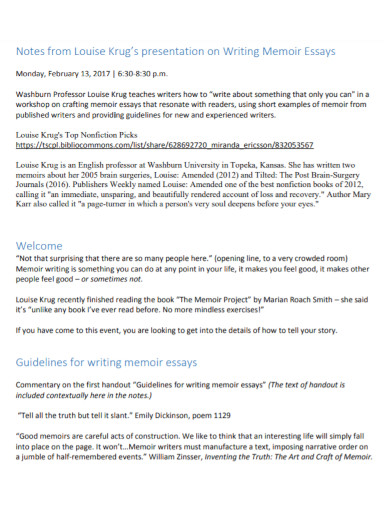
Size: 492 KB
2. Visual Memoir Project Essay
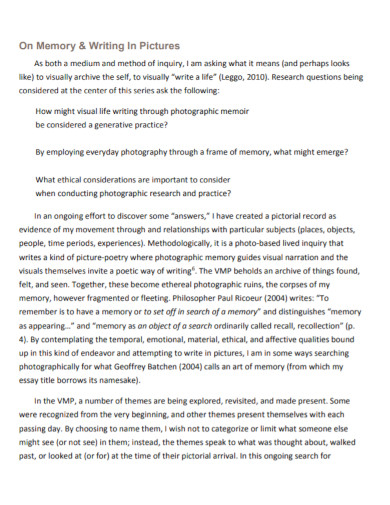
3. Narrative Memoir Essay
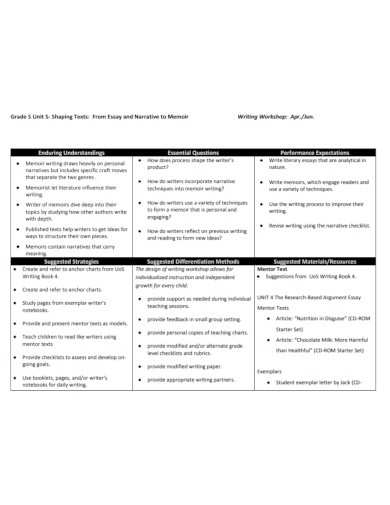
Size: 463 KB
4. Example of Memoir Essay
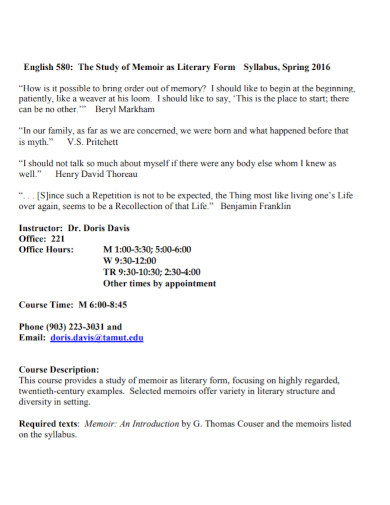
Size: 171 KB
5. Essay on the Memoir Literary Genre
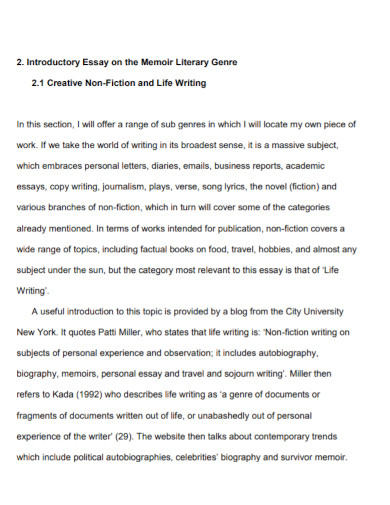
6. Mexicana-Chicana Memoir Essay
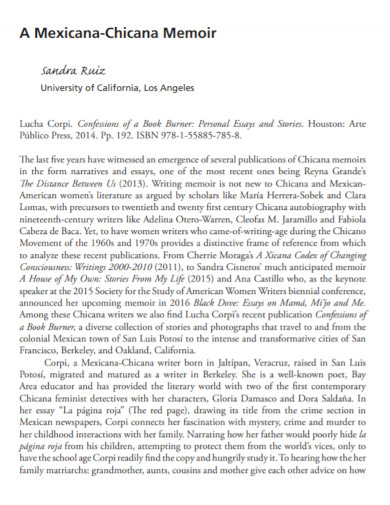
Size: 74 KB
What is a Memoir?
A memoir is taken from the French word mémoire which means memory or something to reminiscent. A memoir is a nonfiction narrative that talks about the situations in your life that you want to hold on too. A memoir is different from an essay since the person reading the memoir is taken back to a journey of the author’s life while an essay is a writer’s thoughts and ideas.
What is a Memoir Essay?
A memoir essay is a type of writing where you put both your thoughts and ideas as well as your desired memories together. It is also known as an essay length adaptation of a memoir . The word count ranges from 1,000/2,000 words to 8,000 or 10,000 words. Nothing more, nothing less. Your memoir essay is different from your autobiography. You are not going to write your whole life story, but some snips of your life story.
How to create a Memoir?
Although there are some ways in creating such a beautiful memoir, sticking to the facts is better than making things that do not belong or you have not experienced a part of it to make it sound better. The result is, it is no longer considered a memoir but an essay since you are only sharing your thoughts and not the actual facts. However, there are easy steps you can read to know and understand how to write the perfect memoir.
Think Of What Theme You Are Going For.
Brainstorming what theme you are going for is essential when writing your memoir. Your theme could range from happy or sad. The theme is important in your memoir.
Identify and Write Down Your Memories.
Brainstorm. The second thing you can do is to brainstorm for memories you wish to write down. From your earliest memories to your most recent ones, especially those that gave you the biggest impact on your life.
Your memoir must be truthful.
This is a big deal when it comes to writing your memoir, since this is about you and your special memories. Adding somebody else’s experience to make your memoir sound better is wrong and should be avoided at all costs.
Connect each memory to your current ones, and don’t be afraid to get vulnerable.
Interconnecting your previous memories to your current ones is okay. Some memories often interlink. Also, when writing, do not be afraid to get vulnerable. Readers often relate more if the author gets on to their level of vulnerability.
Write a memoir you want others to remember you for.
When writing, we often want to think about the rules, the formats, how we want our readers to view it. But remember, this is your memoir. Write the facts, write about your memories but do so while having fun. Let your readers be a part of your story. Draw them in. Let them dive in and see how you are viewed in their eyes.
Put life in your memoir.
Readers would love to hear you laugh, to see you smile, to sympathize with you when you are sad through your words. They want to be in your shoes through words. To view your experiences through your eyes.
What is the difference between a memoir and a memoir essay?
A memoir in layman’s terms is like a big open diary you let people read. You write the memories that affected you most from the beginning to present. A memoir essay however is an essay adaptation of a memoir. There is very little difference between the two.
How many paragraphs does it take to write a memoir essay?
It only takes about 2 to 4 paragraphs to write your memoir essay or half a page long.
Writing a memoir essay may take a while and some trial and errors, but as long as you stick to the simple rules on how to write a memoir essay, you are all set. Just remember to look at the rules and to have fun while sticking to the facts as well.
Memoir Essay Generator
Text prompt
- Instructive
- Professional
Write about a pivotal moment in your life for your Memoir Essay.
Discuss the impact of a significant relationship in your life in your Memoir Essay.
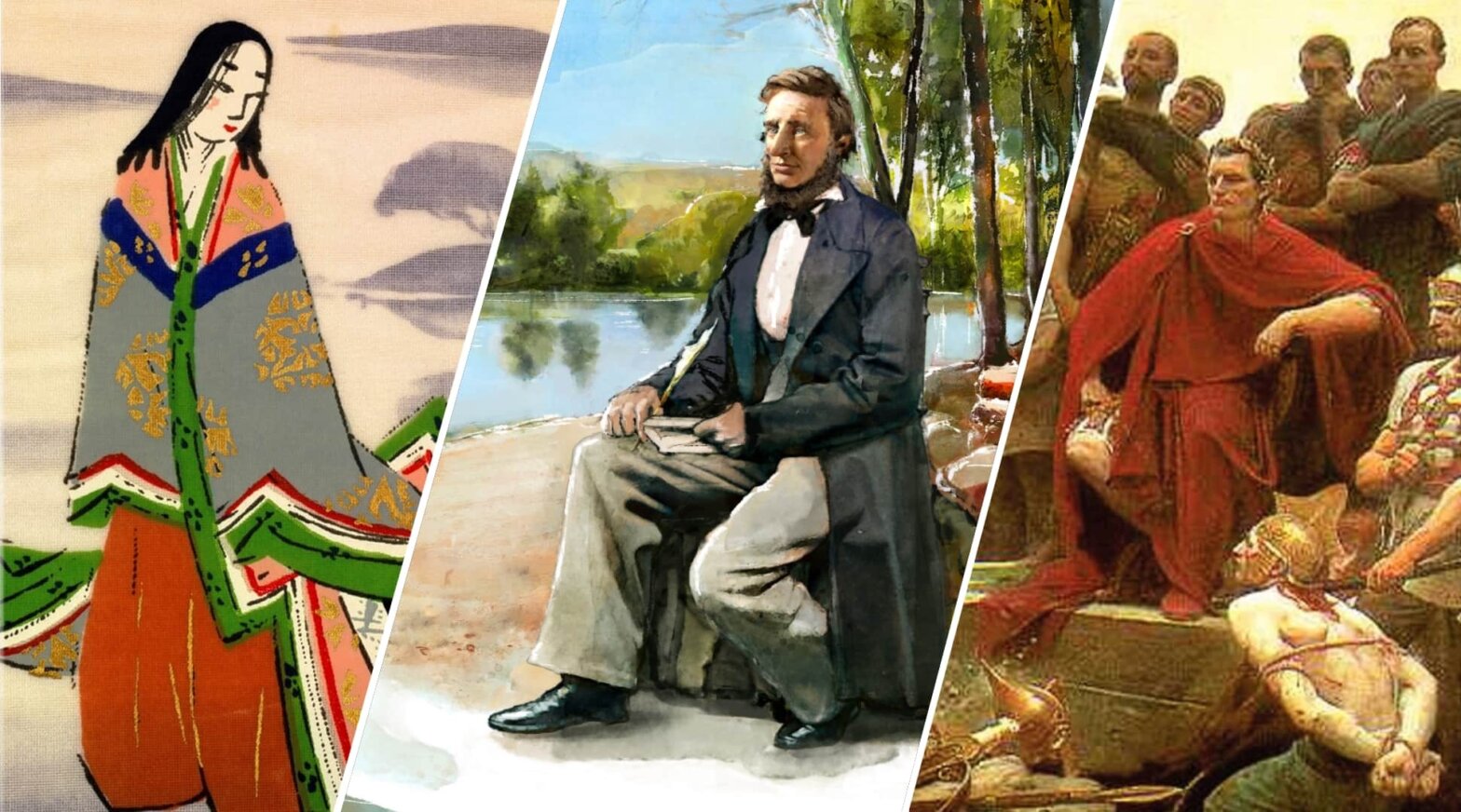
- Scriptwriting
What is a Memoir — Definition, Examples in Literature & Film
M ost movies tell a story with a beginning, middle, and end. Many of those narrative features tell the story of a single individual that can span a certain amount of time, ranging from a few days to a few decades. Some of those focused narrative movies are also memoirs, which can include original and adapted screenplays. But what is a memoir and how can you identify one?
Memoir Definition
Let's define memoir.
Autobiographies are fairly common and known quantities in the world of literature. Memoirs are, too, but they are not as broad as autobiographies tend to be. This is key to understanding a memoir vs autobiography and how they tell their stories, which we go over below in our memoir definition.
MEMOIR DEFINITION
What is a memoir.
A memoir is a non-fiction story set in the author’s past during a specific period of their life. The name “memoir” comes from “memorie/memoria/memory,” as memoirs are essentially reminiscences of the author. A memoir is told completely through the author’s point of view. This means that facts can be embellished, with an emphasis on feelings and emotions.
Memoir Characteristics:
- Narrative tales set in a character’s past
- Stories set during a short period of time (as opposed to a lifetime)
- A greater emphasis on feelings, emotions, and perspectives versus factual storytelling
Memoir Meaning
History with examples.
Writing memoirs used to be something only a privileged few were able to indulge in, as they had the time and money to sit around and reminisce. Julius Caesar’s Commentaries on the Gallic Wars and Commentaries on the Civil War are two very early memoir examples, with Caesar writing about the two respective wars, how they went, and his role in them.
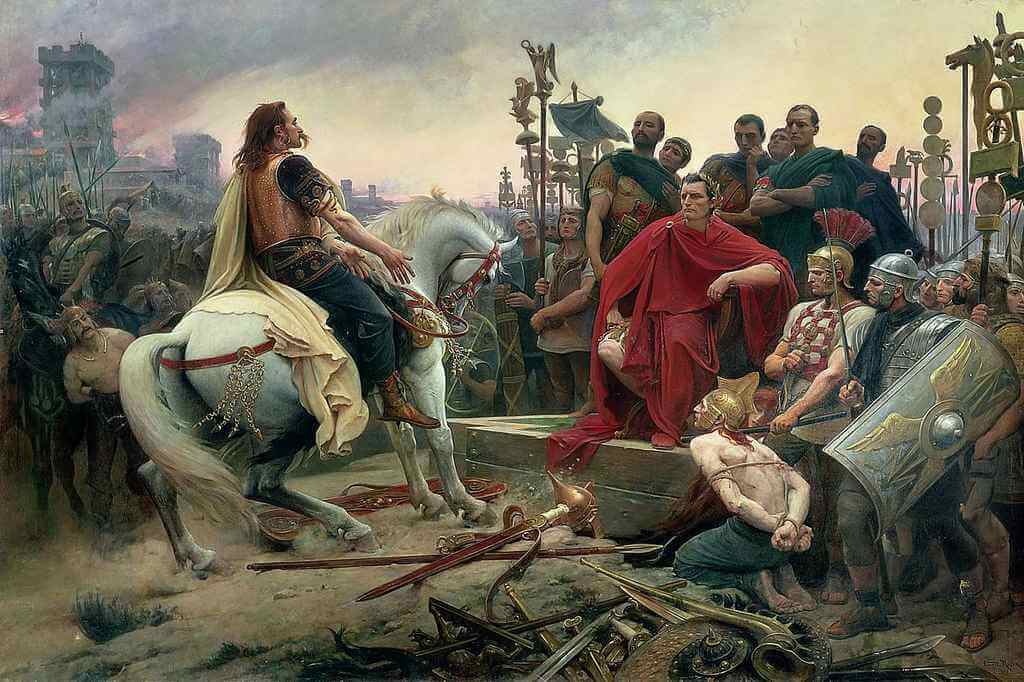
While serving as memoirs, they also serve as historical records, which is something many other memoirs end up being. Thus, in these early examples, we can see both the personal and historical reasons for jotting down one’s specific memories.
As time went on, other people, be them important politicians or simply chroniclers of their era, were writing memoirs. Some of these included Sarashina Nikki of the Japanese Heian period (8th to 12th century); there were also several European memoir examples from the Middle Ages to the Renaissance .
The 18th and 19th centuries brought us closer to what we could consider more modern examples of memoirs. While these centuries were full of memoirs written by privileged politicians or aristocrats, there was at least one that broke the mold a bit.
Henry David Thoreau’s Walden is one of the most popular and well-known memoir examples in literature. Focusing on the two years, two months, and two days the author spent in a cabin, the memoir has Thoreau cover many subjects. These include living on your own to identifying plant life around him, among many other things.
You can learn more about who Thoreau was in the video below.
What is a memoir • Henry David Thoreau's memoir meaning
As access to writing materials and typing increased, and as the world became a bit more modern, more “regular” memoirs started to pop up. This was especially true during some of our darkest times, specifically the two world wars. From these great wars came memoirs from soldiers, victims, and survivors, including those in the trenches of World War I or in the concentration camps of World War II.
Closer to the 21st century, memoirs became even bigger as normal everyday people began jotting down their memories. In many cases, these memories were to preserve the history of a person or their family, as they would otherwise be lost without being written down.
In other cases, memoirs have served as forms of expression from the individual writers, detailing events in their life and the impact it had.
Related Posts
- What is an Adapted Screenplay? →
- The Best Book-to-Film Adaptations →
- How to Develop and Write a Script Adaptation →
Memoir Examples
Memoir vs. autobiography.
Reading the memoir definition, you may be wondering what exactly makes it different from an autobiography. Both are just chatting about yourself, right?
Both forms may indeed be chatting about oneself, but there is a difference between a memoir and an autobiography. A memoir is a look at a specific period from the writer’s life, or a sequence of specific periods that have thematic links. An autobiography, meanwhile, is the writer’s entire life (up until writing, of course).
Autobiographies also tend to be more rigorously fact-checked, while a memoir can be a bit more fast and loose with the facts as the writer weaves a story.
Of course, there are exceptions to this rule; sometimes an autobiography has some elements that aren’t totally truthful, but that’s usually frowned upon.
While they’re distinct in definition, the two terms occasionally overlap since their qualifications are a bit subjective.
Types of Memoirs
Because “memoir” is a pretty general term, there are many different ways the writing style can manifest. Over the years, a few categories for the genre have cropped up, though there are various schools of thought on the subject.
Personal Memoir
When you think of a memoir, this is probably the type that comes to mind. In this memoir, an author tackles a formative, personal experience from their life.
“I was small-boned and skinny, but more than able to make up for that with sheer meanness.”
— Mary Karr, The Liar's Club
There’s no limit to what this experience could be, but examples may be meeting a first love, enduring an illness, or navigating a relationship with a parent.
Portrait Memoir
With a portrait memoir, the subject is someone other than the author. Of course, the memoir is still through the eyes of the author, and they probably play a big role in the narrative, but the real focus lies with someone else.
“My father had lost most of the sight in his right eye by the time he’d reached eighty-six, but otherwise he seemed in phenomenal health for a man his age when he came down with what the Florida doctor diagnosed, incorrectly, as Bell’s palsy…”
— Philip Roth, Patrimony
This might be a parent (the amount of memoirs about parents, particularly complicated dads, could fill the Pacific Ocean), a best friend, a sibling, a teacher — really anyone who the author knows intimately. The film Aftersun loosely falls into the Complicated Dad subcategory of the portrait memoir.
Political Memoirs
This memoir is usually written by, you guessed it, politicians. It can be a personal memoir in form, but often with the larger goal of ingratiating themselves to the reader to get their vote or support their platform.
“Of all the rooms and halls and landmarks that make up the White House and its grounds, it was the West Colonnade that I loved best.”
— Barack Obama, A Promised Land
Political memoirs can also be written by people who aren’t politicians but are trying to further a political goal, like an activist. Some political memoir examples: Che Guevara's The Motorcycle Diaries , Michelle Obama’s Becoming , or Tony Blair’s A Journey .
Public Memoir
This type of memoir is a bit similar to the political memoir because it’s written by a person who’s already famous. But the public memoir usually doesn’t have a political ax to grind (at least, that’s not a requirement), it’s just a memoir by someone who’s well-known.
“Plainly, due to my high and solitary place in the world—am I not the Living Buddha (0r is that Richard Gere?)—and to my cold nature and to my refusal to conform to warm mature family values, I am doomed to be the eternal outsider…”
— Gore Vidal, Palimpsest
This celebrity will write about being famous and hanging out with other famous people, and they’ll make the GDP of a small country in book sales.
Travel Memoir
People like traveling, but it’s expensive and usually exhausting. So sometimes, we prefer to read about someone else who’s spending the money and traveling around the world.
“When you’re traveling in India—especially through holy sites and Ashrams—you see a lot of people wearing beads around their necks.”
— Elizabeth Gilbert, Eat, Pray, Love
A travel memoir can take a lot of different forms, but there’s one constant: the writer is moving around.
Writing Memoirs
How to write a memoir.
If these categories didn’t already make it clear, there’s no one way to write a memoir. It can be a straight-forward narrative or an avant-garde collection of scenes. But, hey, a few helpful tips can’t hurt.
You can learn a bit more about writing memoirs in the video below.
How to write a memoir
Know the “why”.
The most important question to ask yourself when you’re about to write the next great memoir is, “Why will people care about this?” If you don’t have a good answer, you may be writing a journal entry — which is totally fine; journaling is great and important in its own right.
But with a memoir, it’s crucial to have a greater purpose. This personal story may mean a lot to you (and if it doesn't, why are you writing it down at all?). But if someone doesn’t know you, why should they care that your sophomore year girlfriend broke up with you because she didn’t believe in your dream of becoming the premiere soft serve ice cream provider of Illinois?
There are many reasons a reader might care. Maybe your story in a larger sense is about young love and big dreams — we can all relate to that. Maybe the story is filled with drama: she broke up with you by pushing you into a vat of soft serve extract, and you spent months trying to get the solution out of your hair. Or maybe you’re the founder of Dairy Queen, and this is a glimpse into how it all started.
Beginning, Middle, End
It may seem obvious, but this fundamental rule of storytelling can be tricky when writing a memoir. The nature of a memoir means that there is going to be a story before and after the memoir ends.
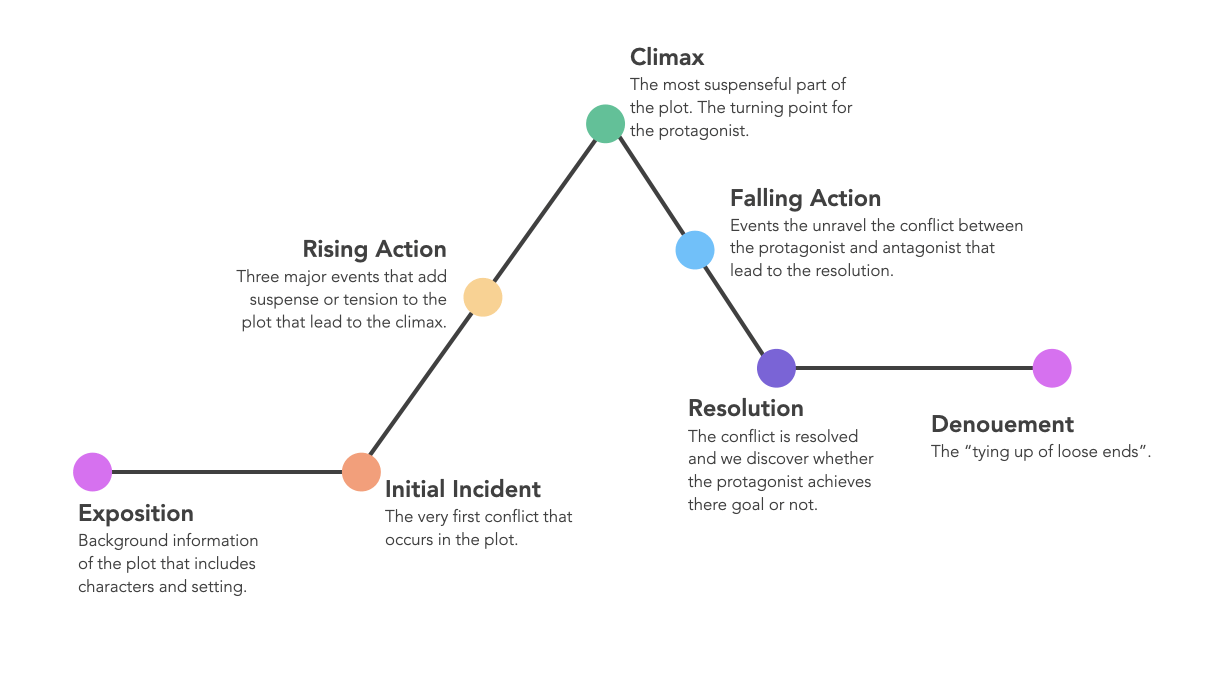
My story goes something like this…
There’s no one way to find the beginning and end points of your memoir, but primarily, this should be rooted in the first piece of advice: have you achieved the “why”? If so, end it.
Don’t Get Stuck on Facts
This doesn’t mean lie. But if you feel the need to inform the reader of every detail of the story, it’s going to become a pretty dull read. It might all be true, but the “why” will have left the building.
Life doesn’t work in story arcs — things are messy, beginnings aren’t really beginnings and ends aren’t really ends. Of course, you want your memoir to reflect that to a certain extent, but you also want it to be readable. So omitting facts and cleaning up narrative elements (even if it’s not the complete and total truth) becomes crucial to the memoir style. The truth lies in the grand strokes, the emotions and characters.
Memoir Movies
Memoirs in cinema.
Memoirs have definitely been around longer than cinema, but movies about people and their lives (specifically biographies, aka biopics ) have been pretty common since the medium’s inception. Some of these movies could even count as memoir-esque, like Young Mr. Lincoln (1939), which, instead of chronicling Abraham Lincoln’s tenure as president (or his entire life), examines his time as a lawyer in the 1830s.
What is a memoir • Young Mr. Lincoln
So while there have been plenty of biographies, many of the most well-known movies based on memoirs have been fairly recent. One of the most high profile of these is Eat, Pray, Love , a 2006 memoir by Elizabeth Gilbert that turned into a 2010 movie starring Julia Roberts.
Eat, Pray, Love • A pinnacle in memoir movies
But even before that we had Girl, Interrupted , a 1993 memoir by Susanna Kaysen which made it into a film in 1999 starring Winona Ryder and Angelina Jolie. The opening lines of the film even retain the memoir feel.
Take a look at them below, with the script that we imported into StudioBinder’s screenwriting software .
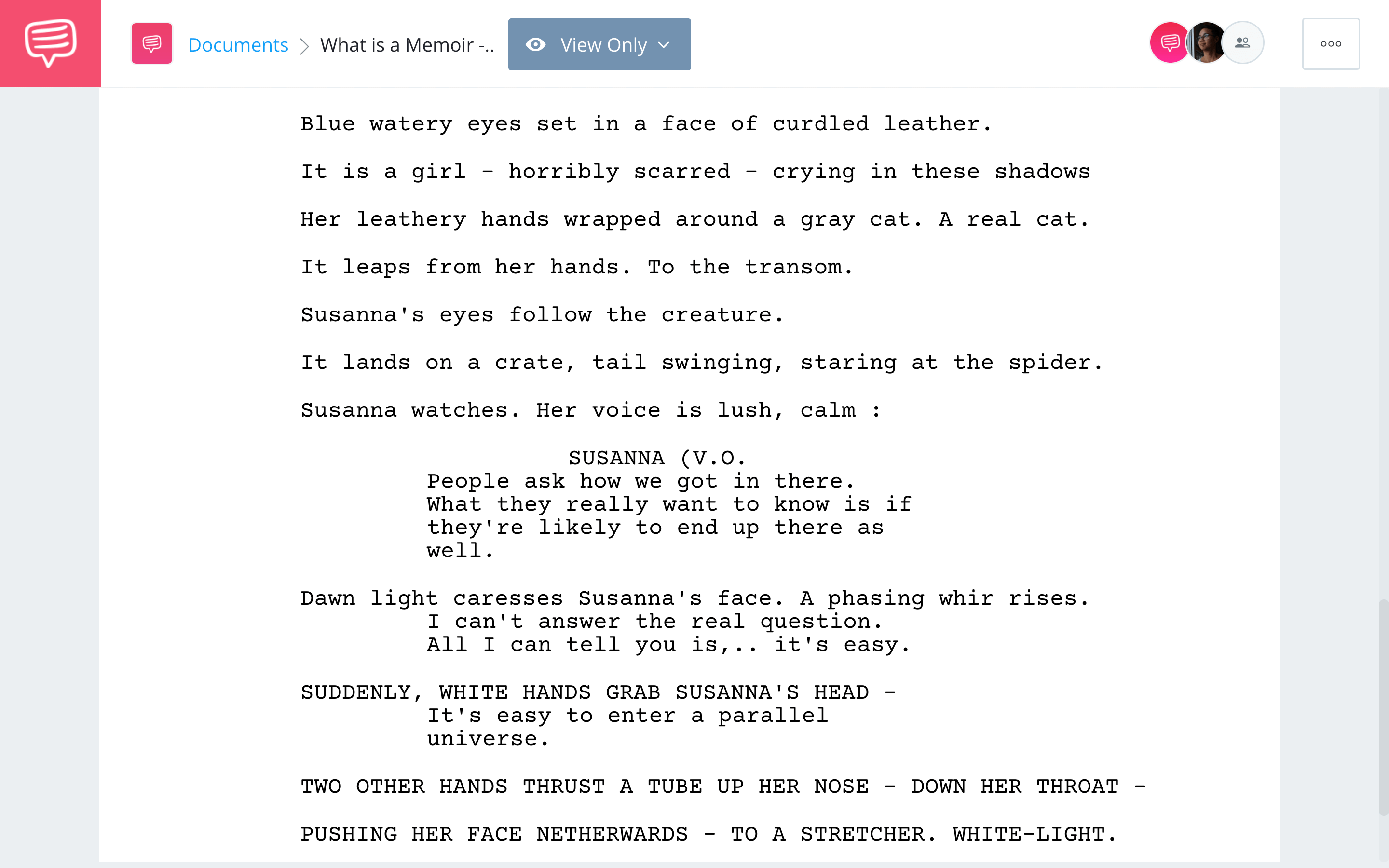
Girl, Interrupted • Read the entire opening
The voiceover feels like Kaysen answering the “why do we care” question that we outlined in our tips section.
And then of course there was The Basketball Diaries , a Jim Carroll memoir from 1978 that turned into a Leonardo DiCaprio movie in 1995. Here's the opening scene and credits.
Memoir movies • The Basketball Diaries
From 2009’s Julie & Julia (based on two separate memoirs) to The Theory of Everything 2014’s (the Stephen Hawking memoir written by his wife Jane Hawking) to 2018’s Beautiful Boy (based on two memoirs about the same subject), there has been no shortage of memoir based films in the last two decades.
Memoir movies • The Theory of Everything
Some are more successful and acclaimed than others, but like novels, there are plenty out there for filmmakers to adapt. And don’t forget there are also movies based on true events that weren’t chronicled in memoirs before, so if you want to adapt a moment in your life as a script for a movie, go for it.
How to Write an Adaptation
Now that we have covered memoirs and movies based on memoirs, it’s time to look at how you might go about adapting one. We cover the step-by-step process of adapting a book for the screen, all with examples and even some quotes.
Up Next: Writing an Adaptation →
Showcase your vision with elegant shot lists and storyboards..
Create robust and customizable shot lists. Upload images to make storyboards and slideshows.
Learn More ➜
T he sitcom has been a staple of television for nearly 80 years. need a tight APP intro here that transitions to below..
The XYZ Script
Click to view and download the entire XYZ script PDF below.
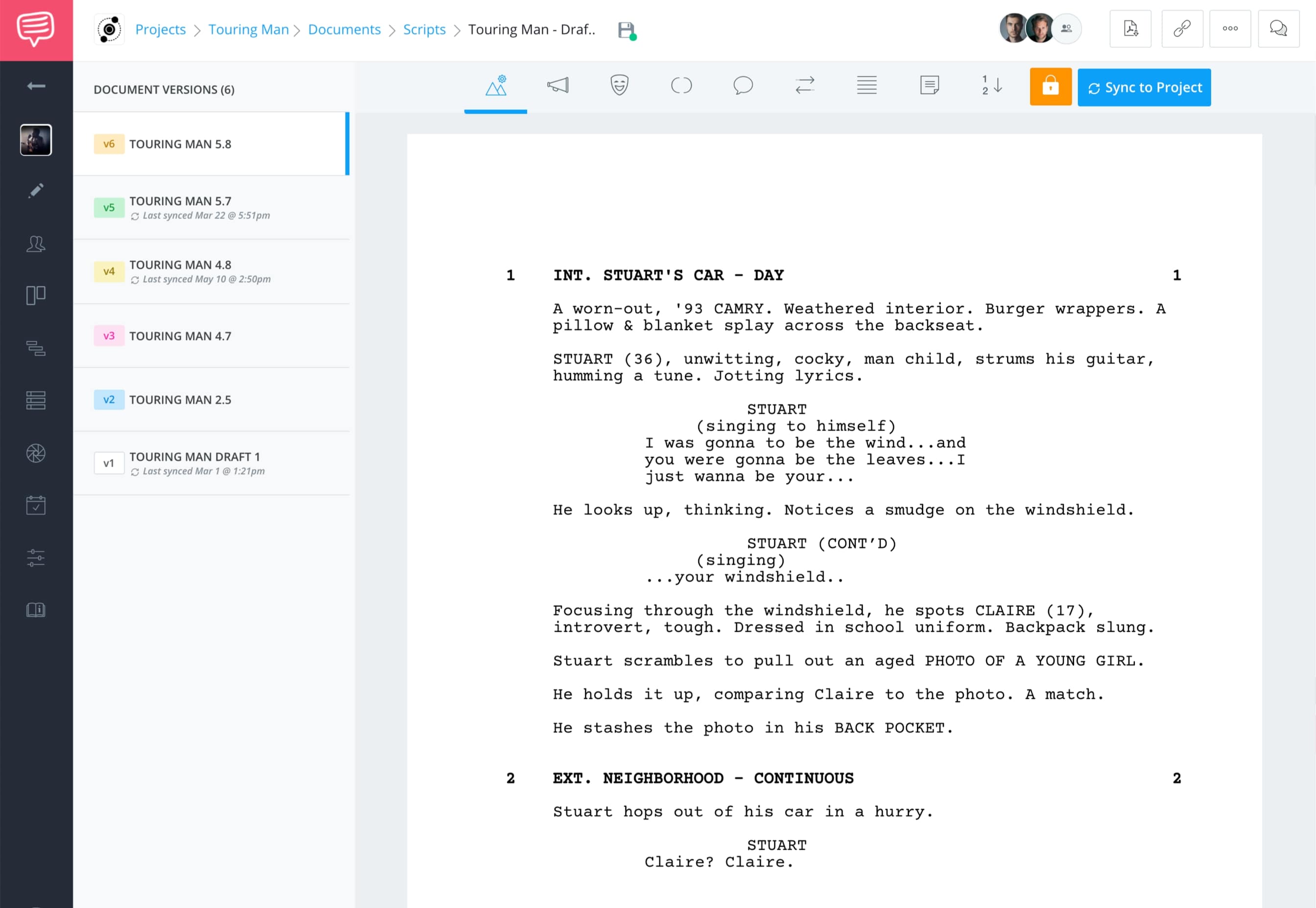
Click above to read and download the entire XYZ script PDF
WHO WROTE THE XYZ SCRIPT?
Written by jonathan nolan, chris nolan, and david s. goyer.
VERY short bio about the screenwriter and a bit of history or trivia about this script. Perhaps the awards, accolades, or careers it's launched. This adds credibility and importance to the whole post. The image to the left should be swapped out with a SQUARE cropping of an image of the writer (400px compressed JPG). Make sure it's a polished photoshoot image like the one of Chazelle here. Cap this block at 10 lines.
Story beats in the XYZ script
Marshmallow pie sweet roll gummies candy icing. Marshmallow pie sweet roll gummies candy icing.Marshmallow pie sweet roll gummies candy icing. Marshmallow pie sweet roll gummies candy icing.
Script Teardown
Script structure of "movie title", 1. exposition (beginning).
Write a brief description here. Try to keep this approximately 2-3 sentences or about 15-30 words.
2. INCIDITING INCIDENT
3. climax of act one, 4. obstacles (rising action), 5. midpoint (big twist), 6. disaster & crisis, 7. climax of act two, 8. climax of act three, 9. obstacles (descending action), 10. denouement (wrap up), 11. resolution, xyz script takeaway #1, writing style / unique execution / or searched scene.
This section will be a scene study of something novel. It could be an example of a general writing style, or unique execution, formatting of something specific (e.g. pre-laps, musical sequences, suspense, twist reveals, etc), dialogue scene. If, in your SEO research you find people searching for a particular scene, then that's a hint it should become a scene study section and keyword used in the heading.
You can have anywhere from 1-3 sections like this in the post.
Embed the video from Youtube and set it up, letting the reader know what to focus on in the video.
Scene Study: Tommy buys a dozen red roses
After the embed, set up the script tie-in. Call out what they should focus on and provide a good reason on why they should click the app tie-in. In many cases this would be to read the entire scene. In other cases, you could add something clever in the comments or script notes, or versions.
Also, since the app link opens a script at Scene 1, you'll want to let them know what scene number they should scroll down to.
Read the Flower Shop Scene — Scroll to Scene XX
Marshmallow pie sweet roll gummies candy icing. Marshmallow pie sweet roll gummies candy icing. I love candy canes soufflé I love jelly beans biscuit. Marshmallow pie sweet roll gummies candy icing.
Marshmallow pie sweet roll gummies candy icing. I love candy canes soufflé I love jelly beans biscuit. Marshmallow pie sweet roll gummies candy icing.
- Start breaking down your script →
- Learn how to analyze and break down a script →
- FREE Download: Script Breakdown Sheet Template →
Setup the next logical script for this reader to review. Keep in mind the style, genre, and writer of the above script. For example, a Tarantino script should have an Up Next to another Tarantino script (ideally), or another pulp-y script (e.g. Lock, Stock, and Two Smoking Barrels), or a similar genre, or dialogue-heavy script by another relevant auteur (e.g. PT Anderson).
Up Next: Article Name →
Write and produce your scripts all in one place..
Write and collaborate on your scripts FREE . Create script breakdowns, sides, schedules, storyboards, call sheets and more.
Leave a comment
Your email address will not be published. Required fields are marked *
- Pricing & Plans
- Product Updates
- Featured On
- StudioBinder Partners
- The Ultimate Guide to Call Sheets (with FREE Call Sheet Template)
- How to Break Down a Script (with FREE Script Breakdown Sheet)
- The Only Shot List Template You Need — with Free Download
- Managing Your Film Budget Cashflow & PO Log (Free Template)
- A Better Film Crew List Template Booking Sheet
- Best Storyboard Softwares (with free Storyboard Templates)
- Movie Magic Scheduling
- Gorilla Software
- Storyboard That
A visual medium requires visual methods. Master the art of visual storytelling with our FREE video series on directing and filmmaking techniques.
We’re in a golden age of TV writing and development. More and more people are flocking to the small screen to find daily entertainment. So how can you break put from the pack and get your idea onto the small screen? We’re here to help.
- Making It: From Pre-Production to Screen
- What is Film Distribution — The Ultimate Guide for Filmmakers
- What is a Fable — Definition, Examples & Characteristics
- Whiplash Script PDF Download — Plot, Characters and Theme
- What Is a Talking Head — Definition and Examples
- What is Blue Comedy — Definitions, Examples and Impact
- 0 Pinterest

IMAGES
VIDEO
COMMENTS
Examples. Walden by Henry David Thoreau. In July of 1845, Henry David Thoreau walked into the woods and didn't come out for two years, two months, and two days. This is the seminal memoir that resulted. Into Thin Air: A Personal Account of the Mount Everest Disaster by Jon Krakauer.
1 - Memoir examples of early life stories. Early life memoirs explore the foundational years that shape individuals, offering a deep dive into the experiences and influences that forge character, resilience, and perspective. These memoirs are a testament to the lasting impact of youth on personal growth and identity.
7. How to Write a Memoir: Edit, edit, edit! Once you're satisfied with the story, begin to edit the finer things (e.g. language, metaphor, and details). Clean up your word choice and omit needless words, and check to make sure you haven't made any of these common writing mistakes.
What exactly are short memoirs? I define them as essay-length works that weave together life experiences around a central theme. You see examples of short memoirs all the time on sites like Buzzfeed and The New York Times. Others are stand-alone pieces published in essay collections. Memoir essays were my gateway into reading full-length memoirs.
2. The Glass Castle by Jeanette Walls. Resilience and redemption co-star in this bestseller about Jeanette Walls' life. 3. The Hiding Place by Corrie Ten Boom. An evangelist and survivor of Hitler's concentration camps, the life of Corrie Ten Boom stands among the best memoir examples. 4.
8- "Bossypants" by Tina Fey: Tina Fey's funny writing memoir Night is full of stories from her life and work in the entertainment business. "Bossypants" is funny and deep about gender roles, how the workplace works, and how hard it is to balance work and children. This book is fun and thought-provoking, thanks to Fey's honesty and ...
Also set weekly milestones. In addition to your final deadline, I recommend breaking up the writing process into weekly milestones. If you're going to write a 65,000-word memoir over 100 days, let's say, then divide 65,000 by the number of weeks (about 14) to get your weekly word count goal: about 4,600 words per week.
5. Employ Elements of Fiction to Bring Your Story to Life. 6. Create an Emotional Journey. 7. Showcase Your Personal Growth. Memoir Examples as Inspiration. Examples of Memoirs that Use an Effective Structure. Examples of Thematic Memoirs.
Steer clear of self indulgence. 5. Seek Outside Perspectives. Typically it's good to write a first draft of your memoir, take a few days off, read it back to yourself, and then dive into a second draft. Once you've completed the second draft, however, it's time for outside eyes.
Here are some writing tips to keep in mind as you dive into the first draft of your memoir essay: 1. Pay attention to those memories that keep coming back to you. Even if you don't know why a memory may be significant, the fact that you keep thinking of it means there's probably a great story worth exploring there. 2.
While the personal essay has enjoyed continued popularity, a book-length collection of linked essays, centered on an author's self or life, is less common than a traditional memoir or novel. A truly successful essay collection can reveal the author processing experiences at many different points in time and through many different lenses. As a writer, […]
The Glass Castle by Jeannette Walls. Brain on Fire by Susannah Cahalan. Irritable Hearts by Mac McClelland. The Empathy Exams by Leslie Jamison. Hunger by Roxane Gay. A Sliver of Light by Shane Bauer, Joshua Fattal and Sarah Shourd. 100 more great nonfiction books. Great examples of short memoir essays and personal narrative in creative nonfictio.
Here are 10 phenomenal memoir examples you can read online right now for free. Related: The Best Essay Collections to Add to Your TBR List "Me Talk Pretty One Day" by David Sedaris. Photo Credit: Chris Karidis/Unsplash; ... In his memoir essay, "Darkness Visible," Styron is compelled to speak out about his struggle with mental illness after ...
Writing a memoir can be a meaningful way to reflect on your life's journey and share your unique perspective with people around you. But creating a powerful (and marketable) book from your life's memories — one that can be enjoyed by readers across the world — is no easy task. ... For example, a memoir could be about the time you hiked the ...
Free Memoir Essay Examples. We hope these free memoir essay examples inspire you to embrace the power of storytelling and to celebrate the uniqueness of every life's narrative. Explore the pages of these memoirs to witness the resilience of the human spirit, the complexities of relationships, and the transformative power of personal reflection.
Adding just a bit more here and there. Writing an introduction and a final note to the reader. Two years after I wrote the first "dress story" for a memoir class, the book was published as Reflections: A Wardrobe of Life Lessons. Memoir, like a classic great dress, never goes out of style. Excerpts.
The Writer's Digest Podcast, Episode 10: The Art of the Graphic Memoir. In this episode author and cartoonist Tom Hart shares an inside look at writing and publishing in the graphic novel and comics world. In this interview, they discuss how writers and artists collaborate to create amazing stories, the importance of finding your cohort in ...
Gabrielle Union's memoir-in-essays is a shining example in the sea of celebrity memoirs. She fearlessly shares stories about race, beauty standards, Hollywood, and her own history of sexual assault. The result is moving in many places and laugh-out-loud funny in others. Not everyone can strike the right balance but Union nails it.
Examples of Good Starting Sentences for a Memoir . We've looked at the elements that make memoirs shine. Now, let's turn our attention to one of the most important parts of a personal account: the opening sentence. We've scoured some of the most successful, moving memoirs of all time to curate a list of memorable starting sentences.
A memoir essay is a type of writing where you put both your thoughts and ideas as well as your desired memories together. It is also known as an essay length adaptation of a memoir. The word count ranges from 1,000/2,000 words to 8,000 or 10,000 words. Nothing more, nothing less. Your memoir essay is different from your autobiography.
Memoir examples run the gamut of styles. From classics of literature that tell you about history to popular tell-alls to tear through while sunning yourself on the beach, these books provide something to inform you and delight you. All memoirs are autobiographical tomes that tell someone's life story from her or his own unique perspective. […]
Writing memoirs used to be something only a privileged few were able to indulge in, as they had the time and money to sit around and reminisce. Julius Caesar's Commentaries on the Gallic Wars and Commentaries on the Civil War are two very early memoir examples, with Caesar writing about the two respective wars, how they went, and his role in ...
1 - Start with a story. Begin your memoir with an anecdote. It should be something which connects to the rest of the memoir—if you're writing about your childhood in rural Kentucky, for example, the anecdote should be related to that. It should also connect to the themes you'll explore throughout your memoir.